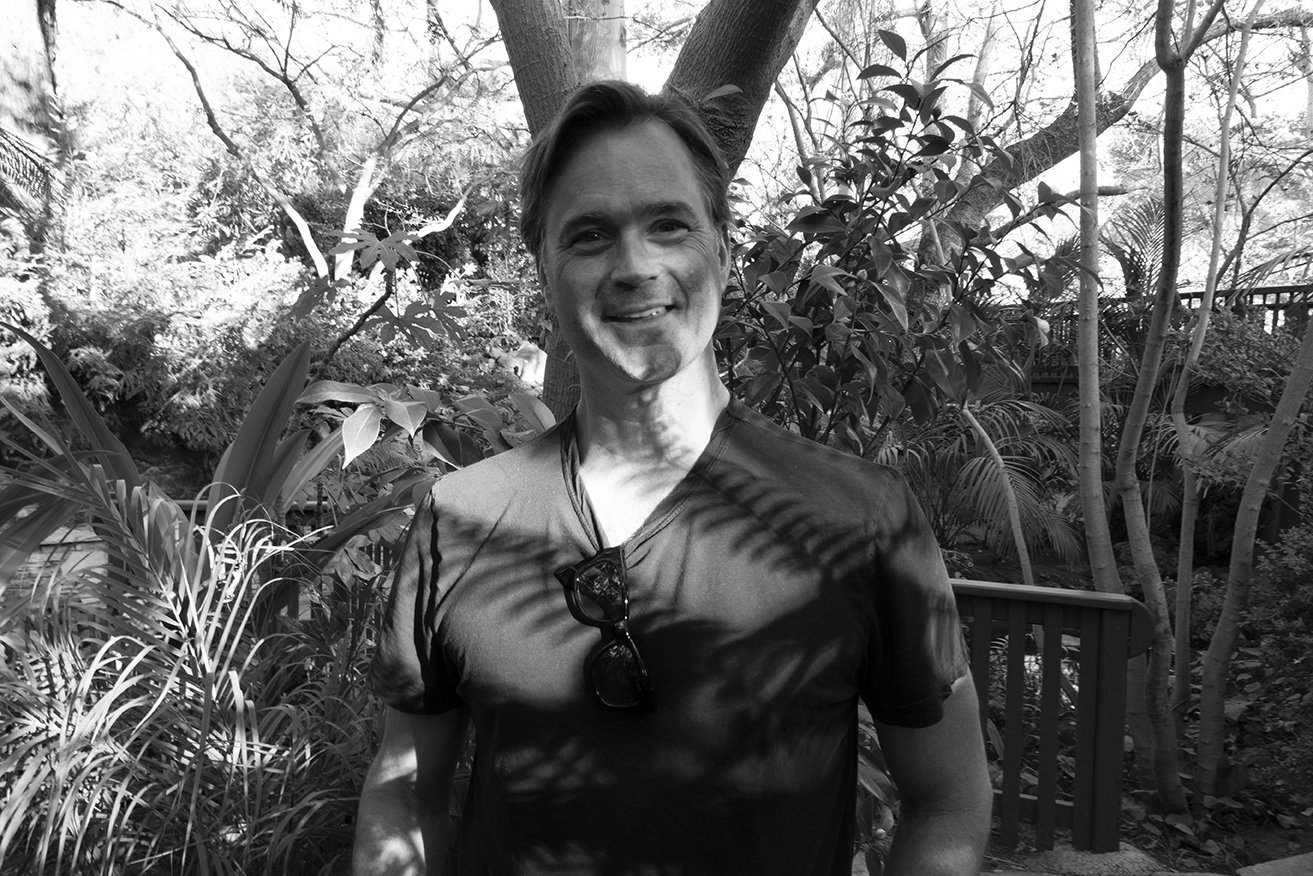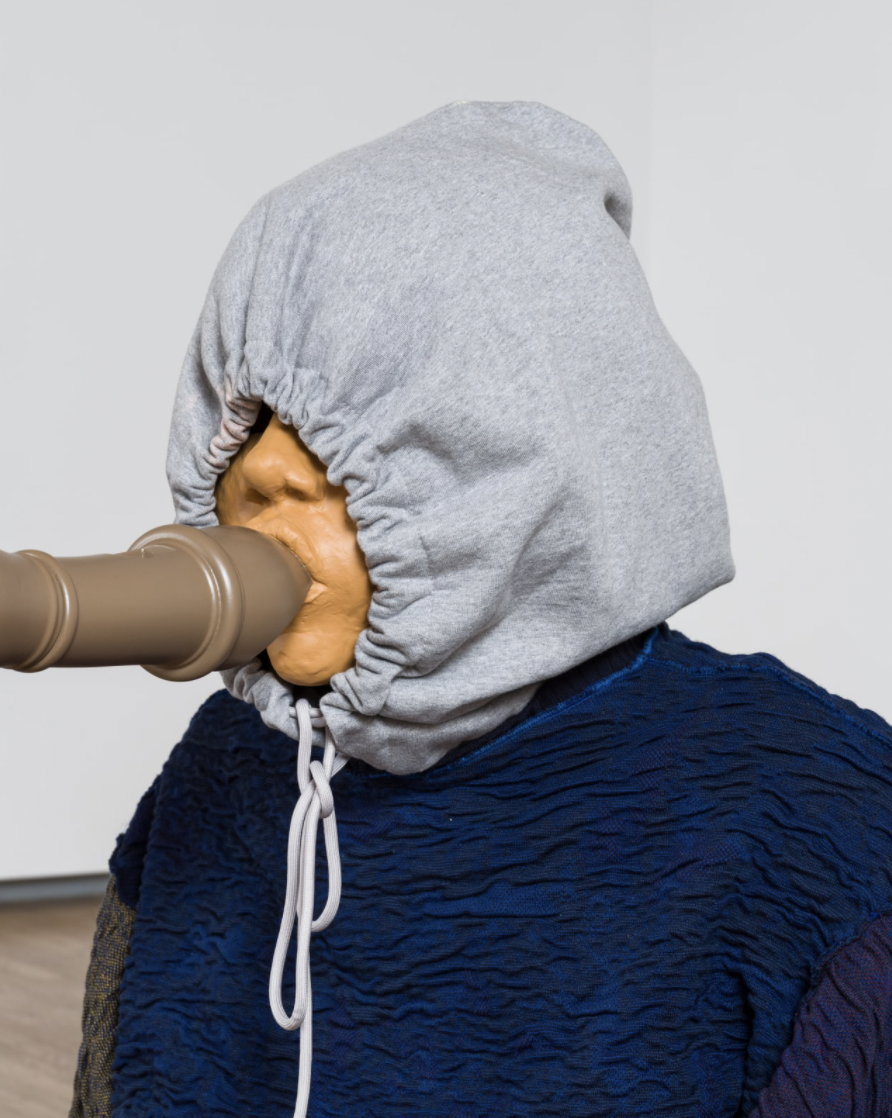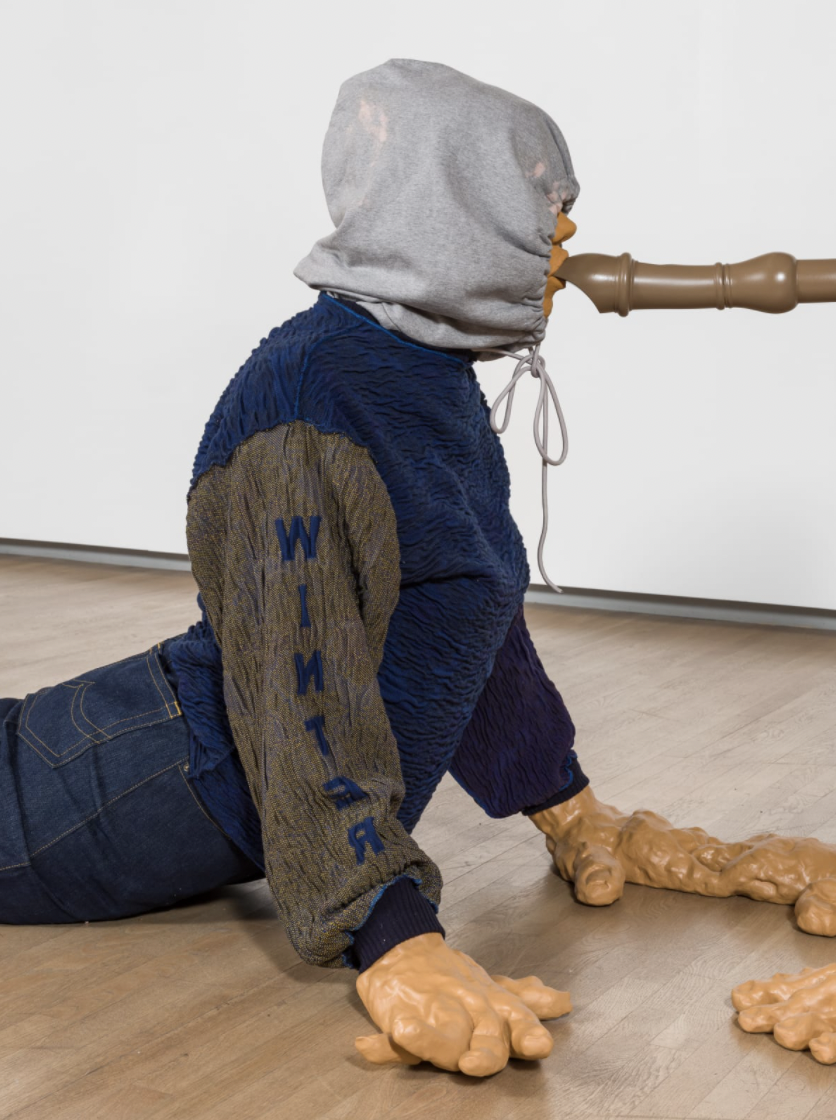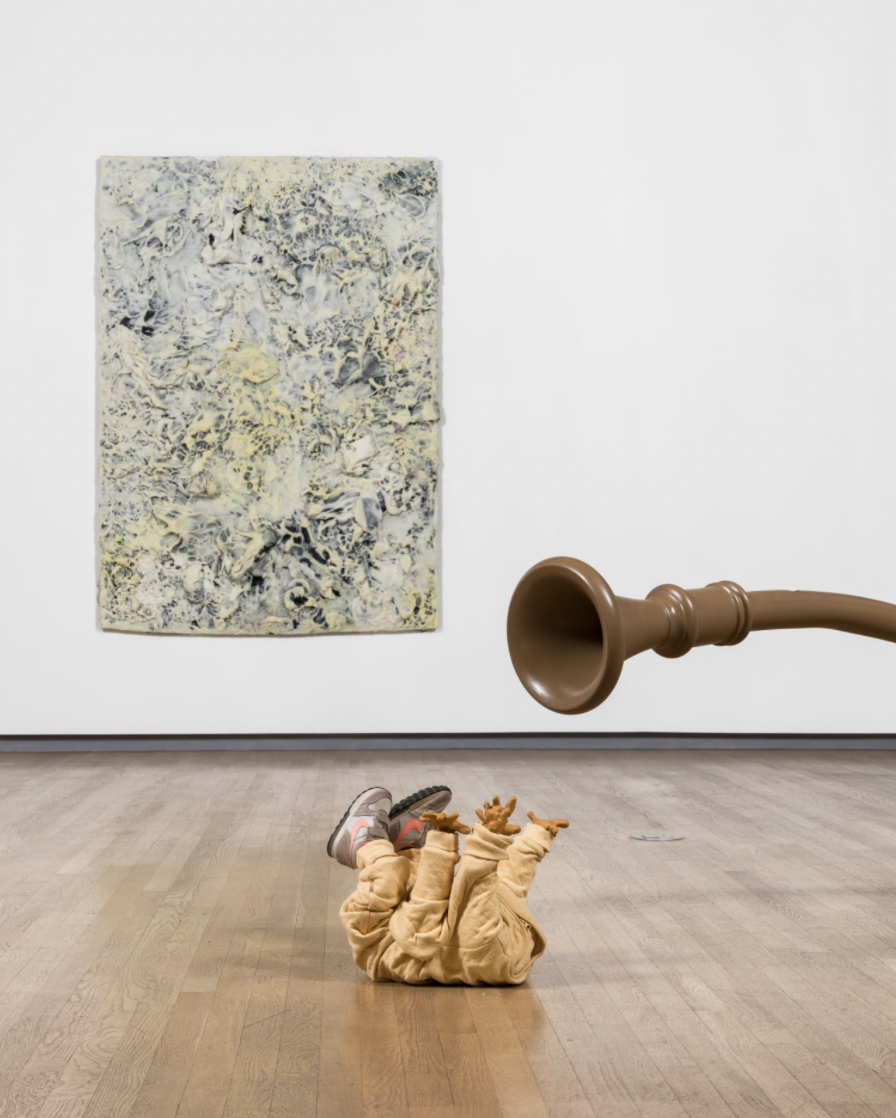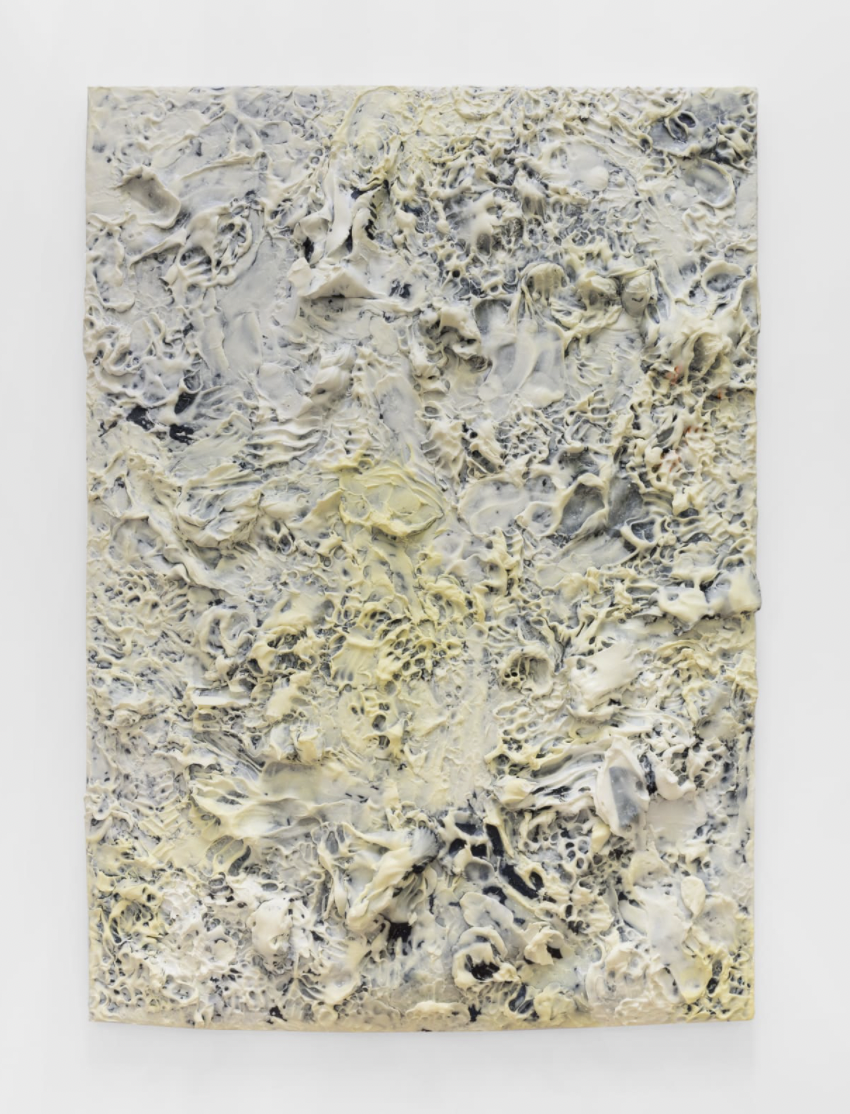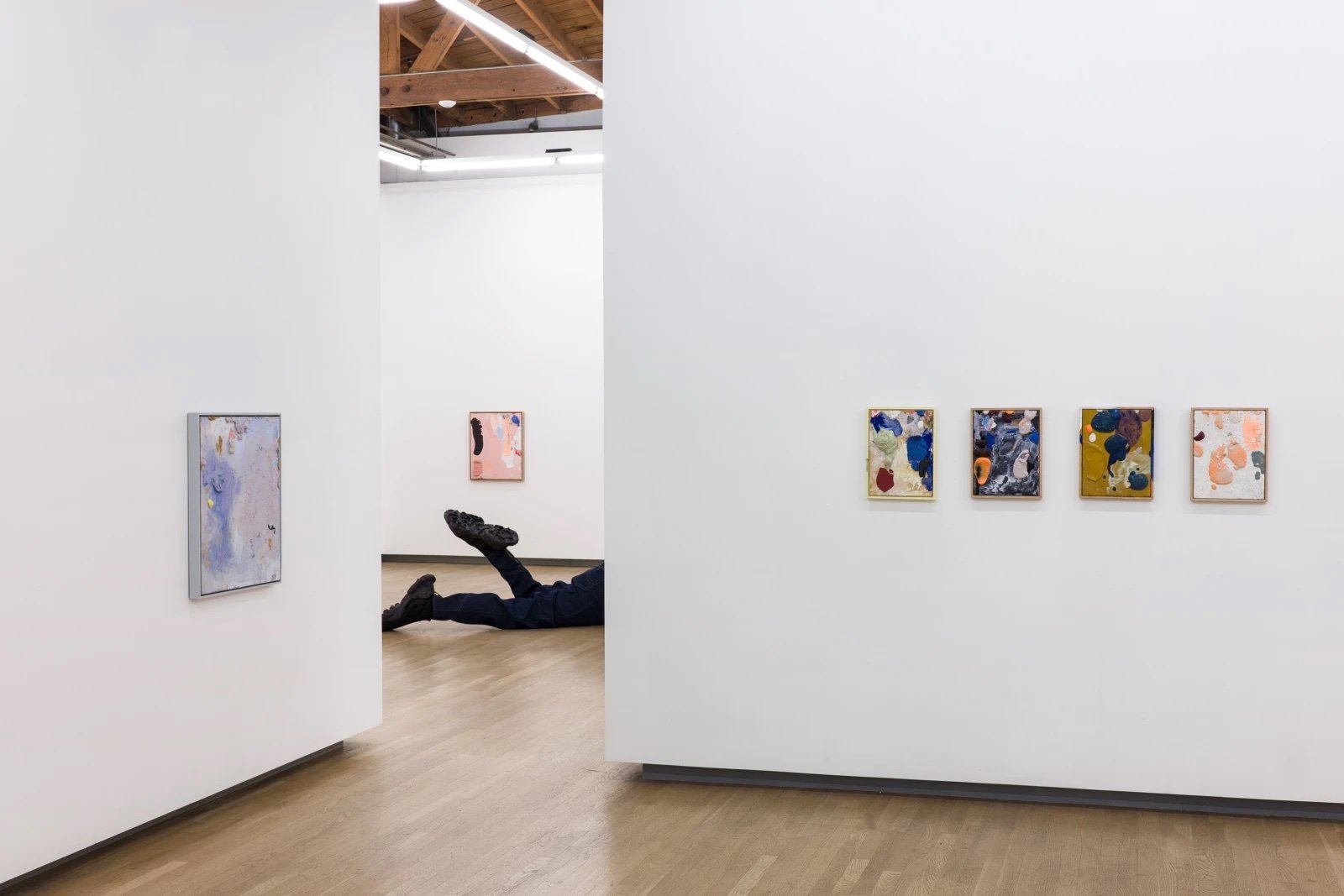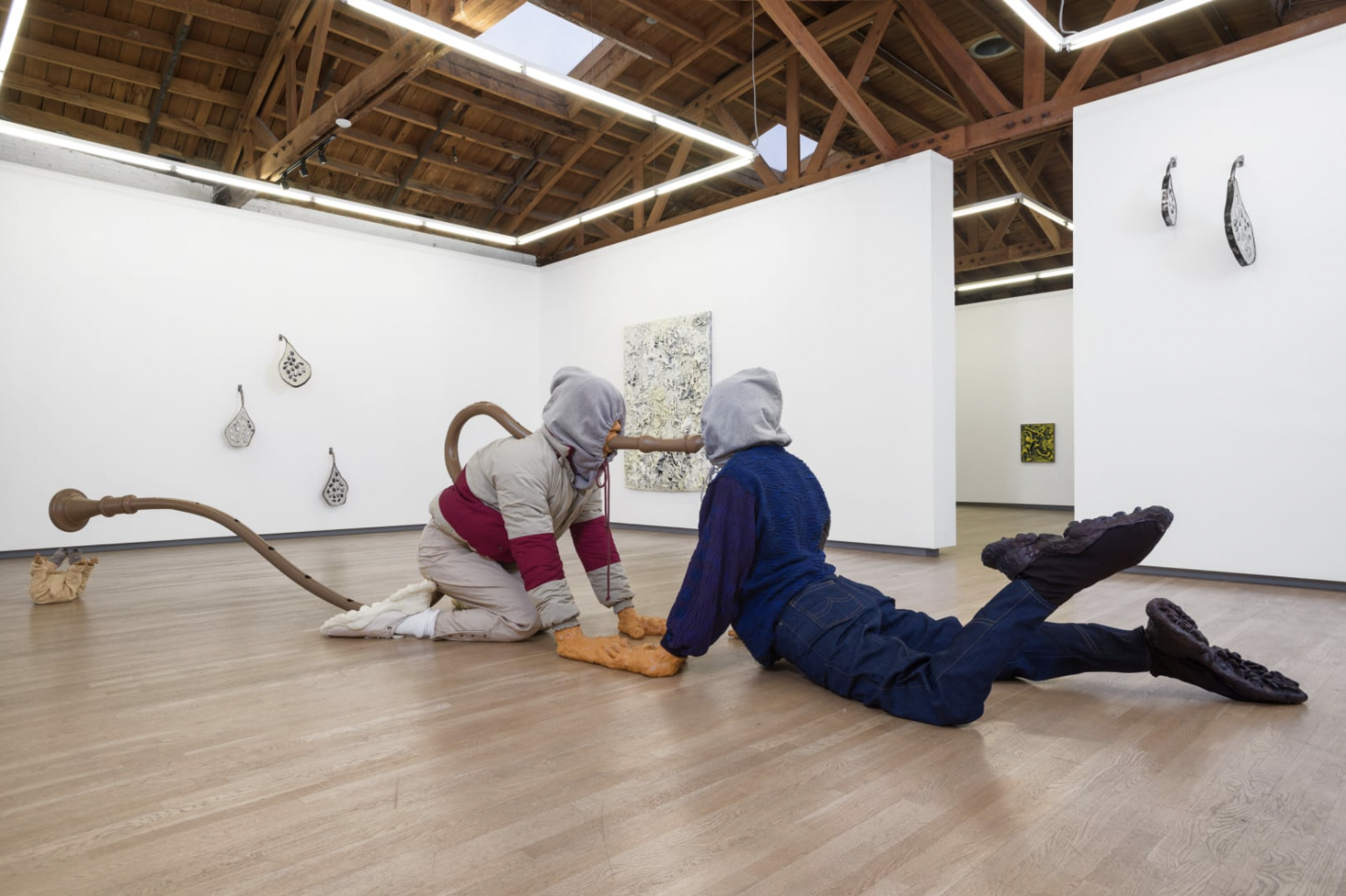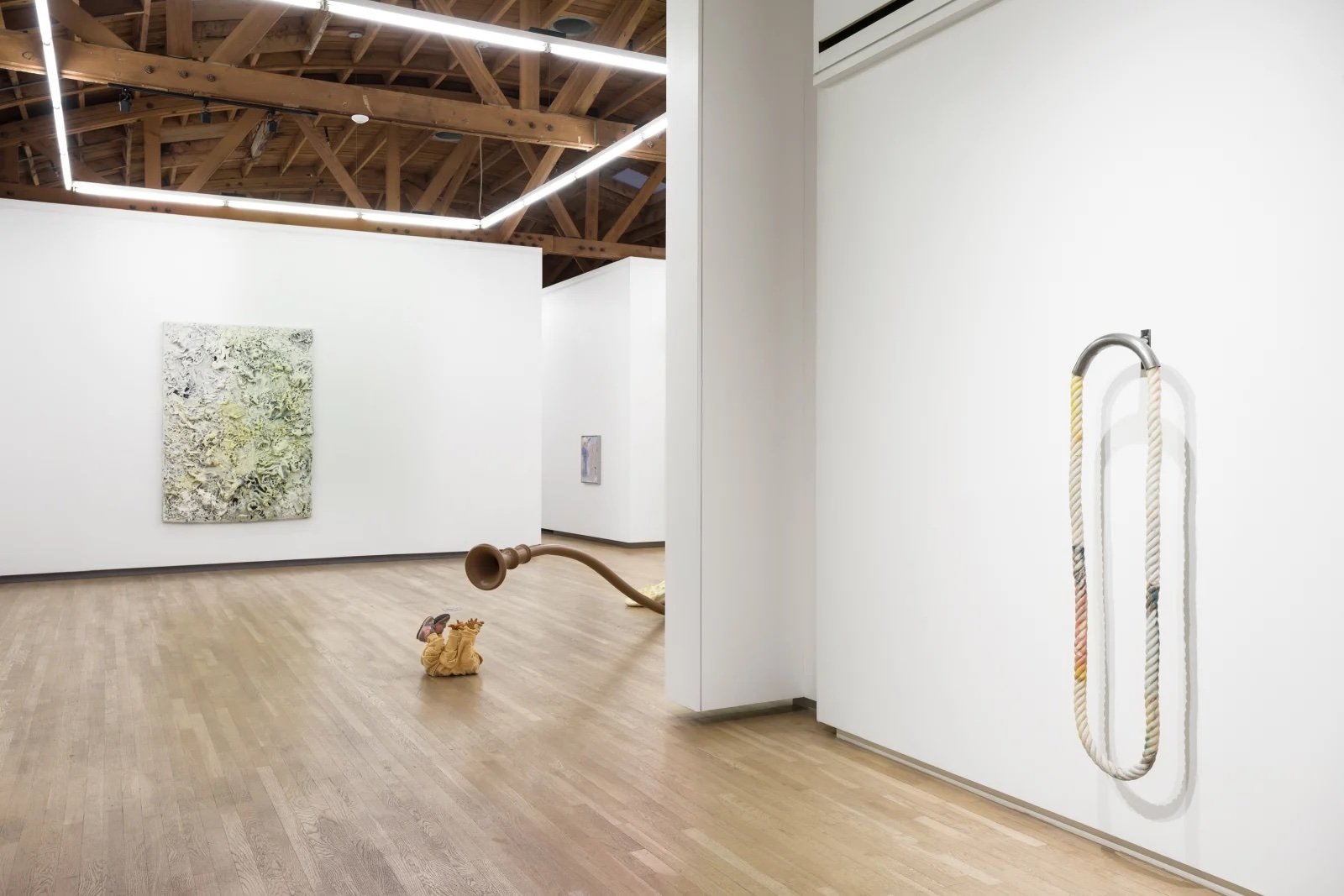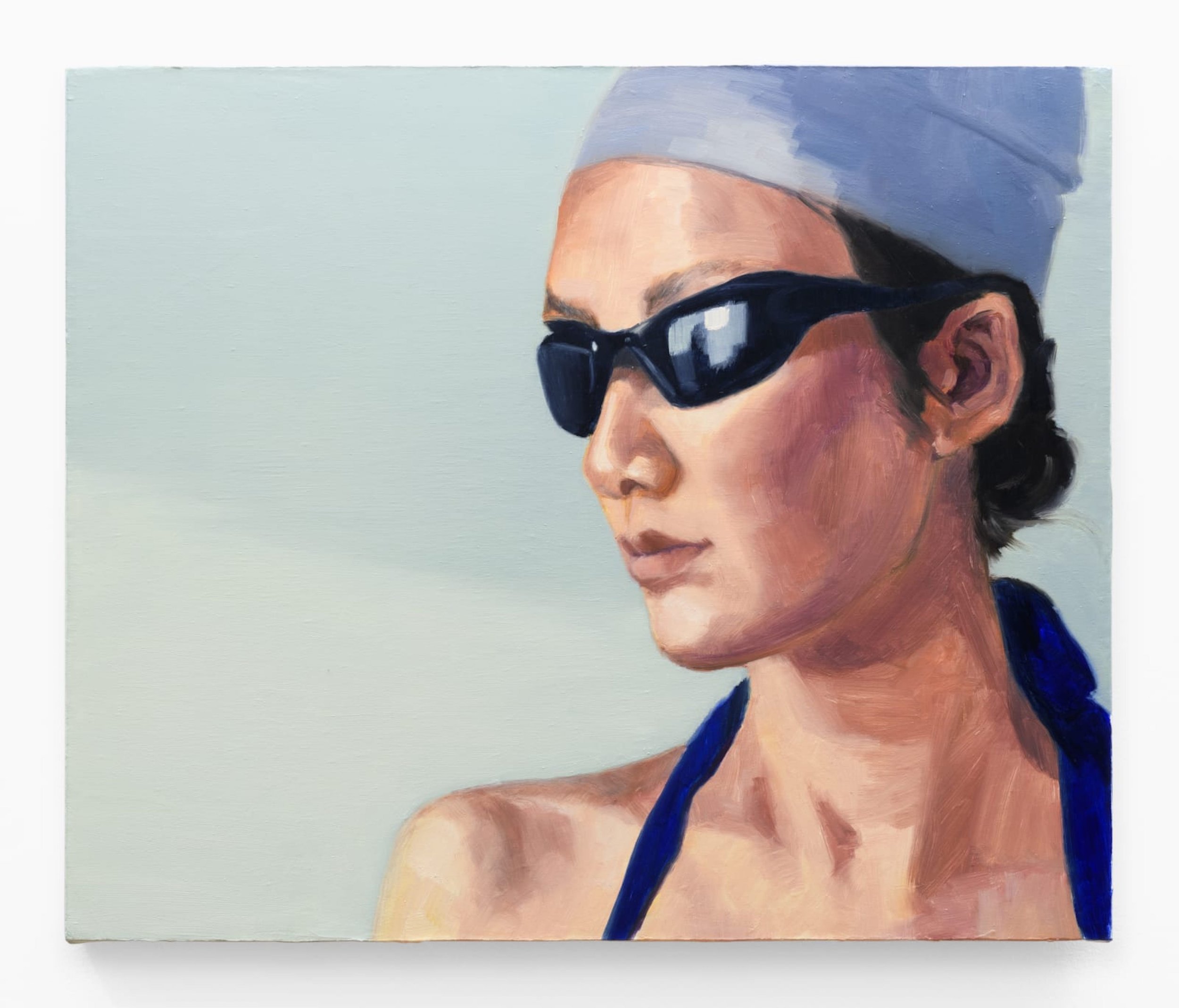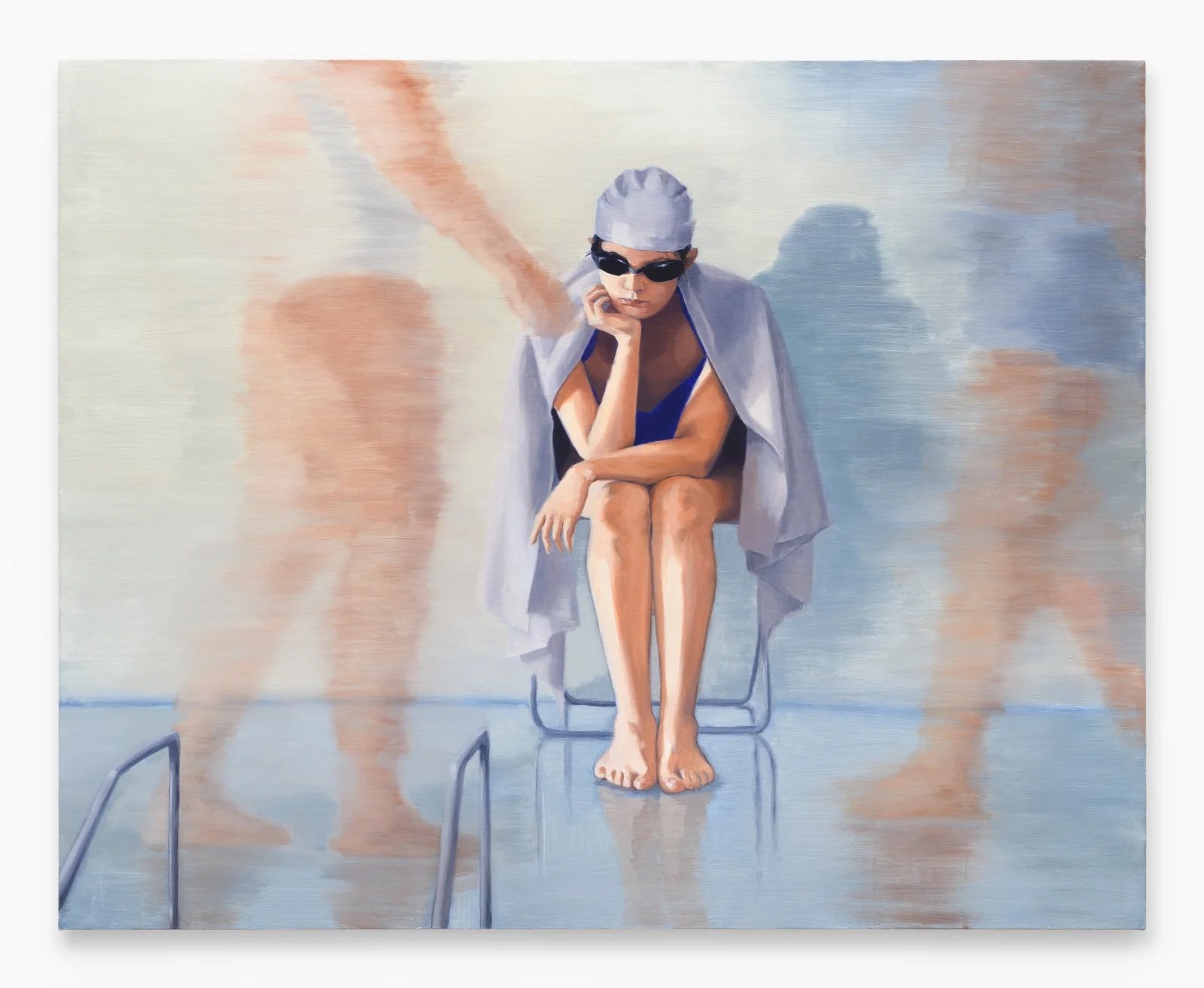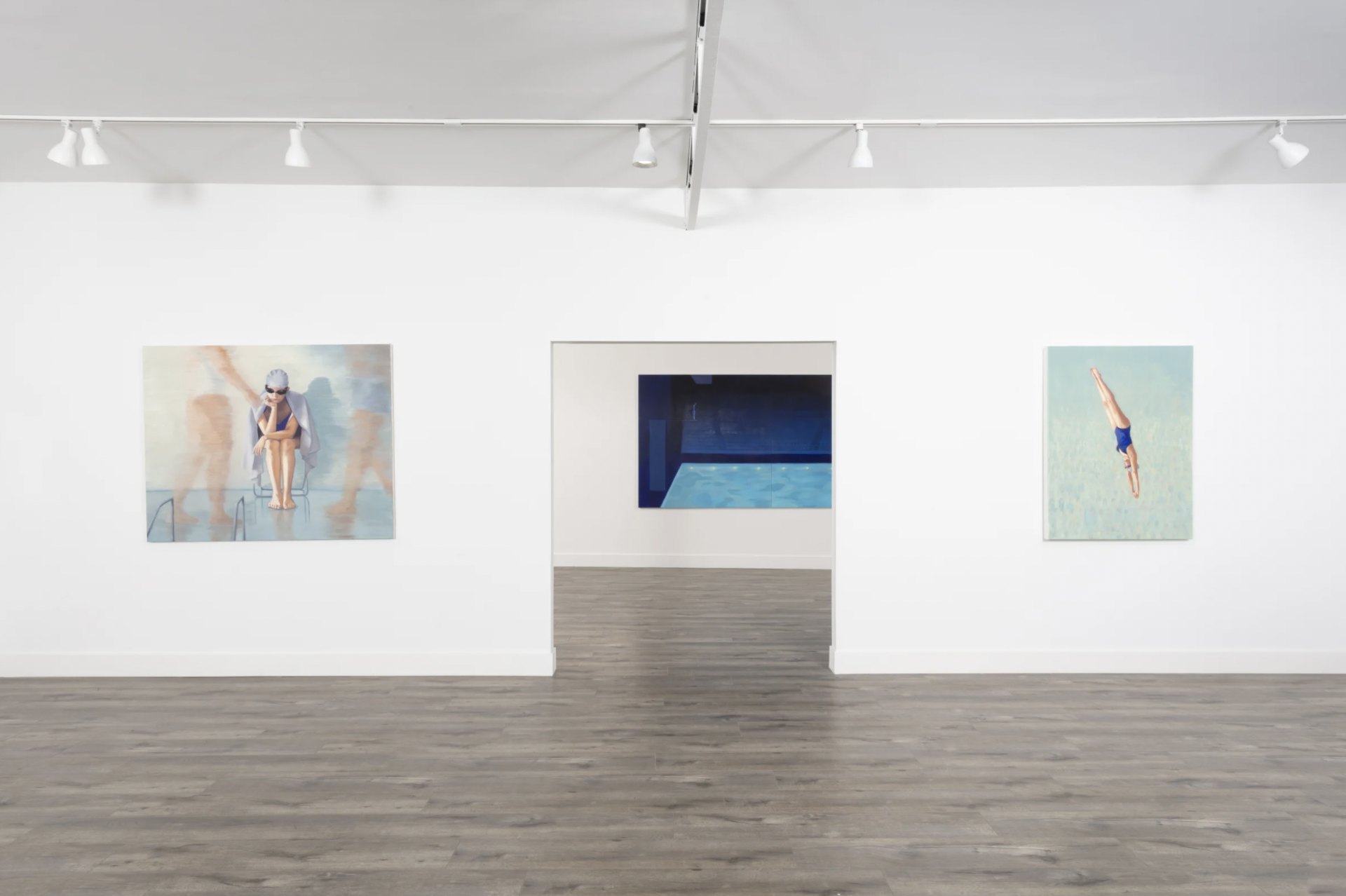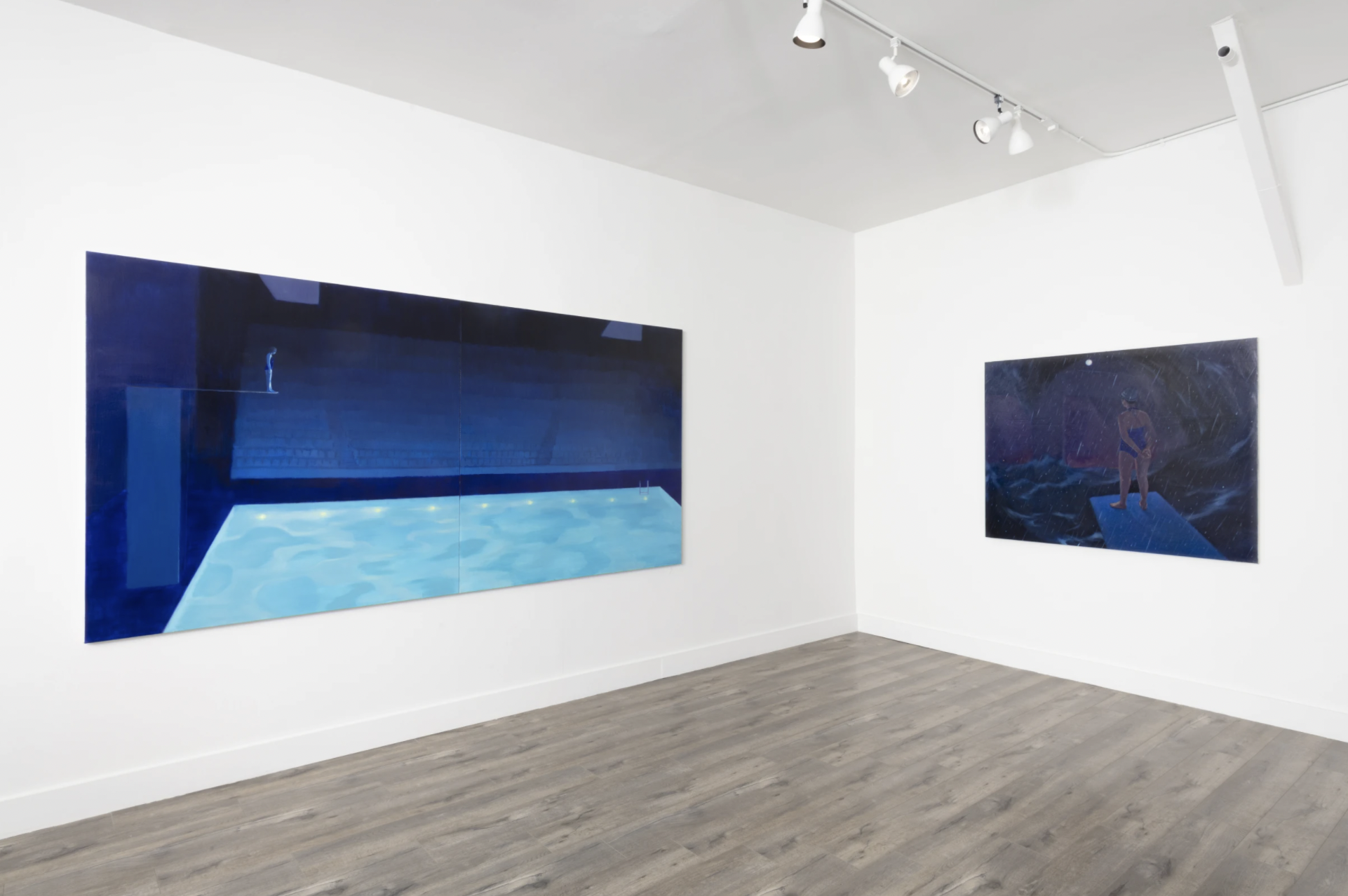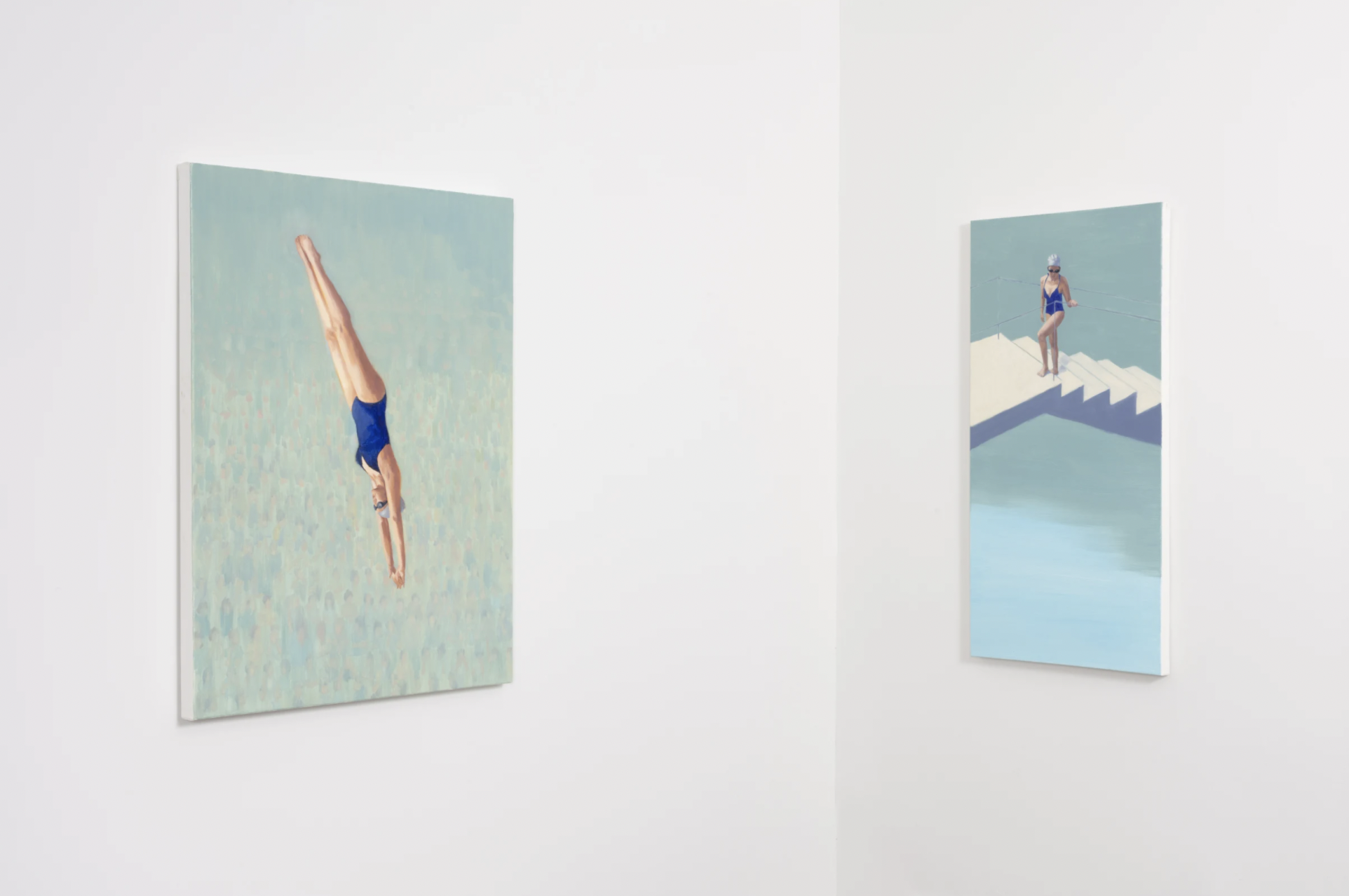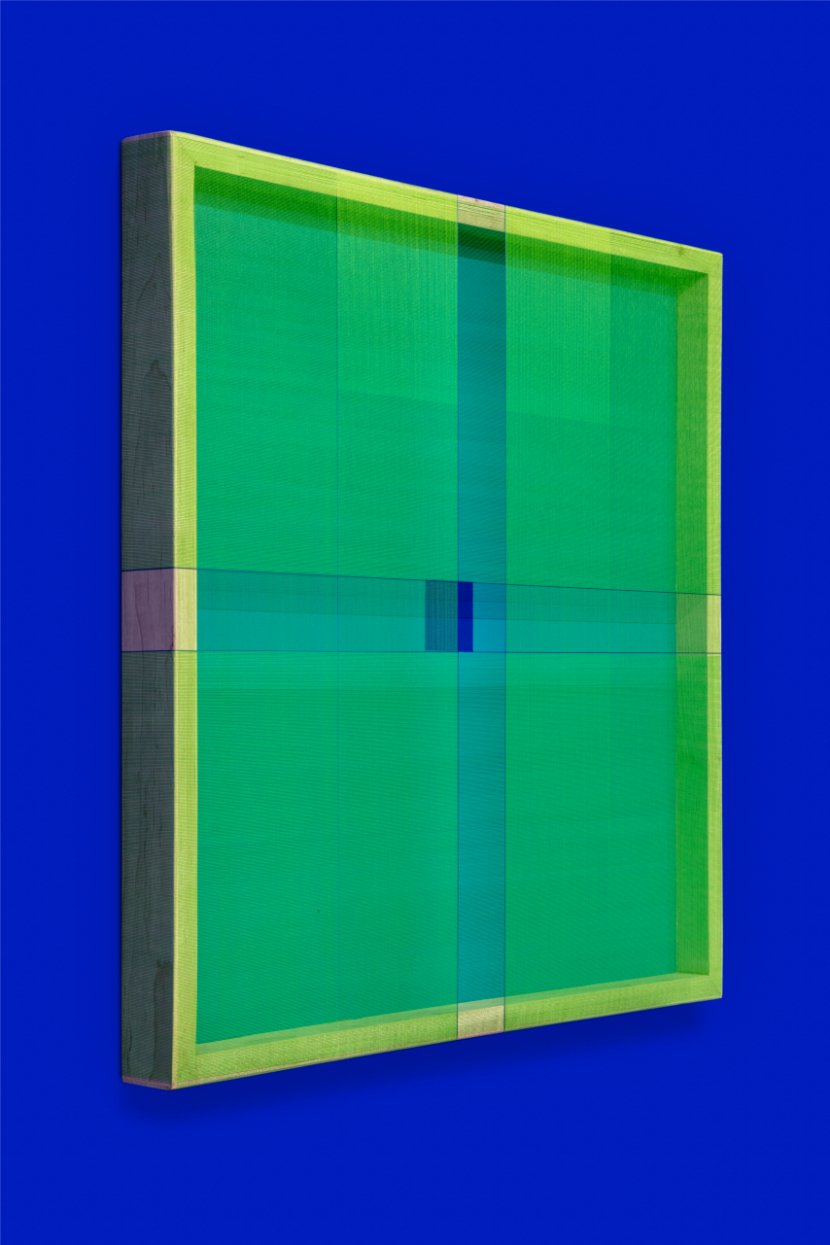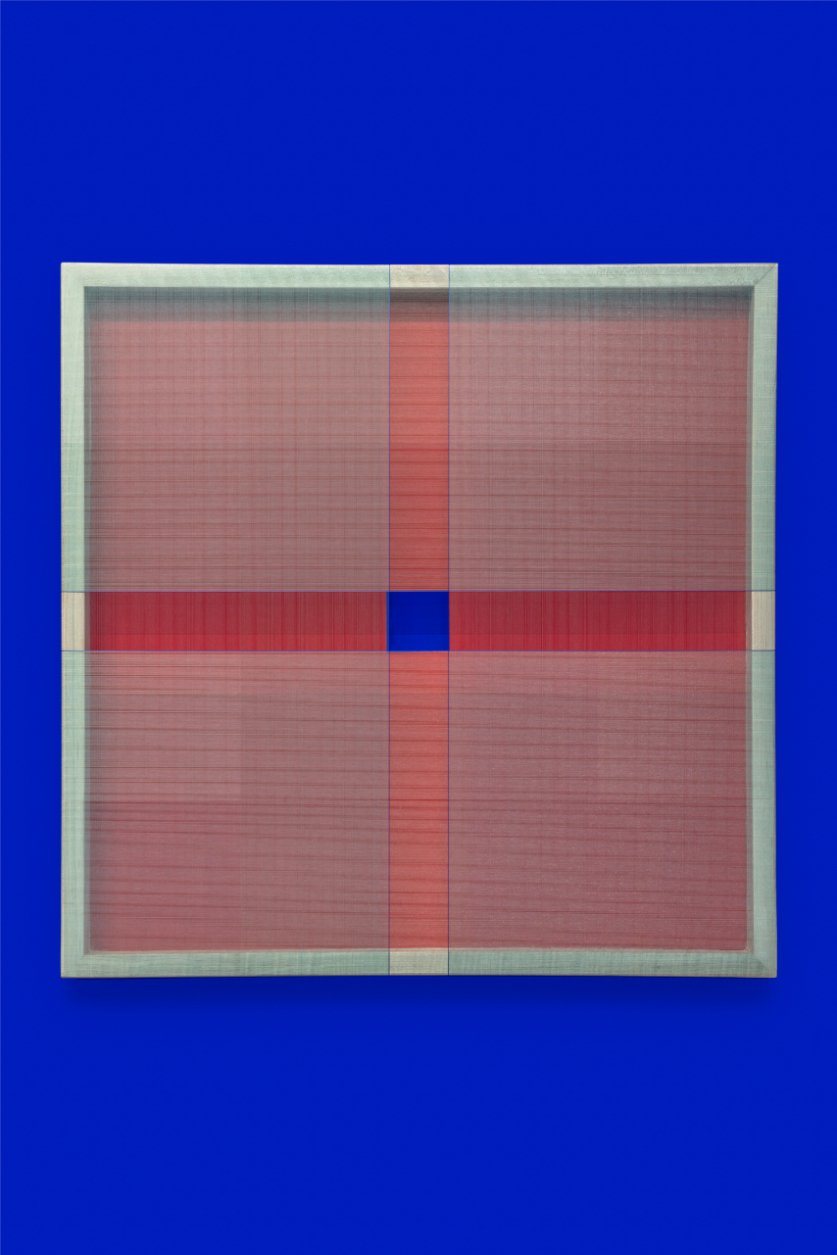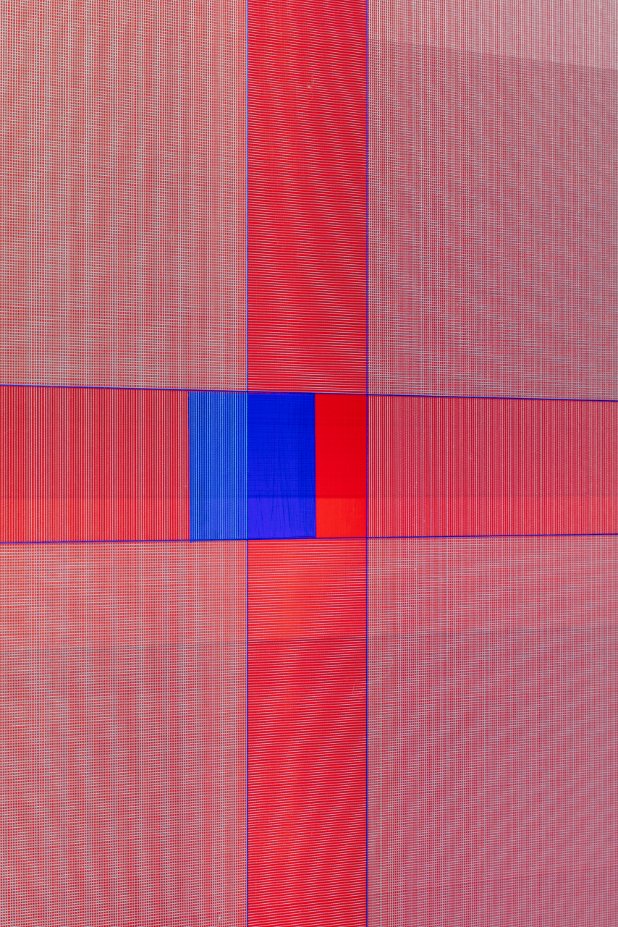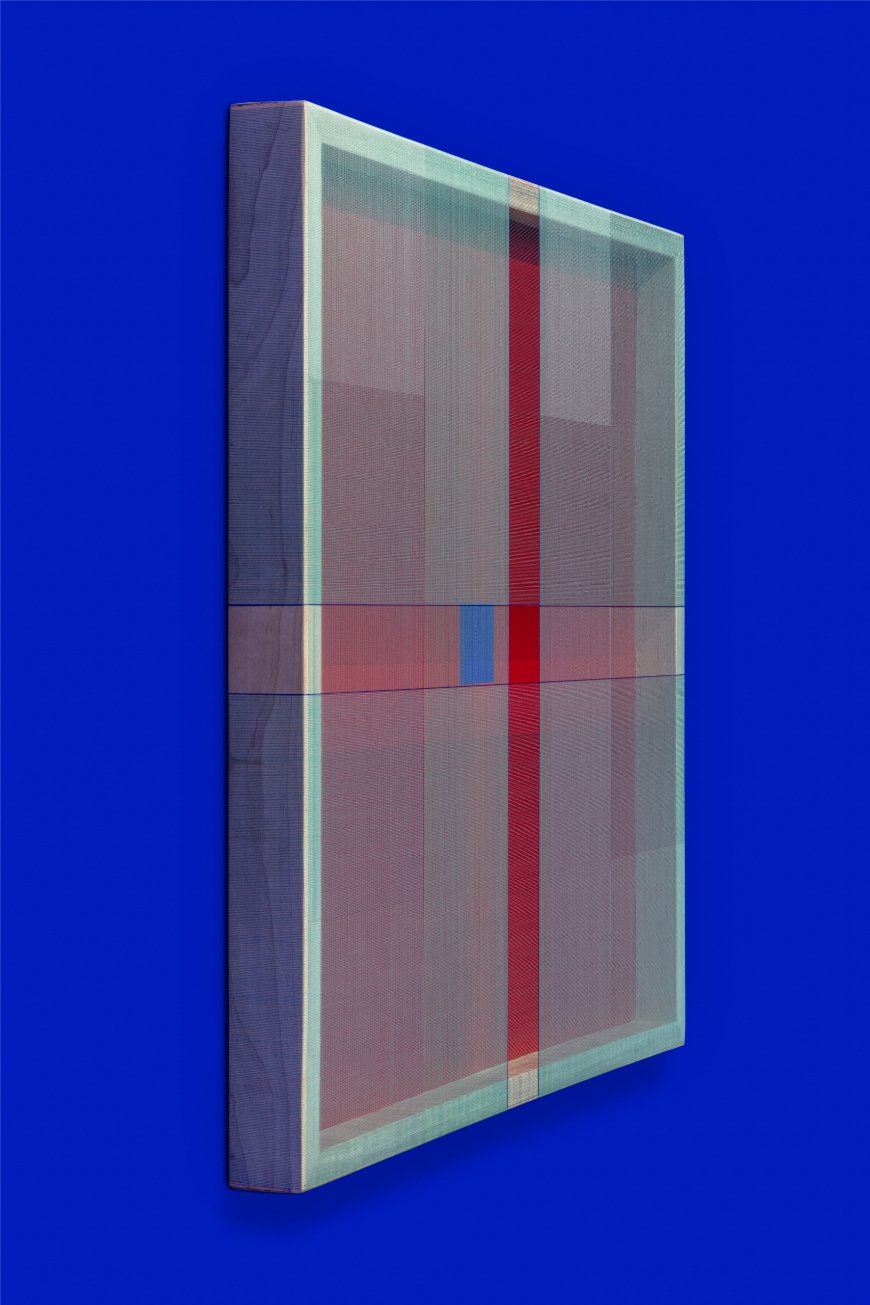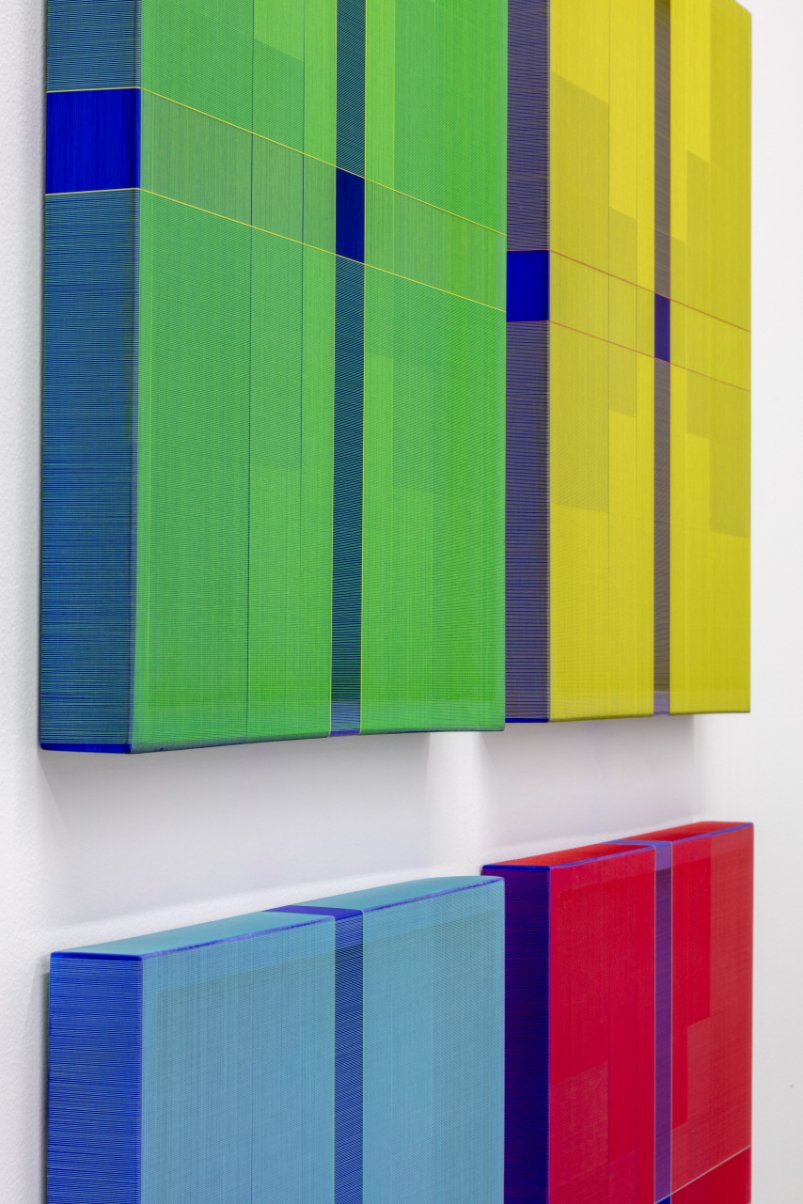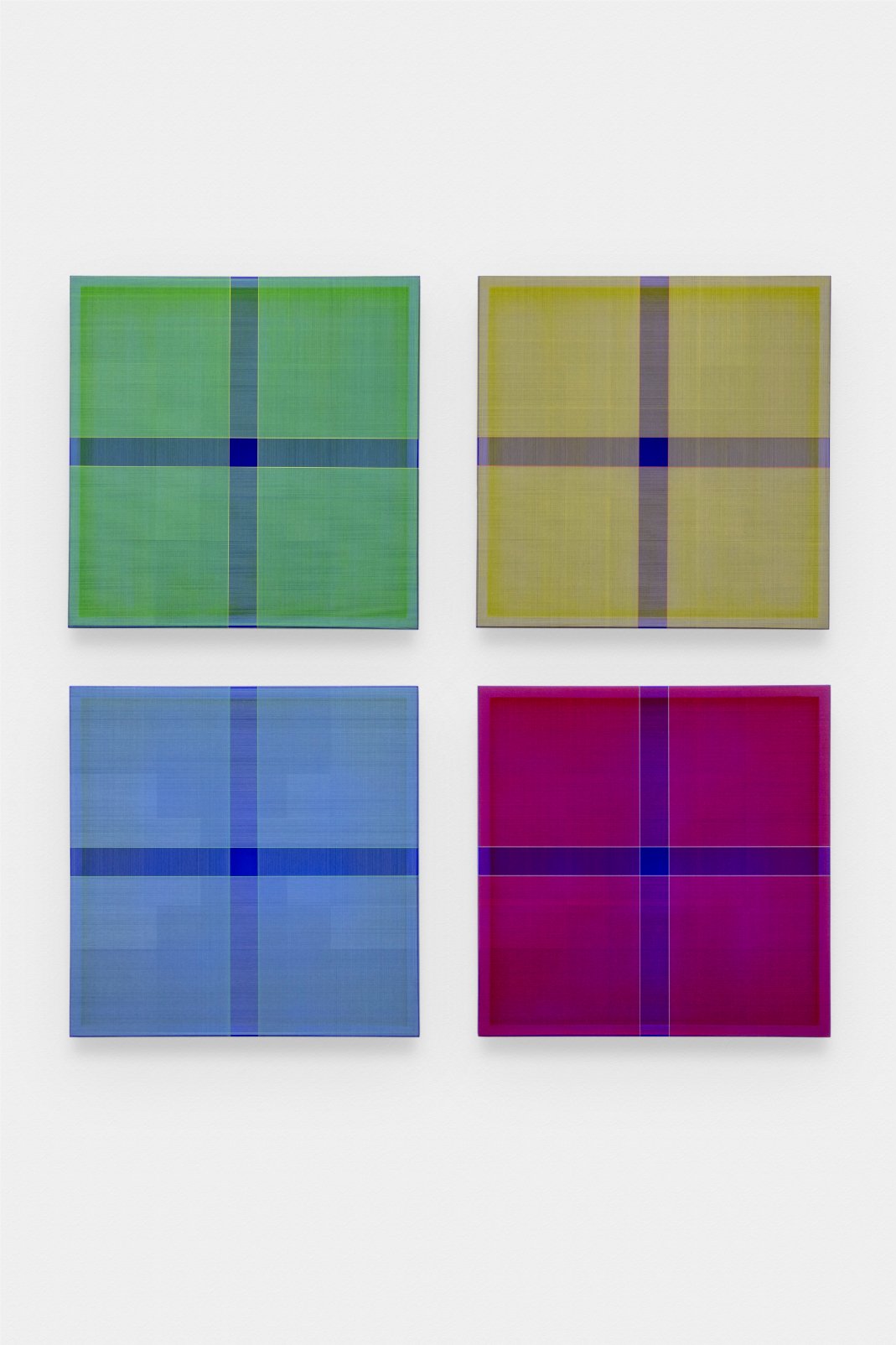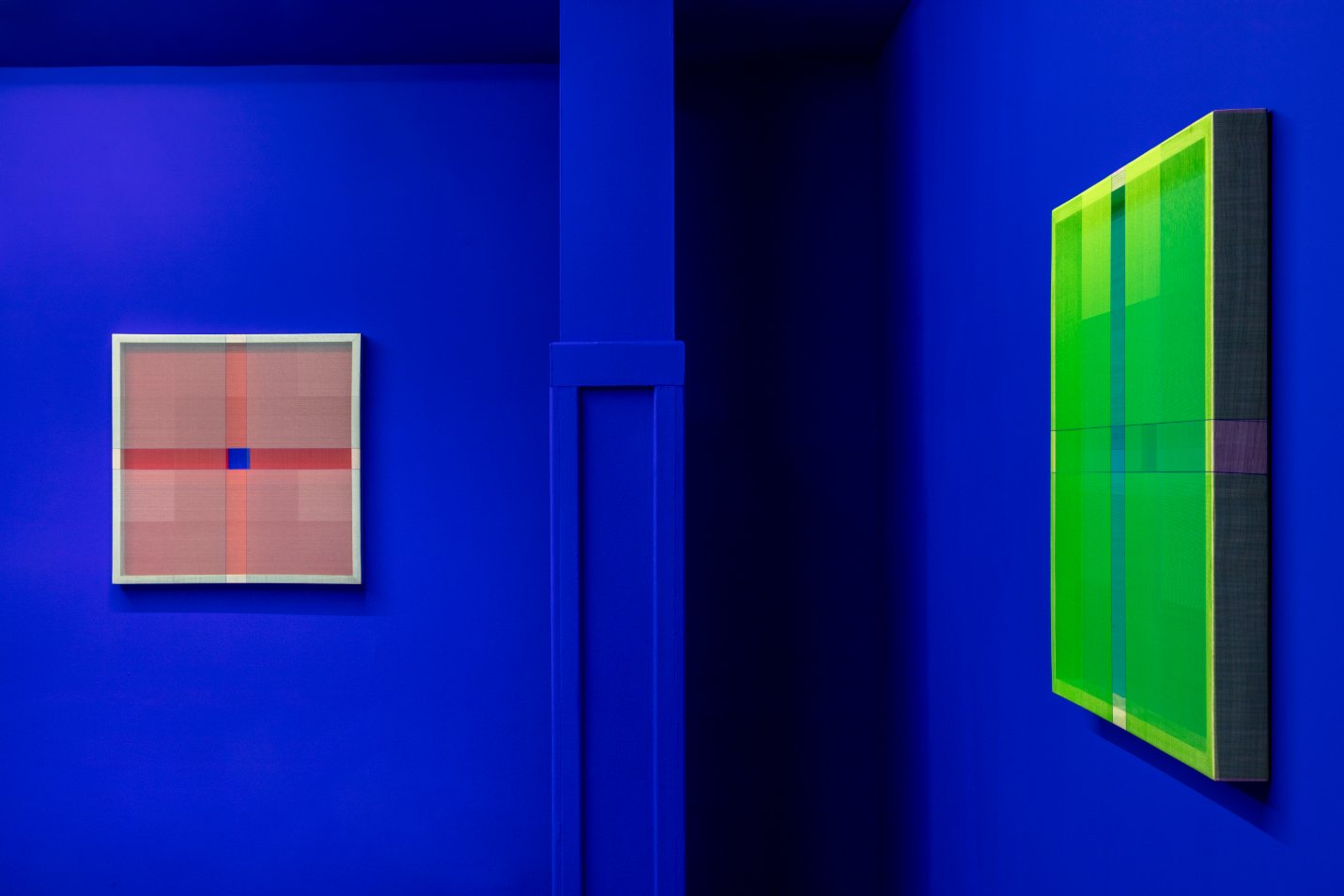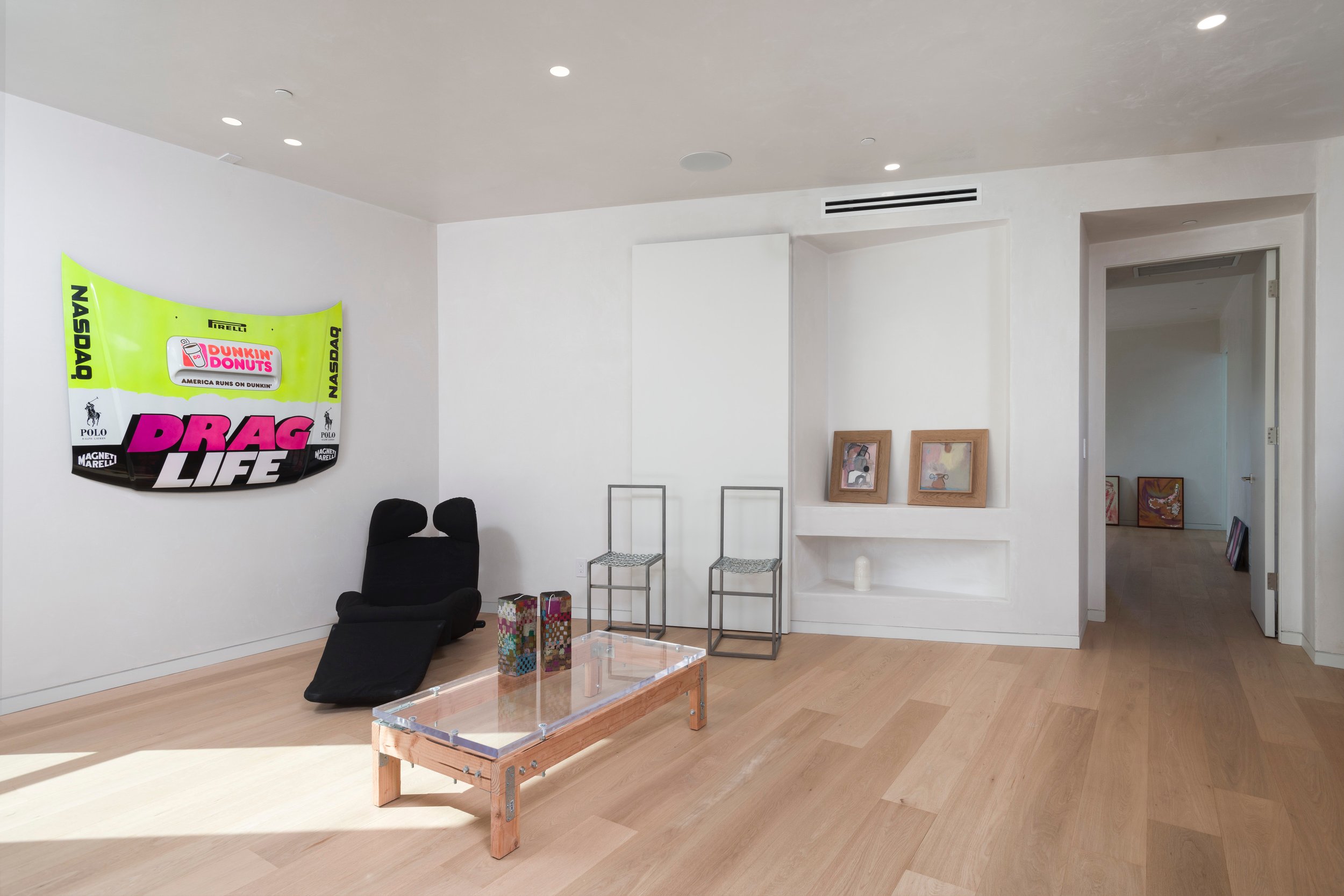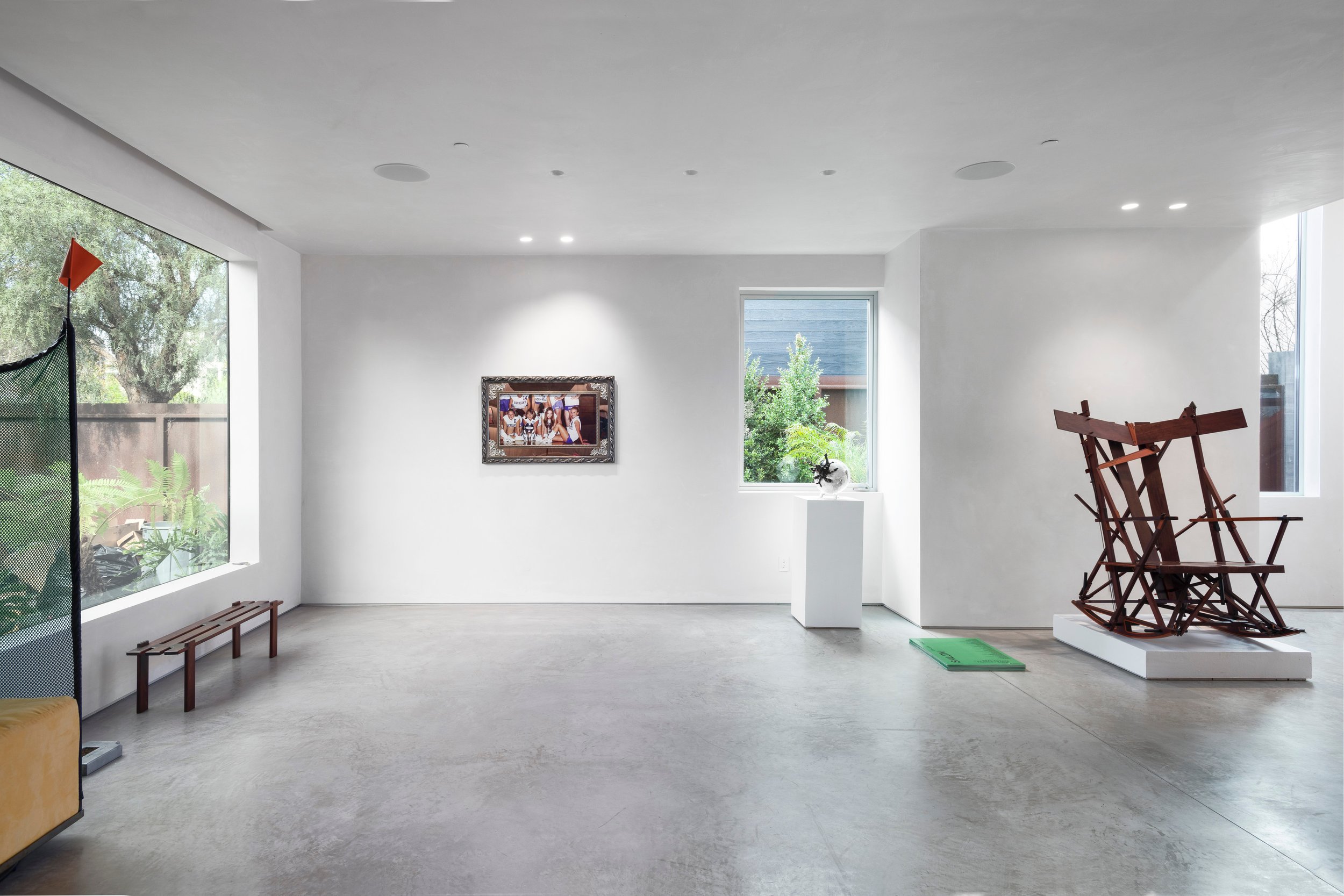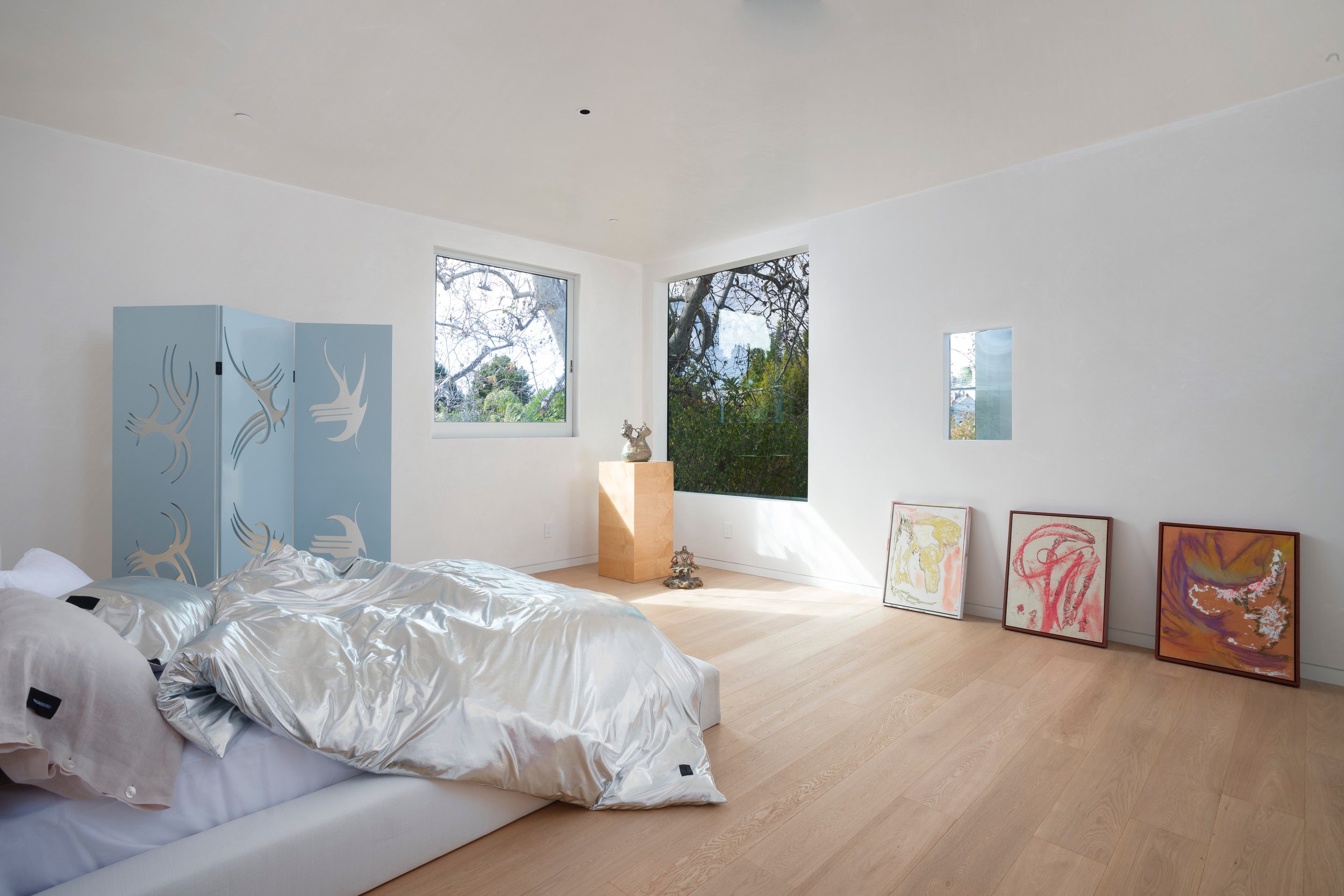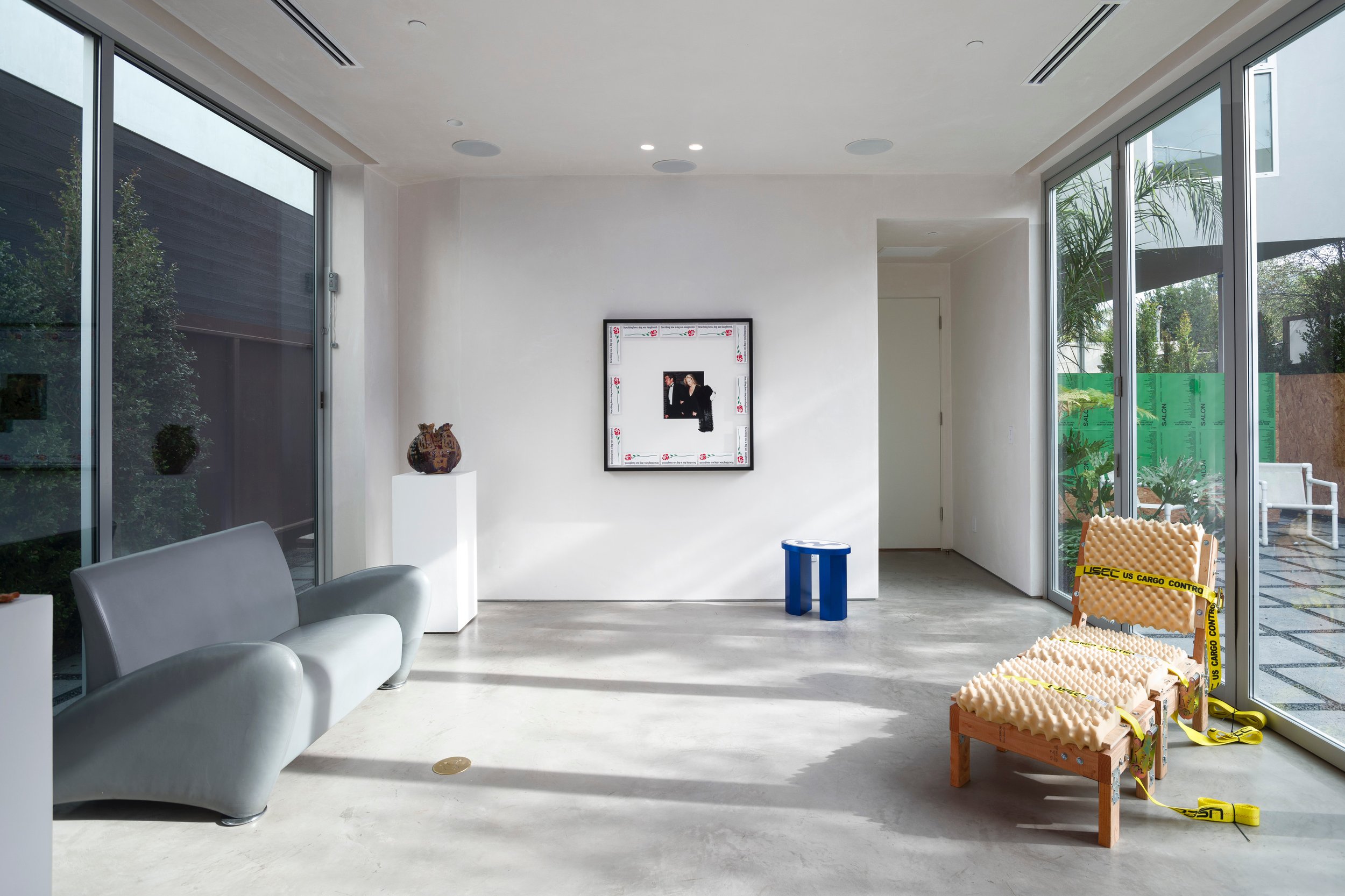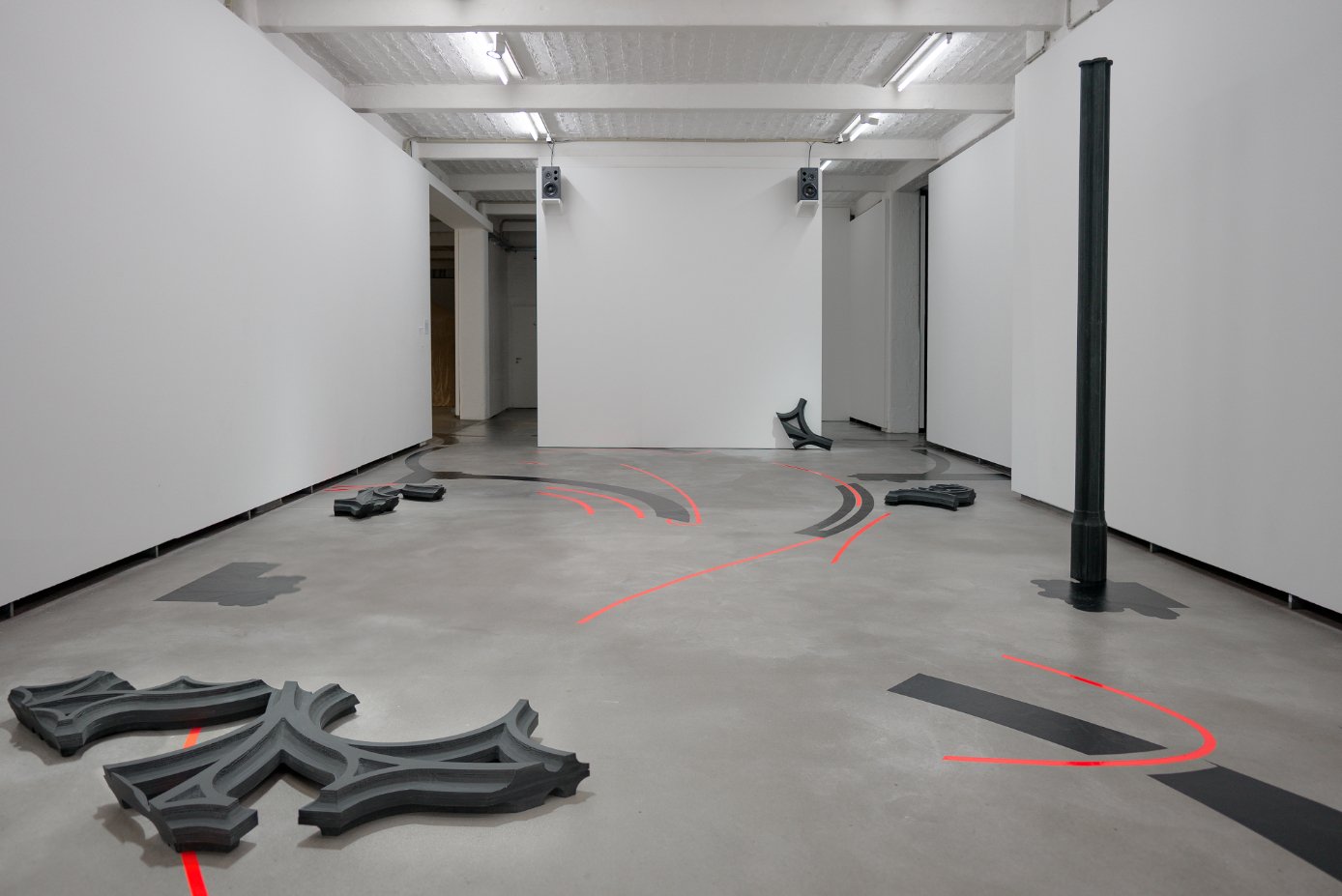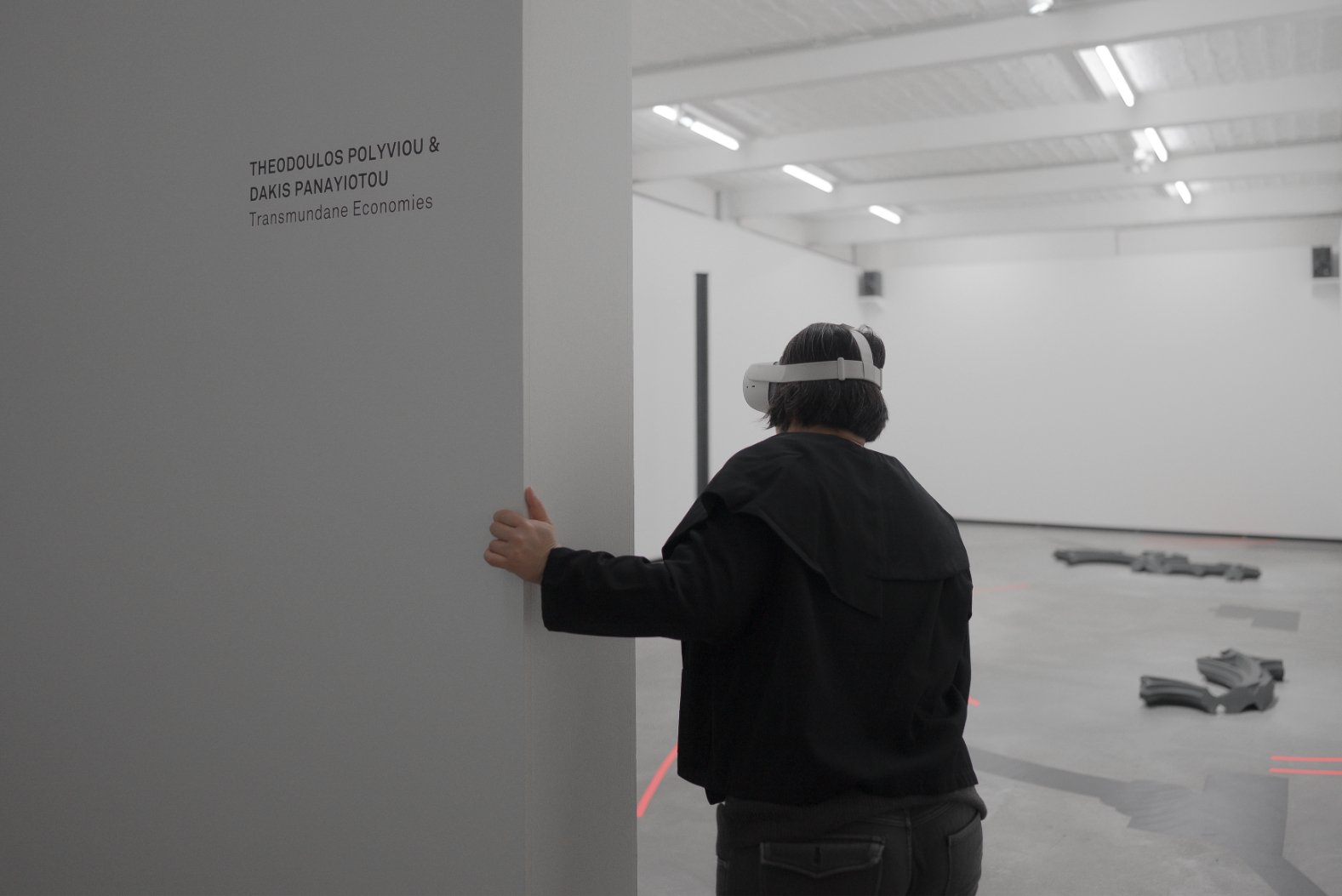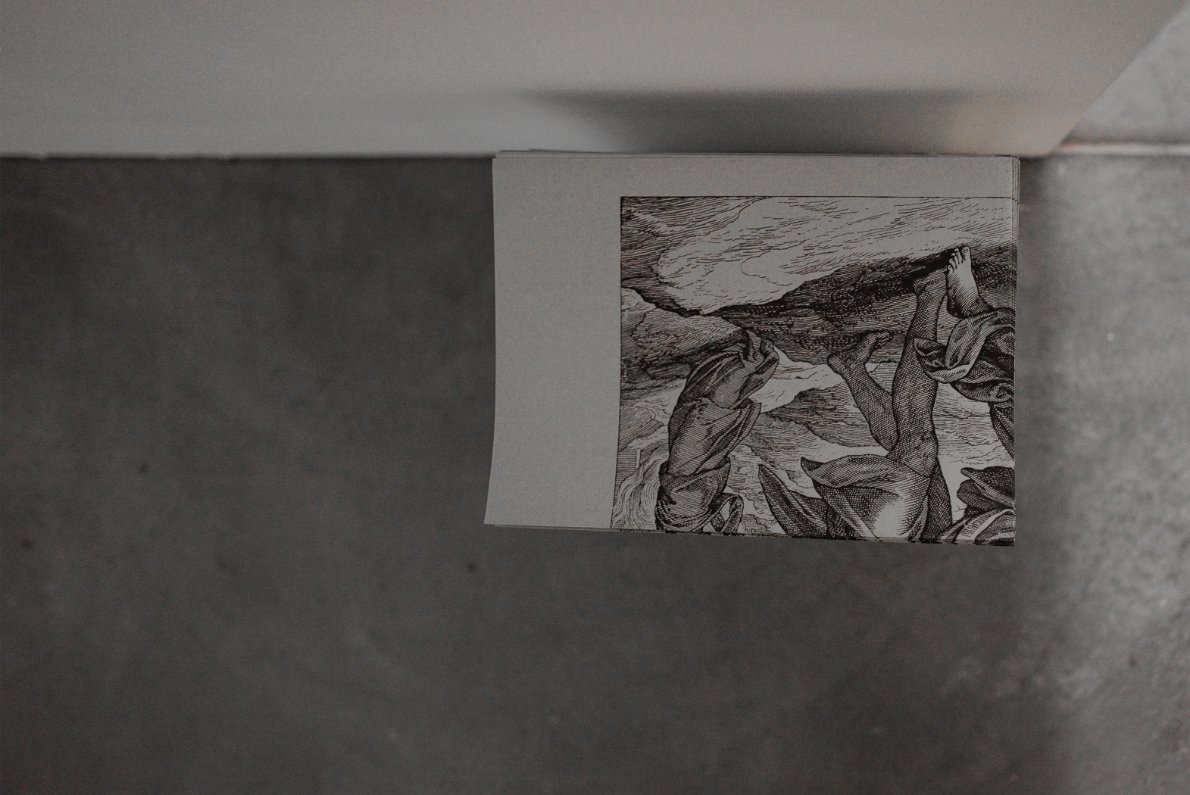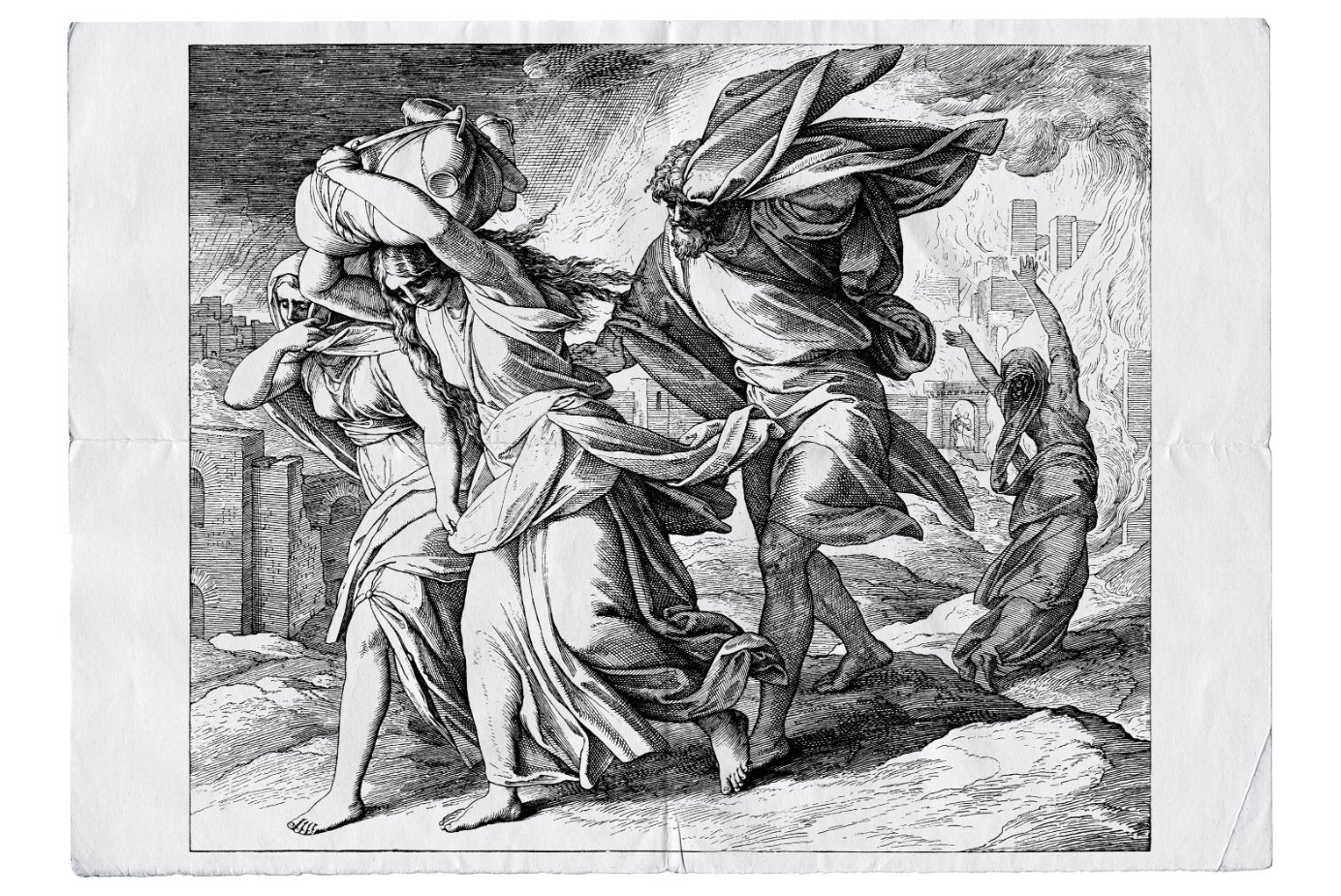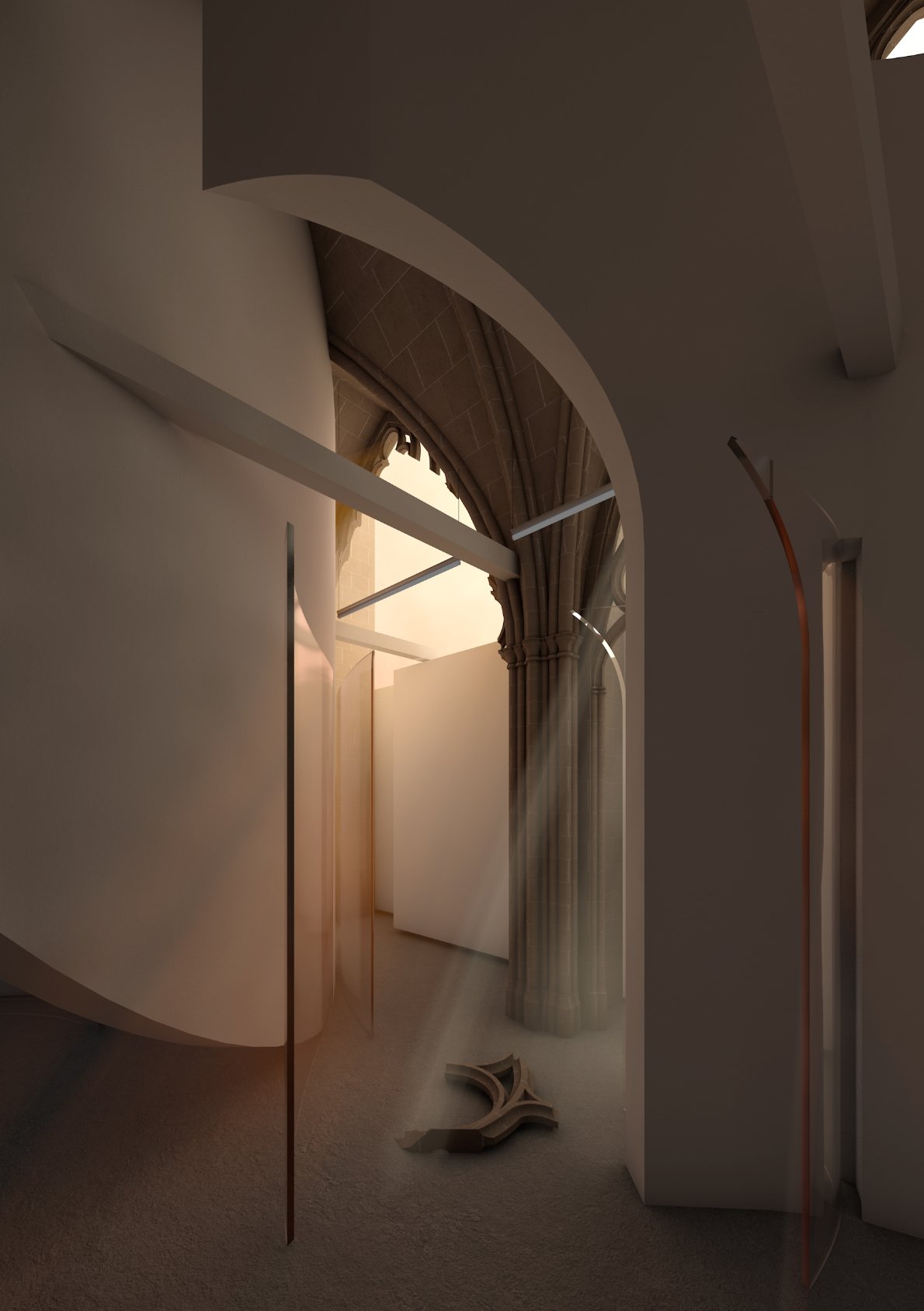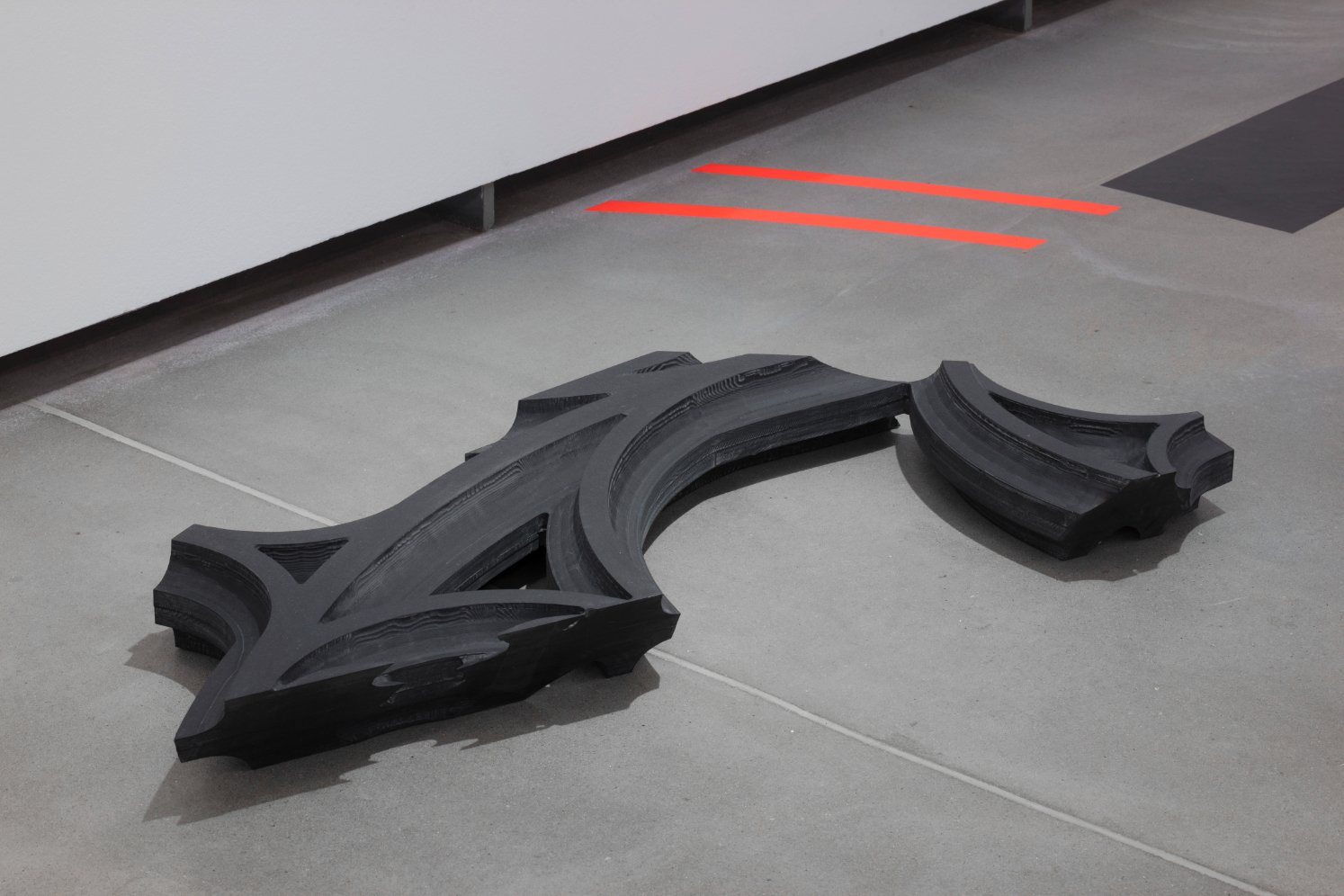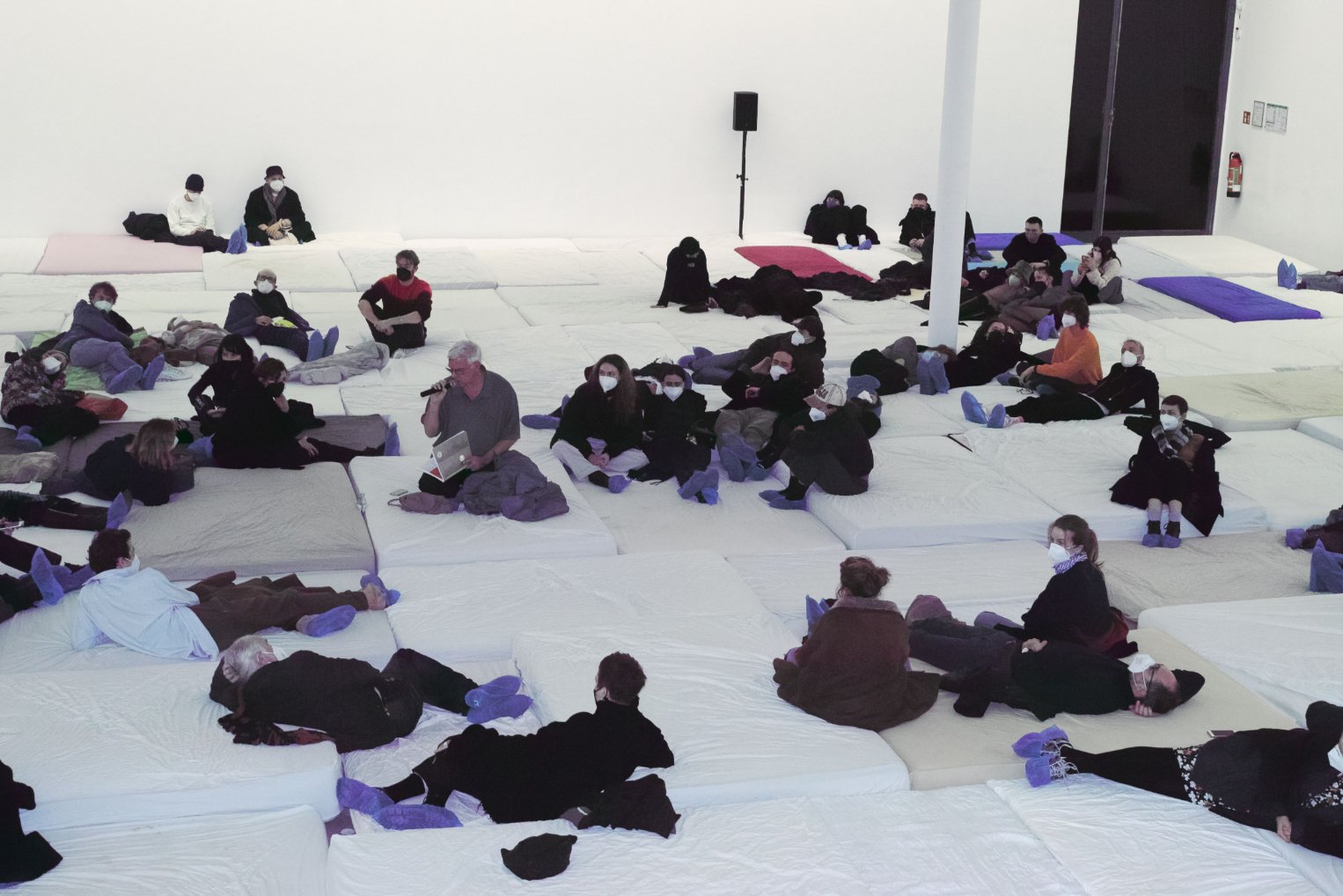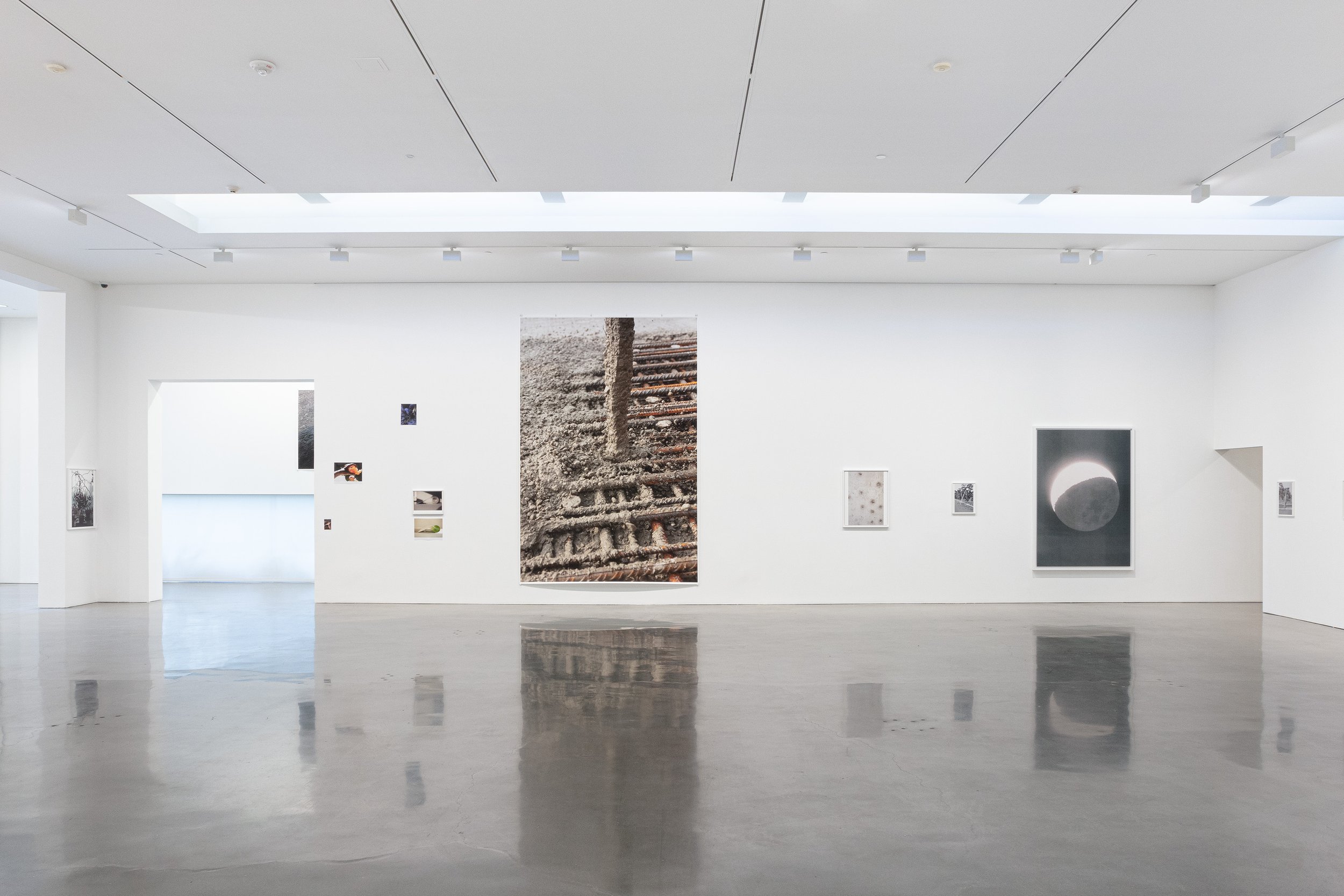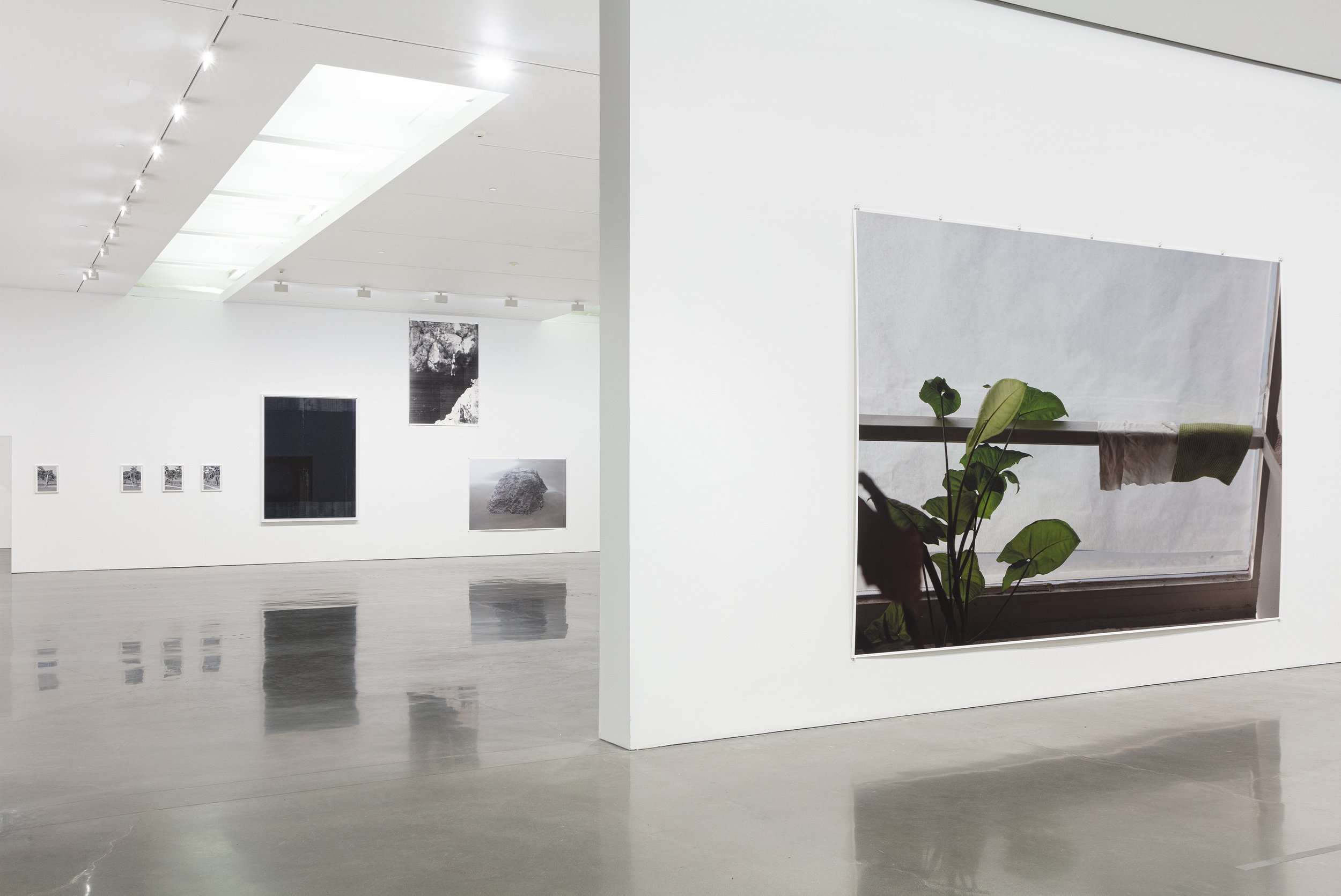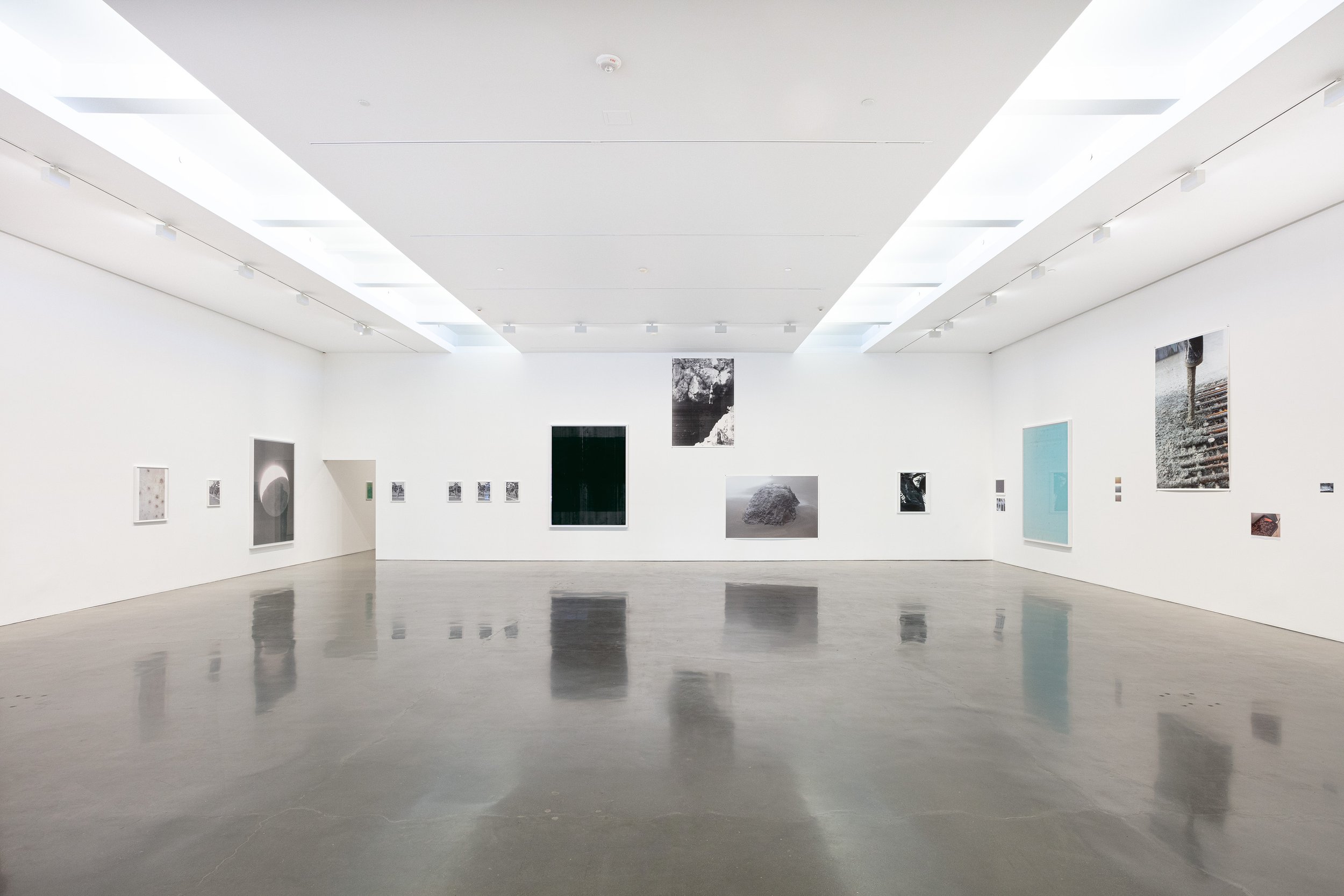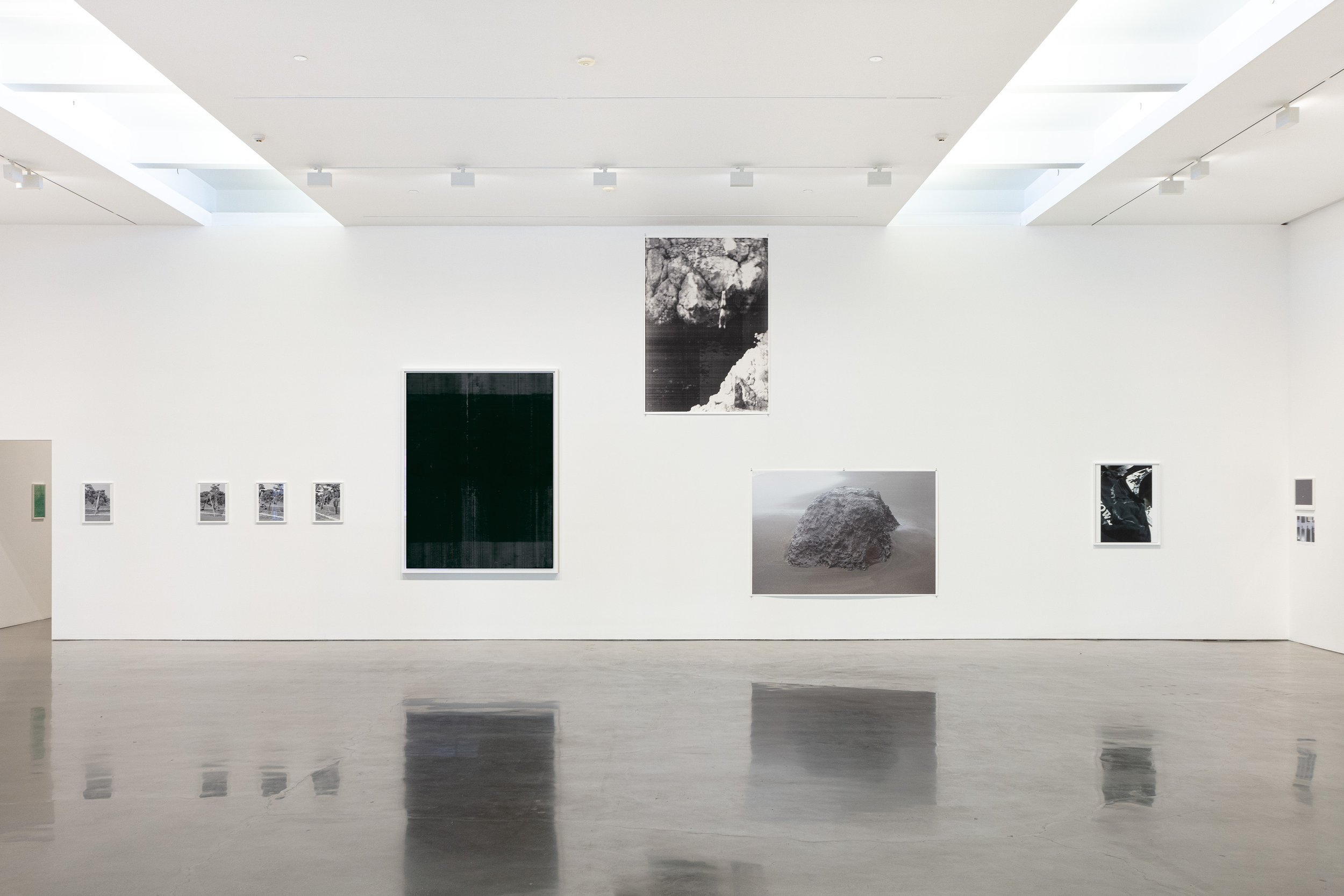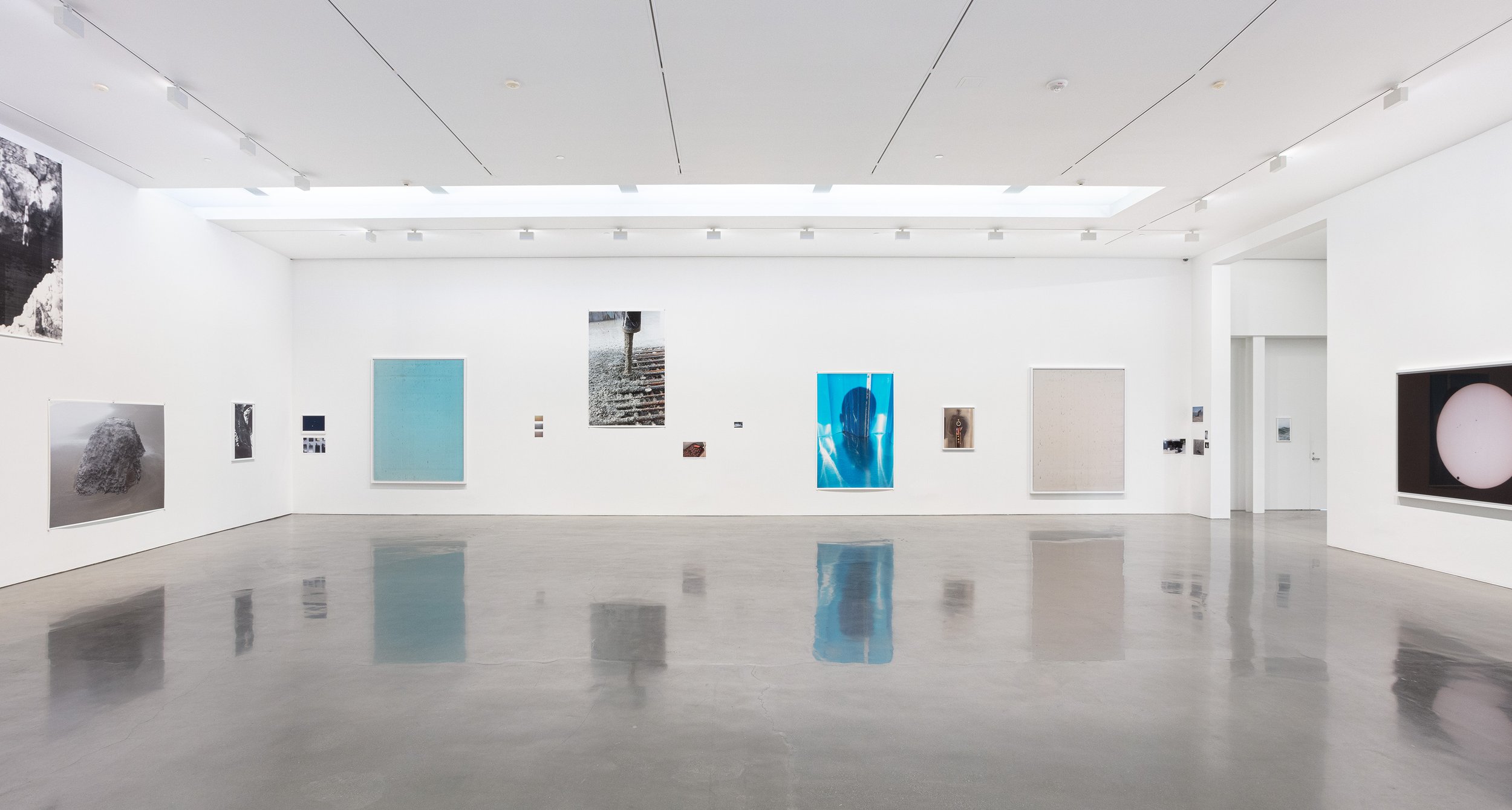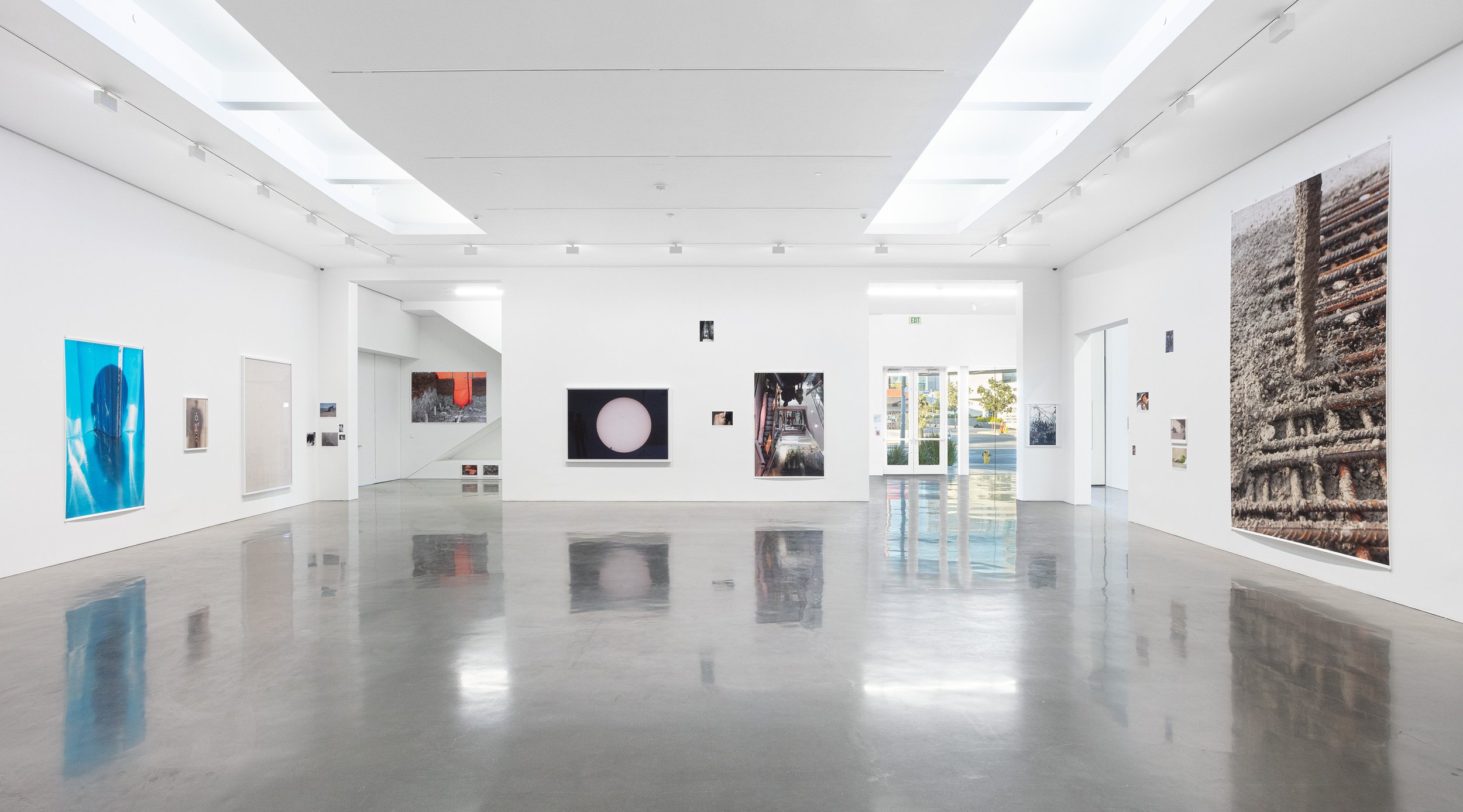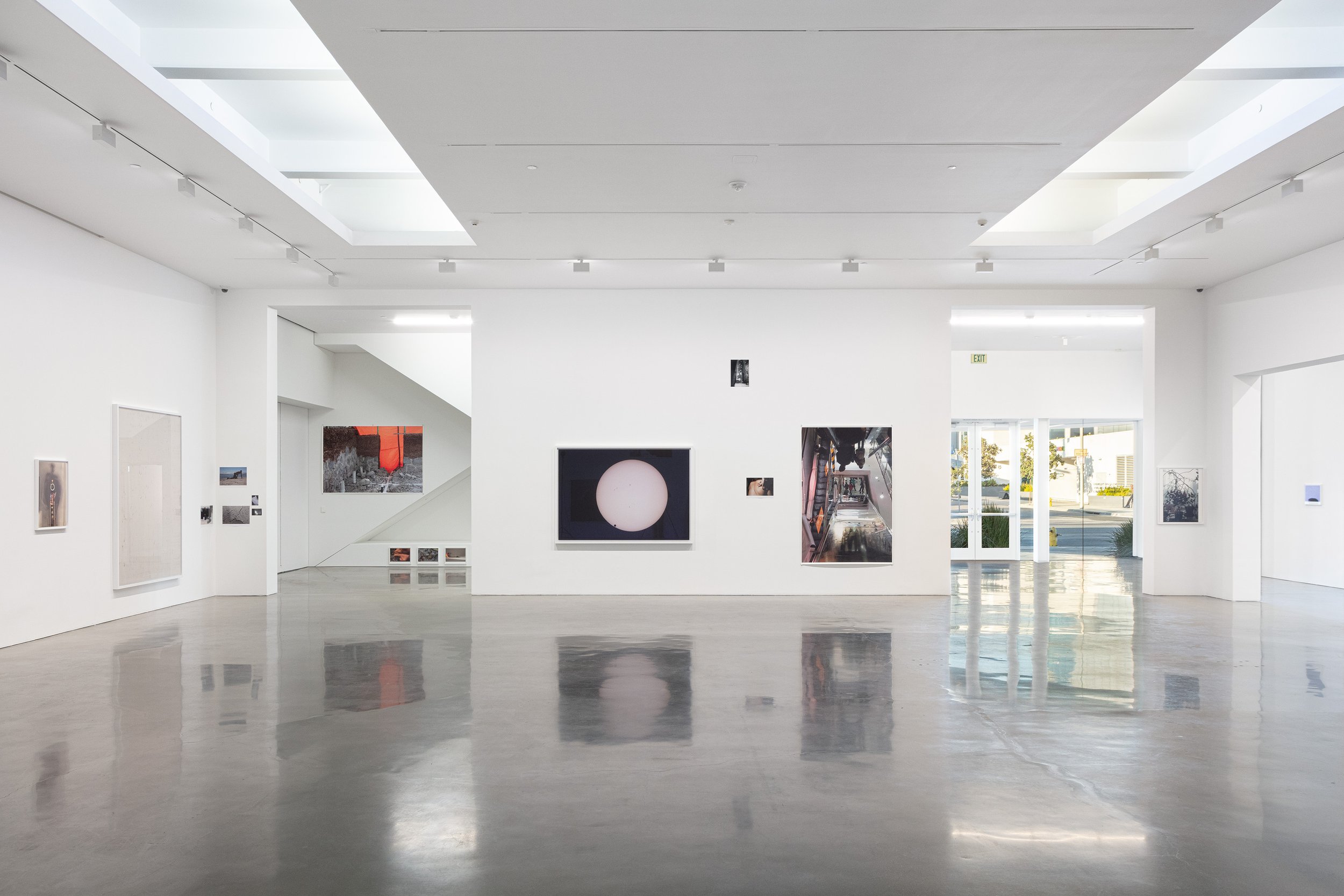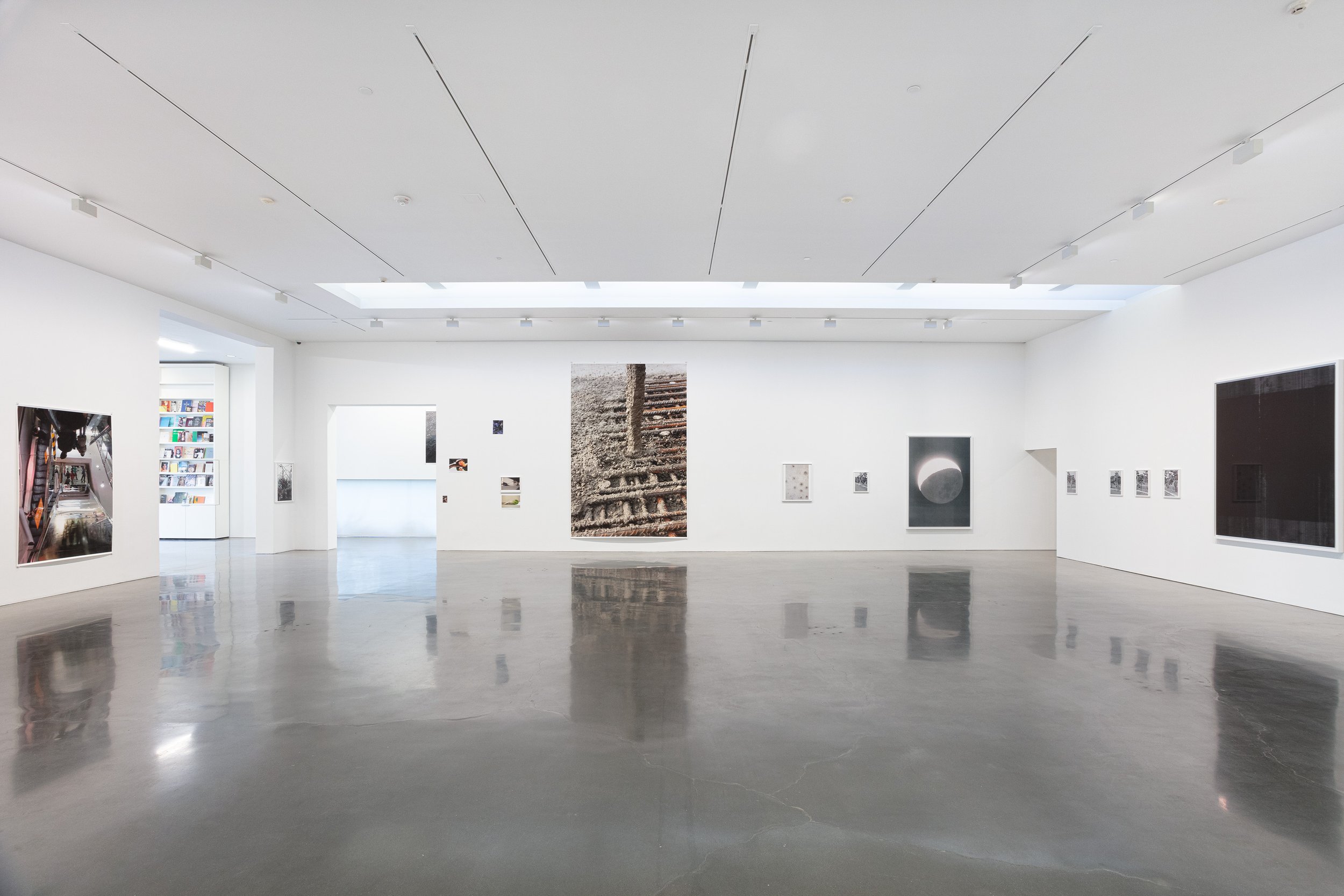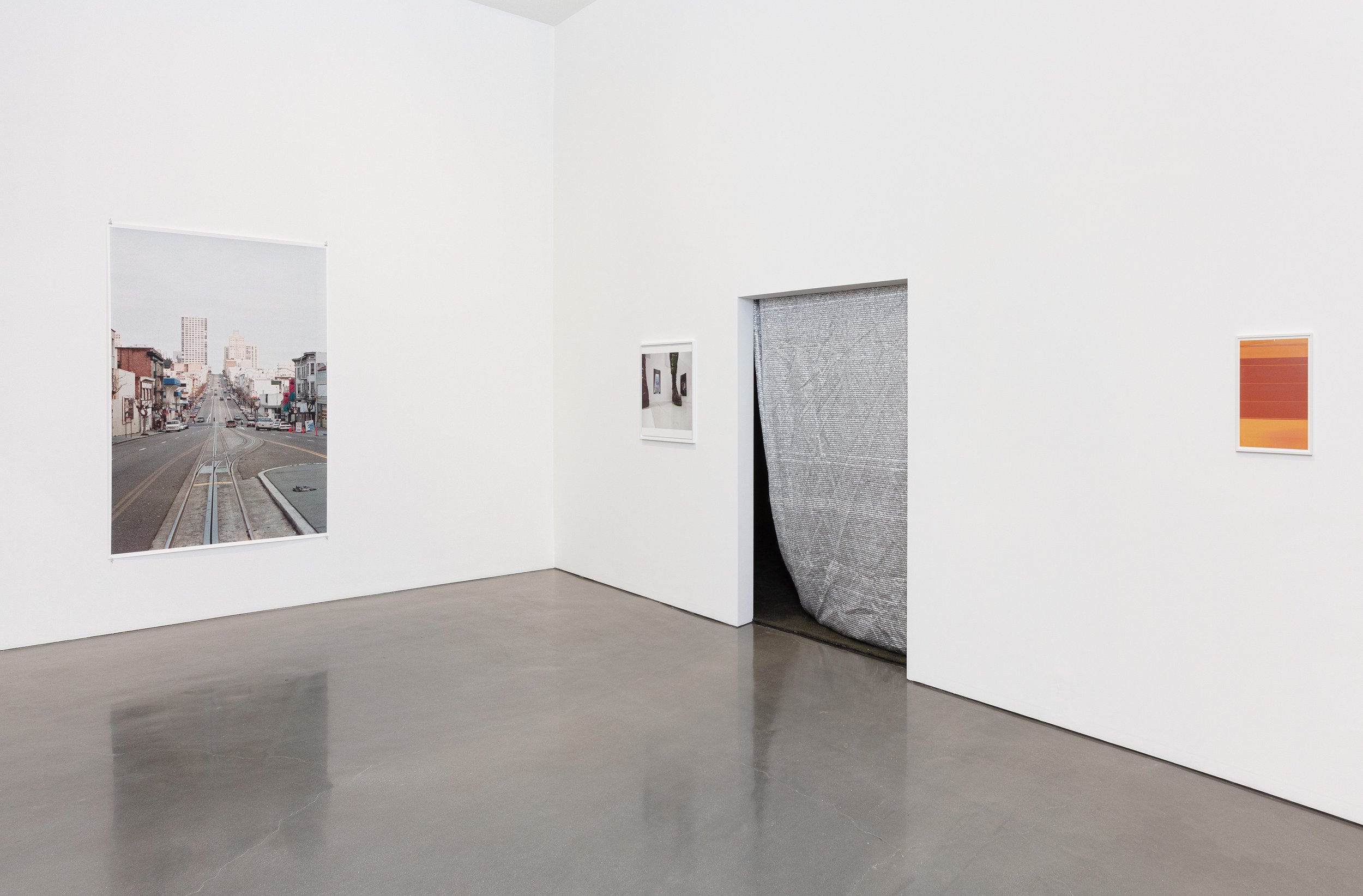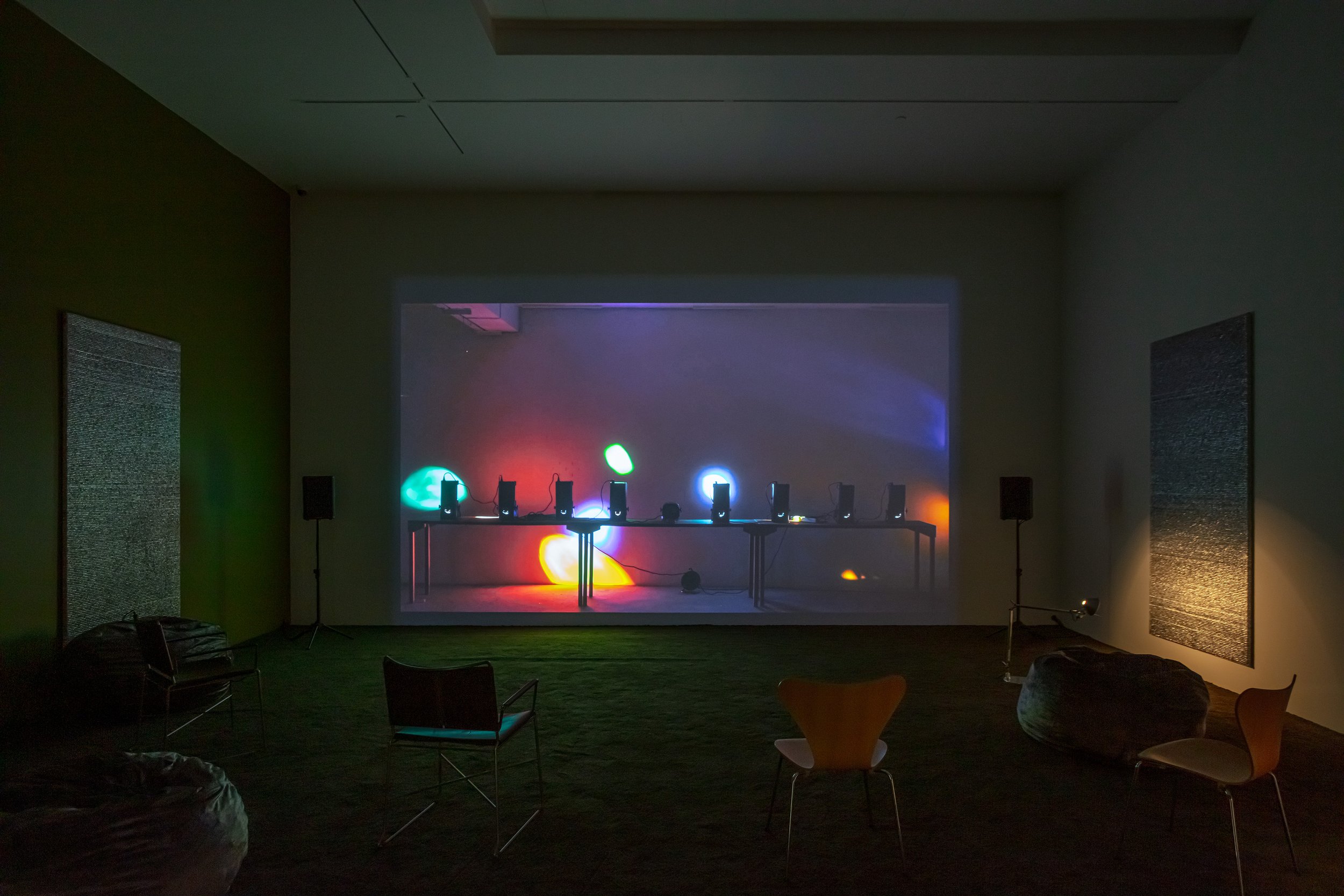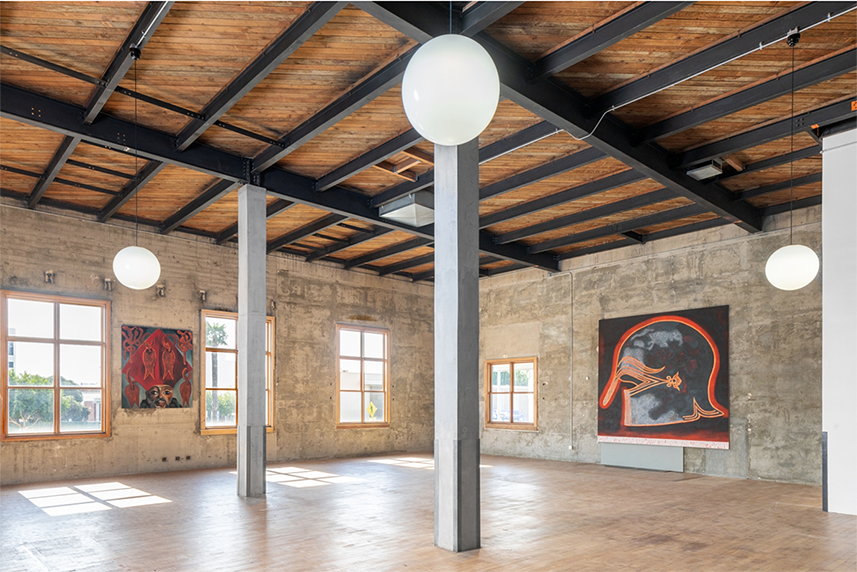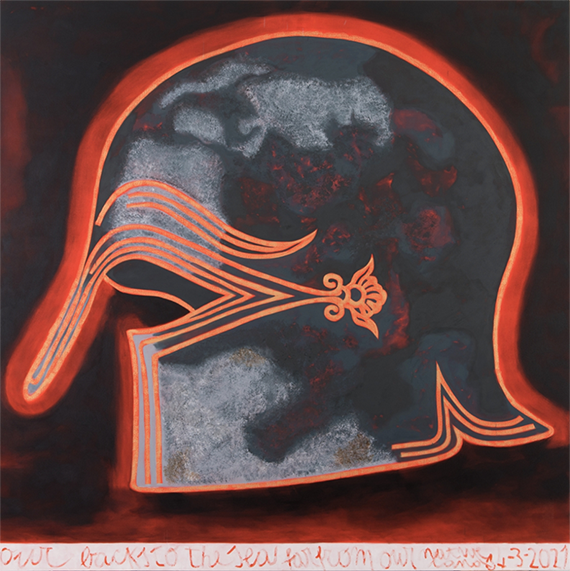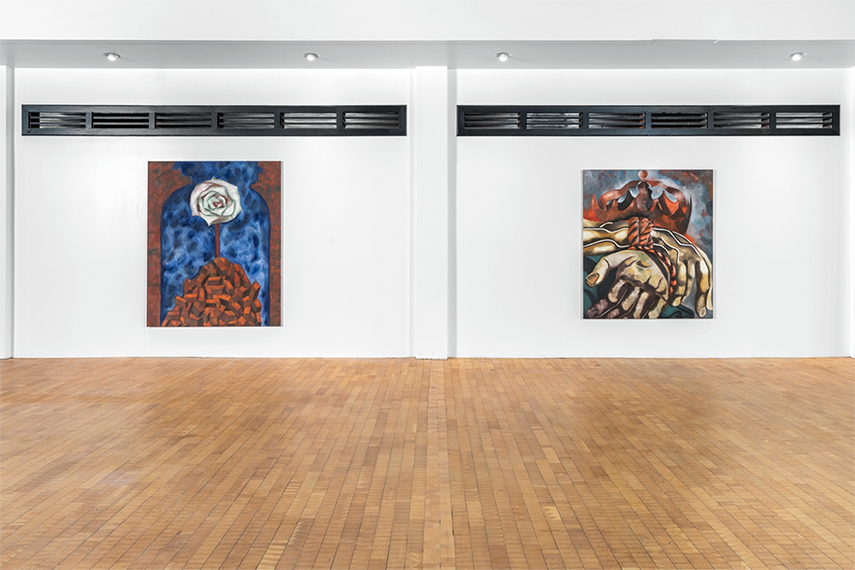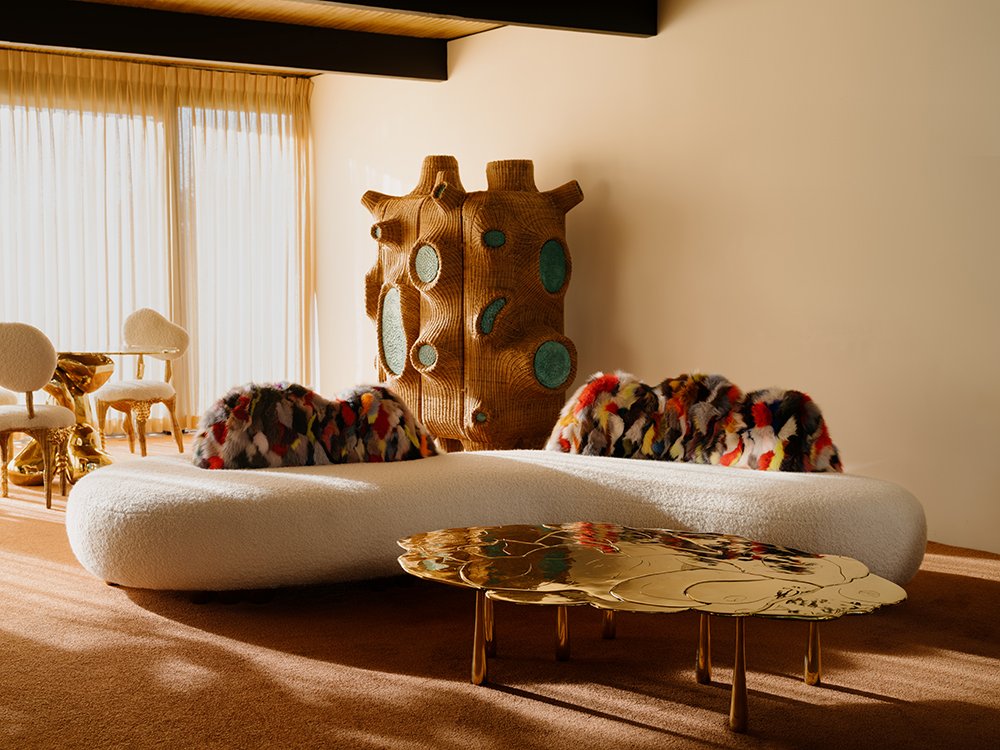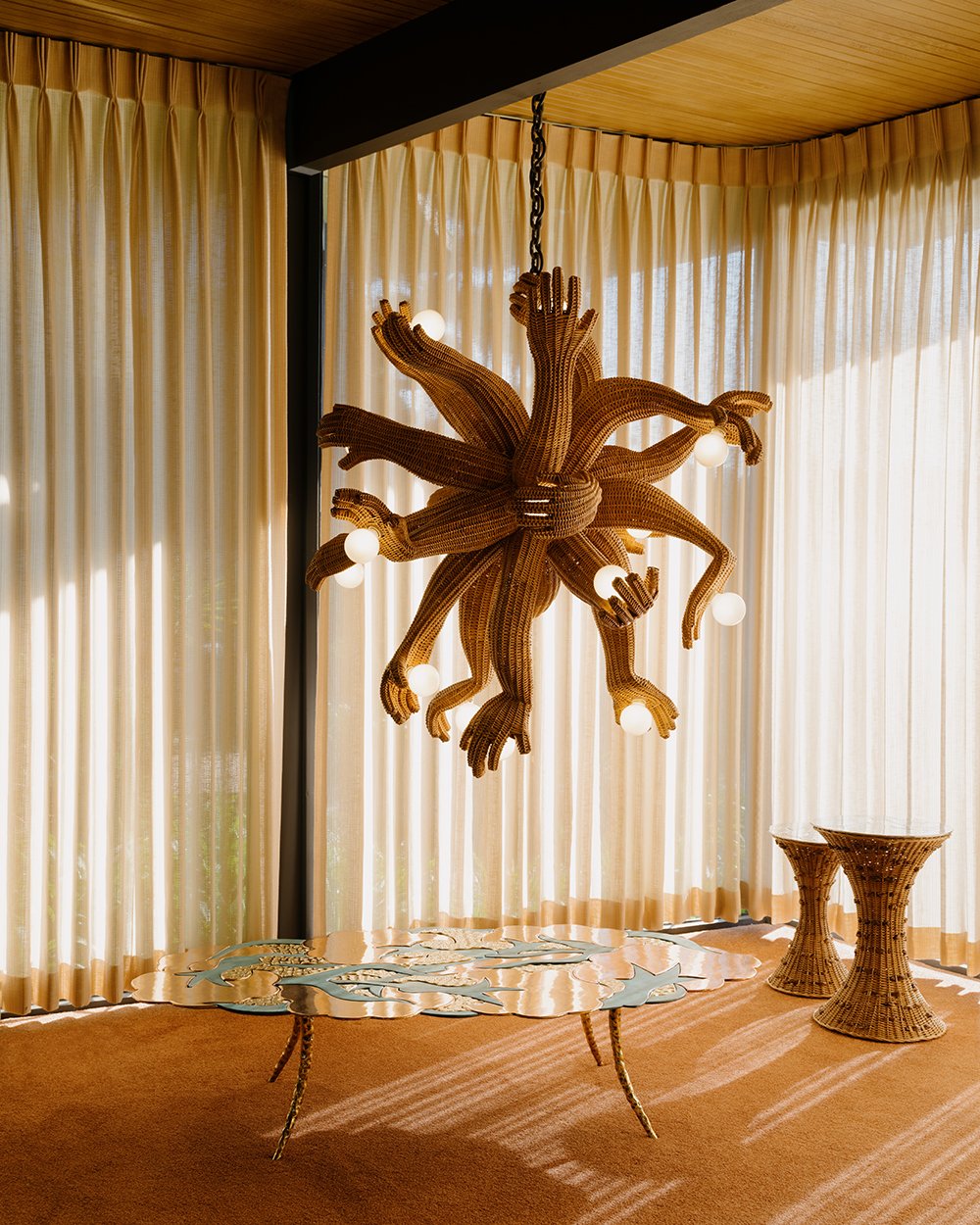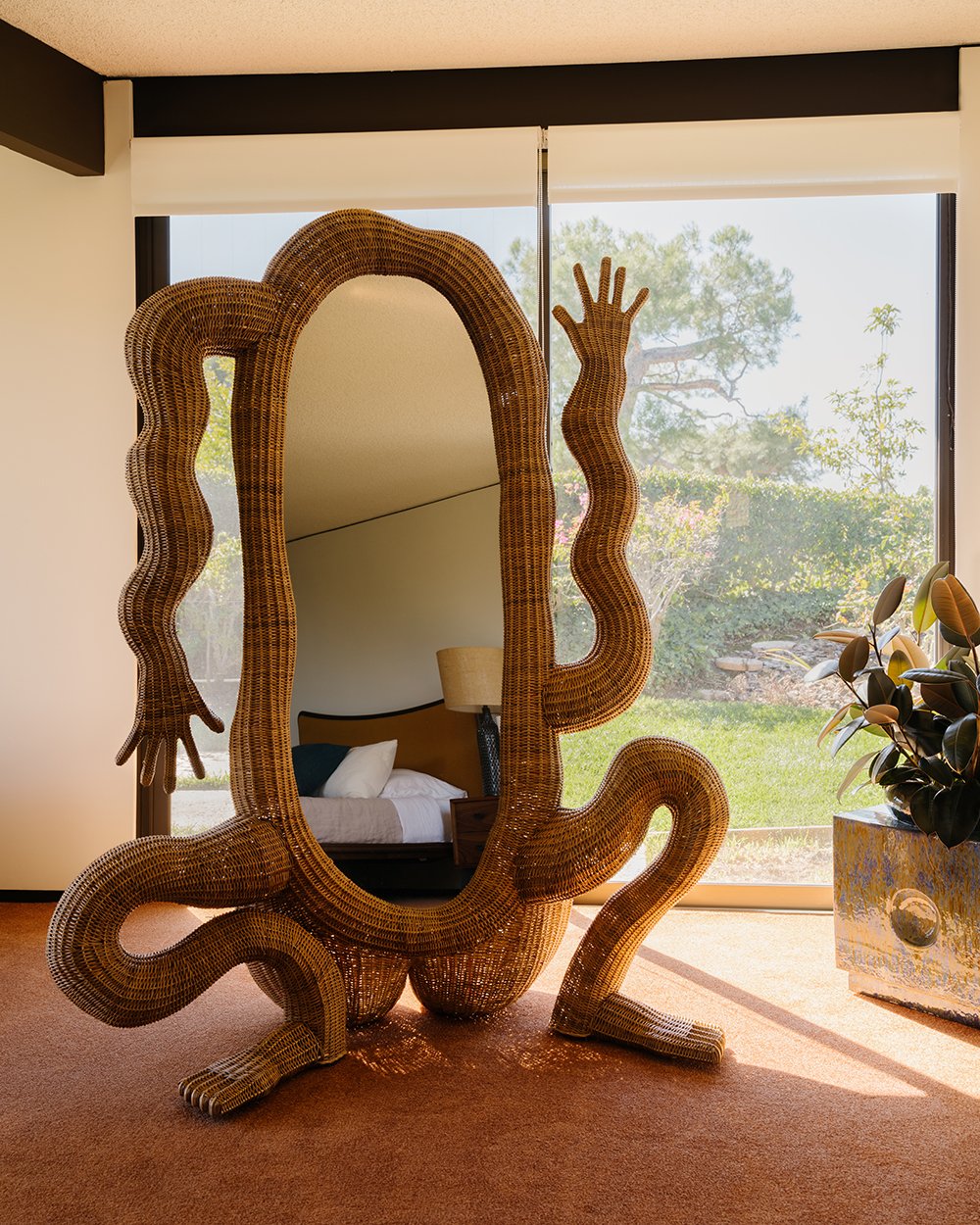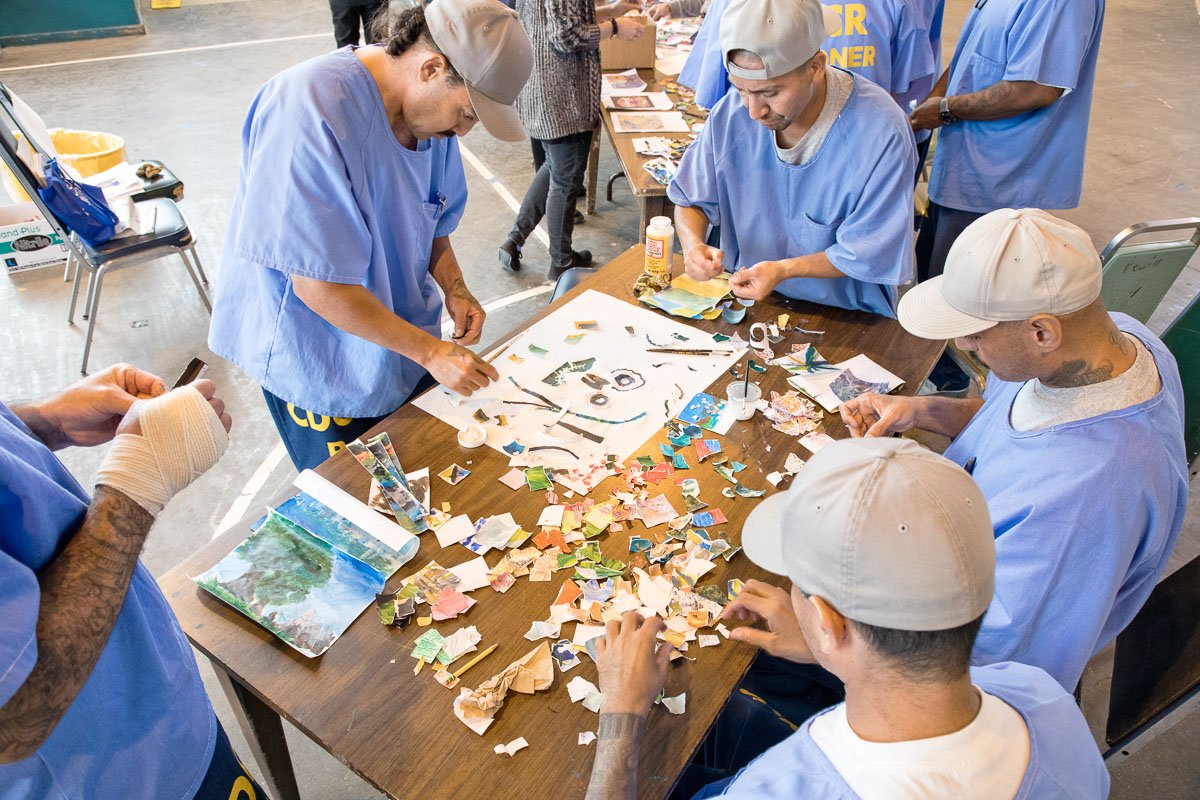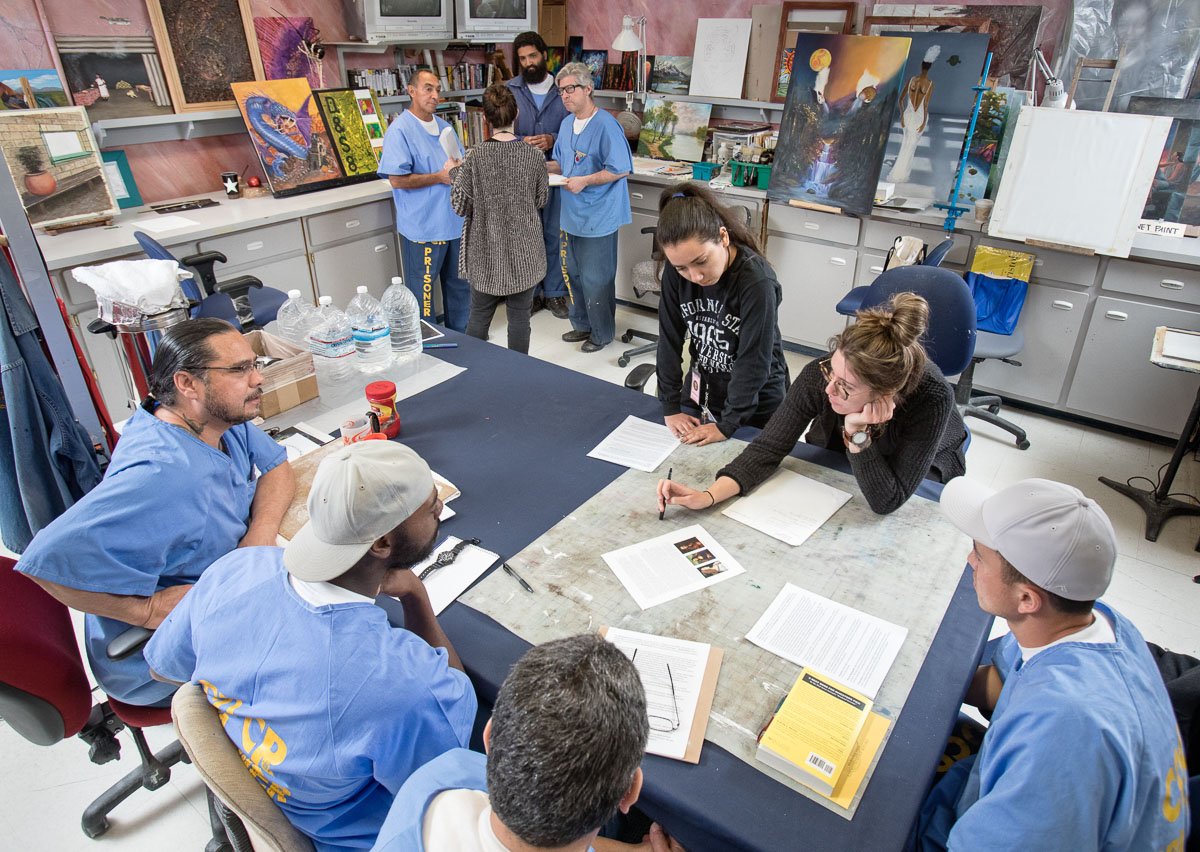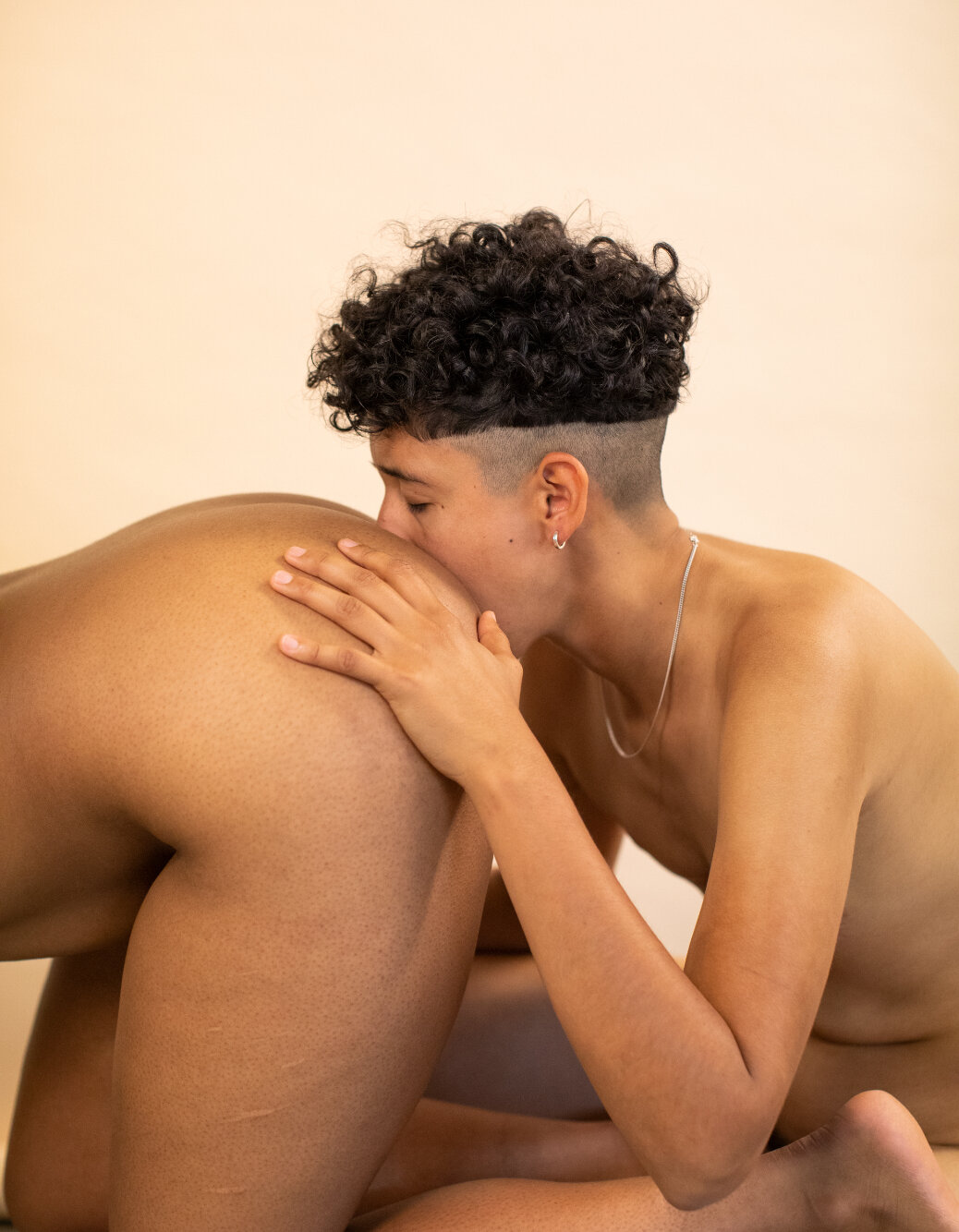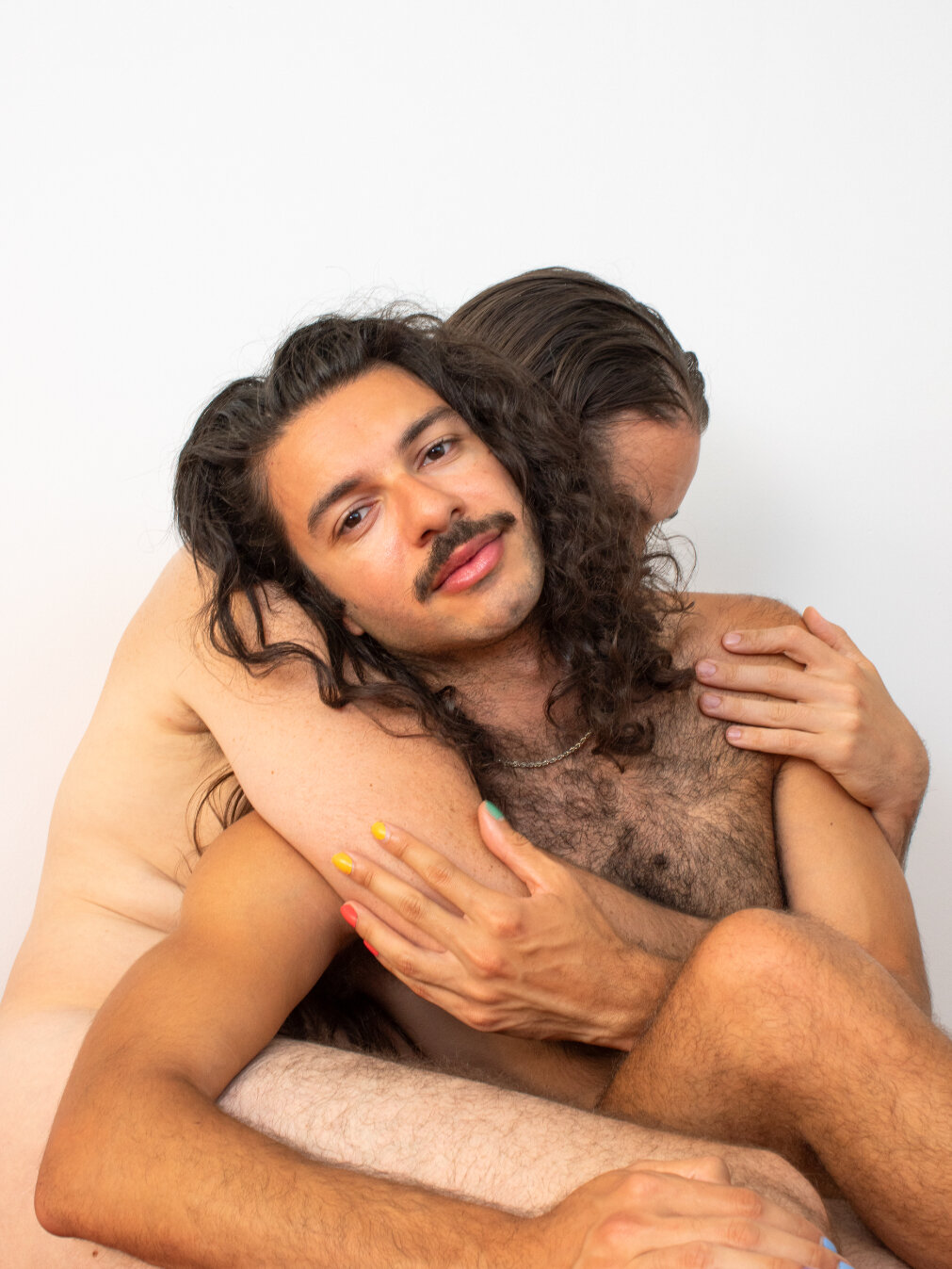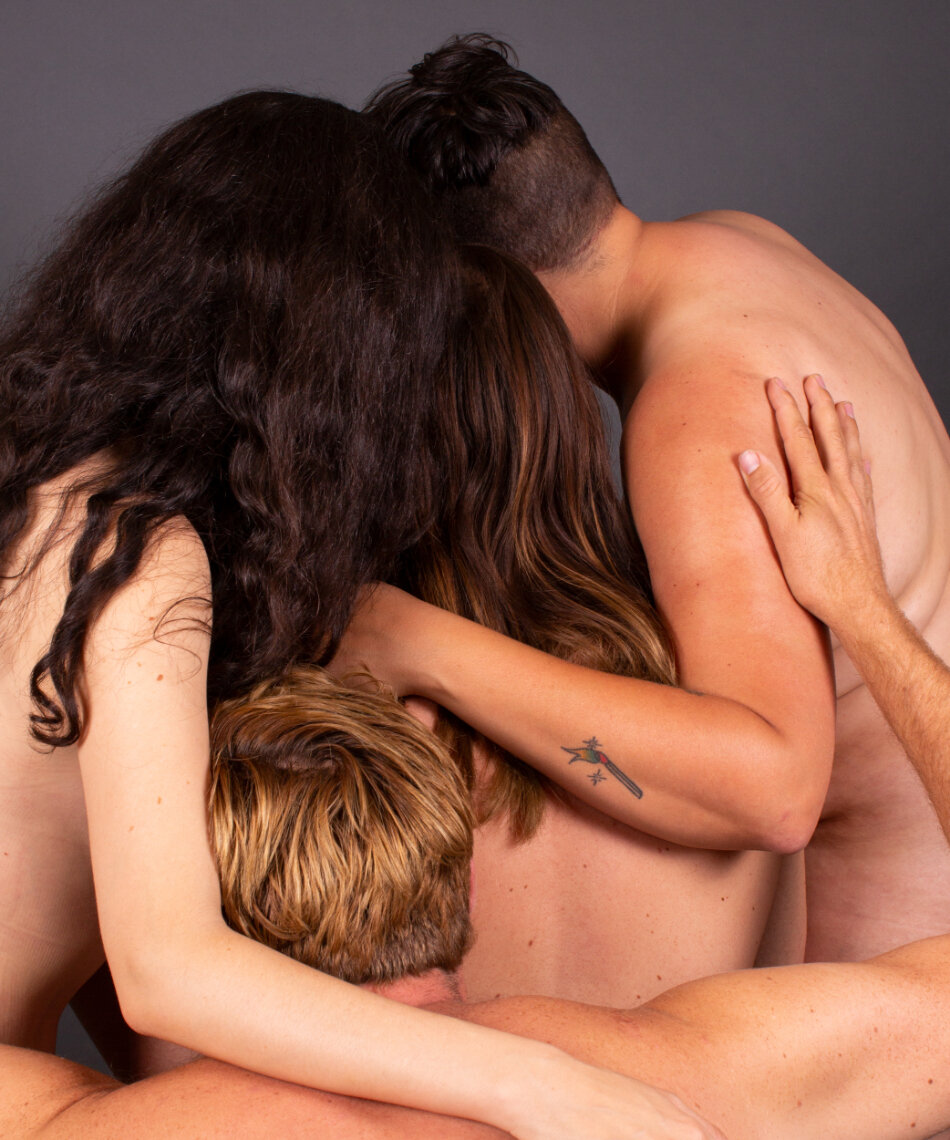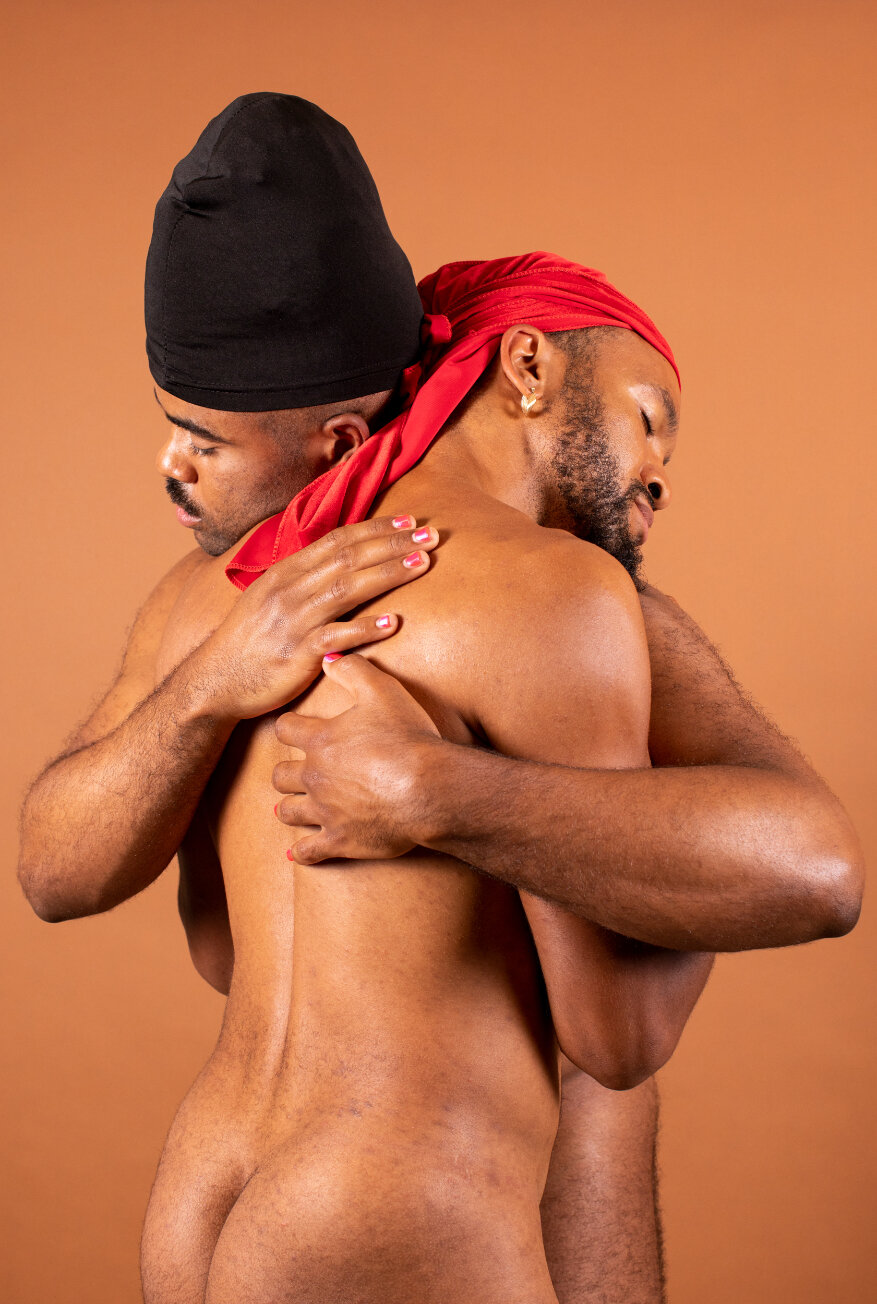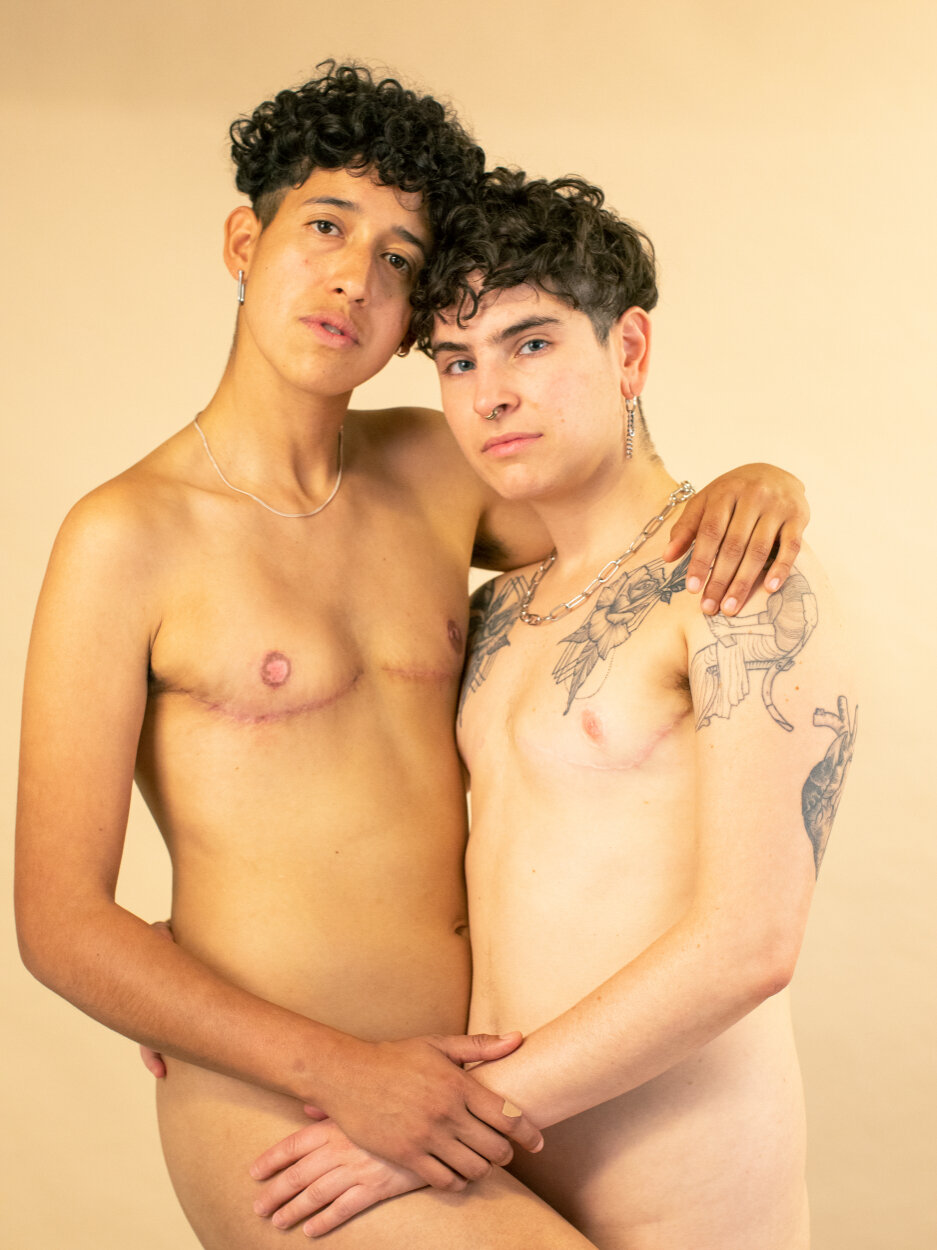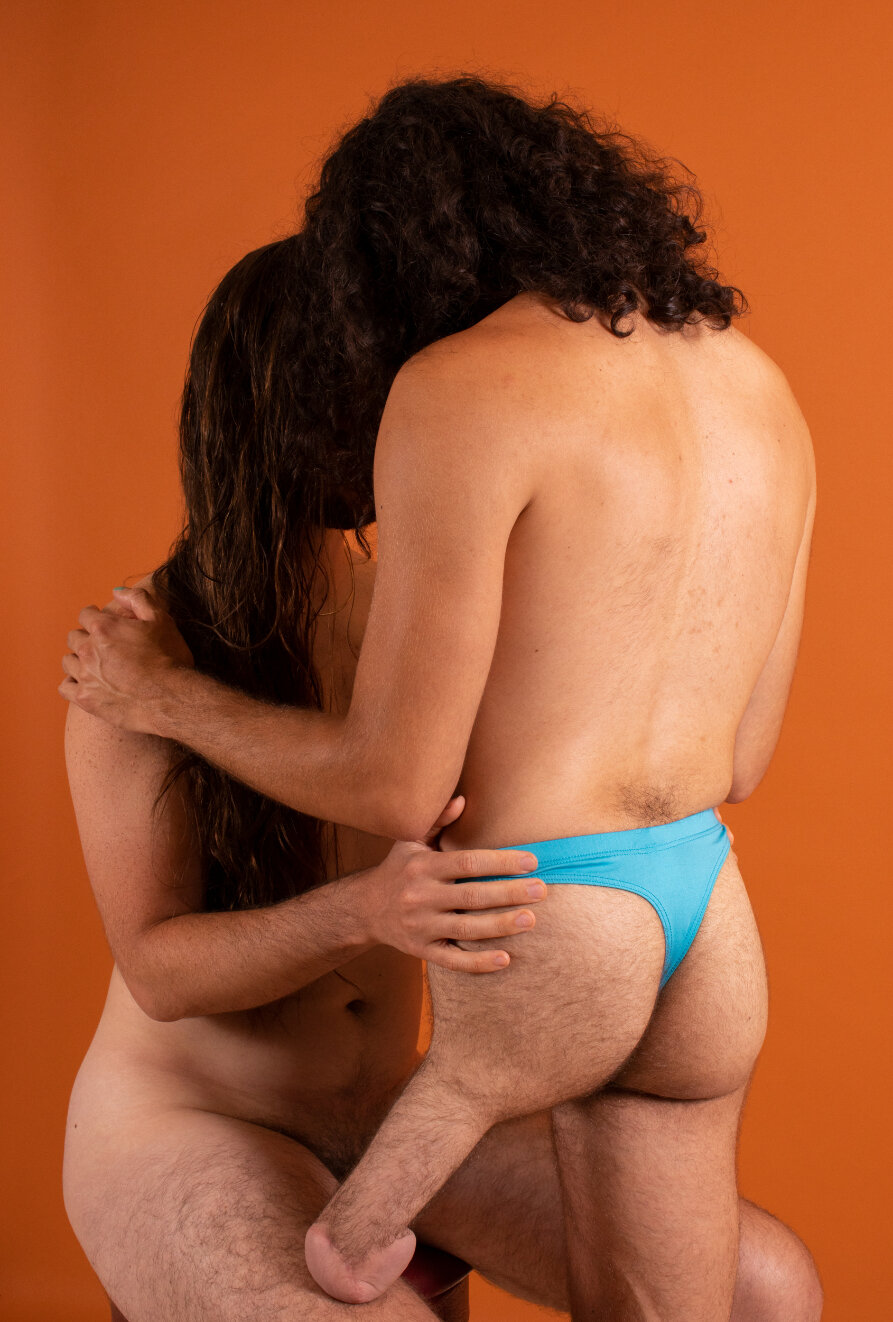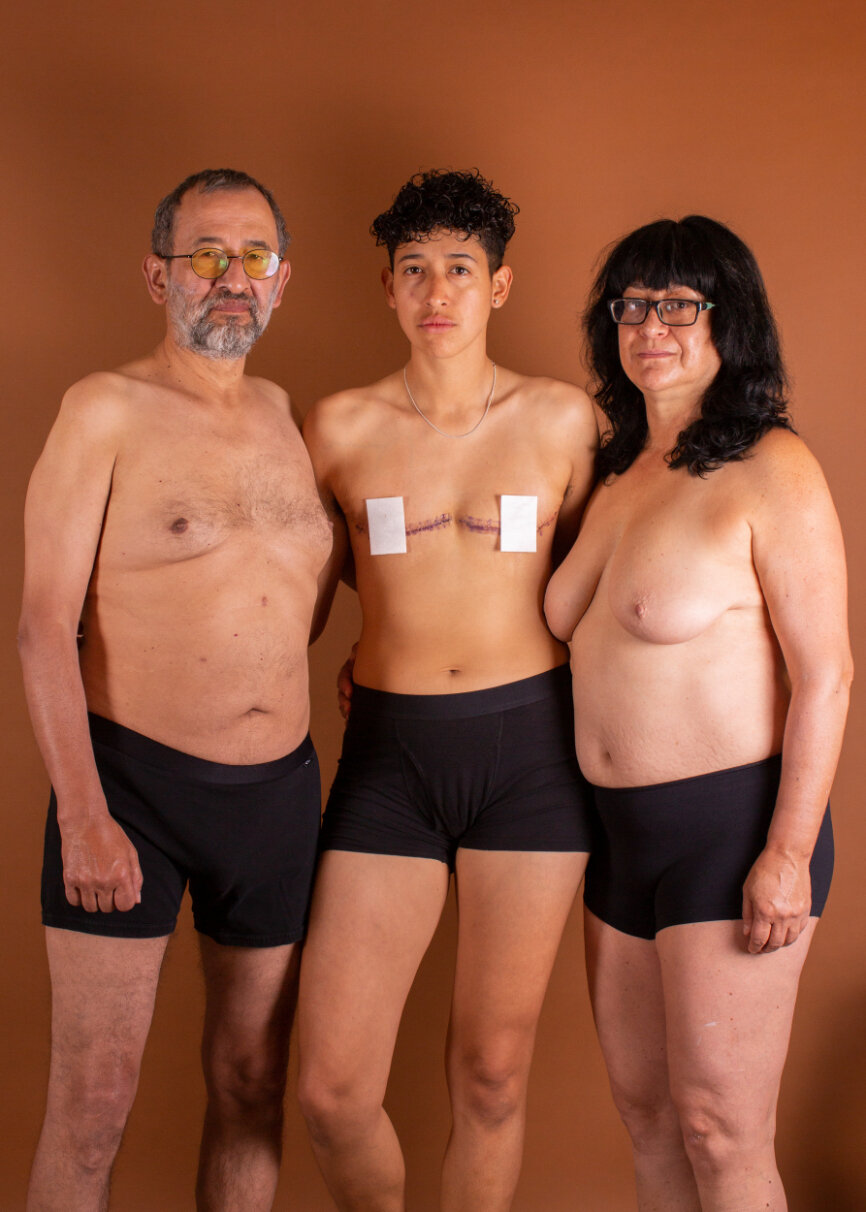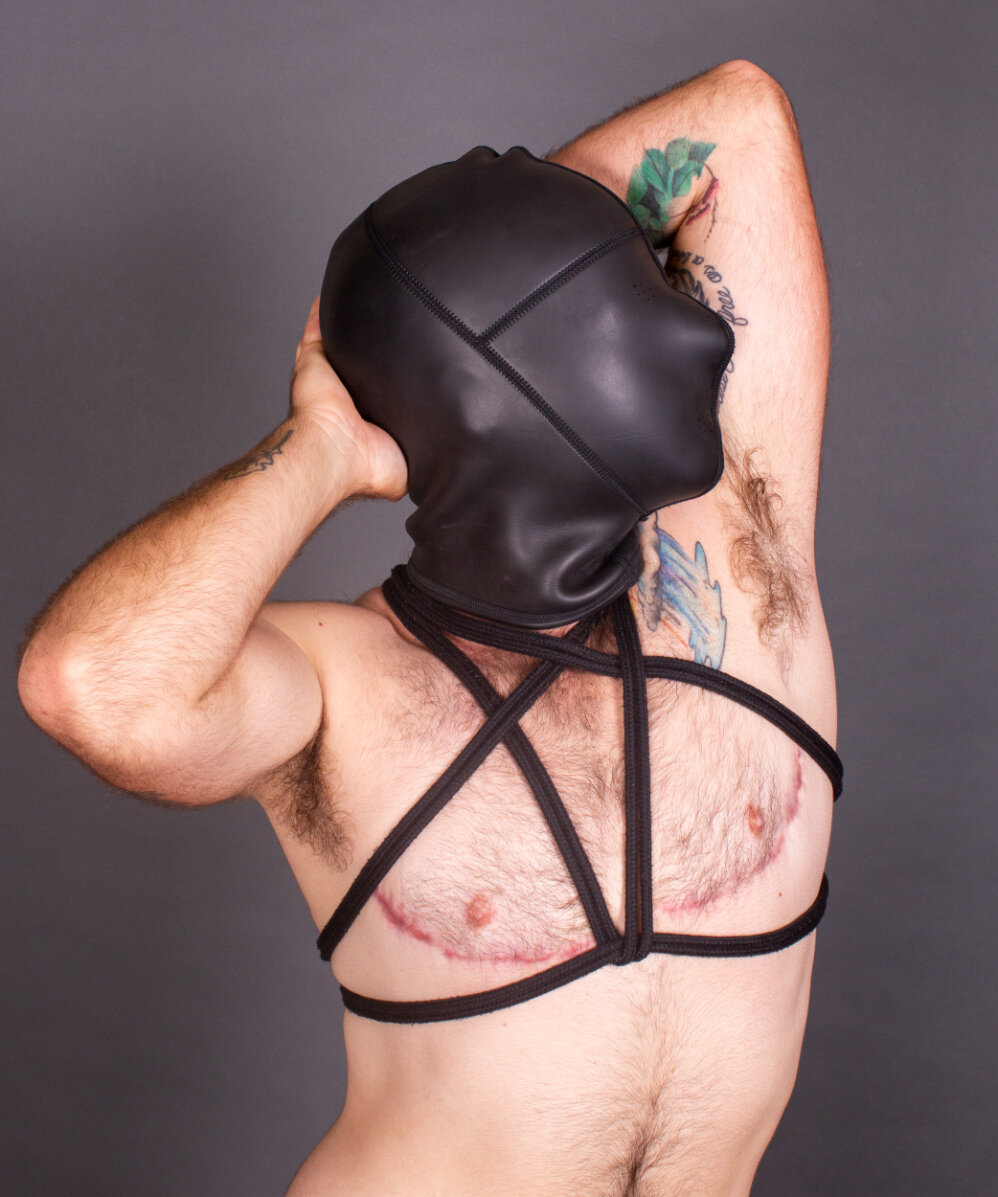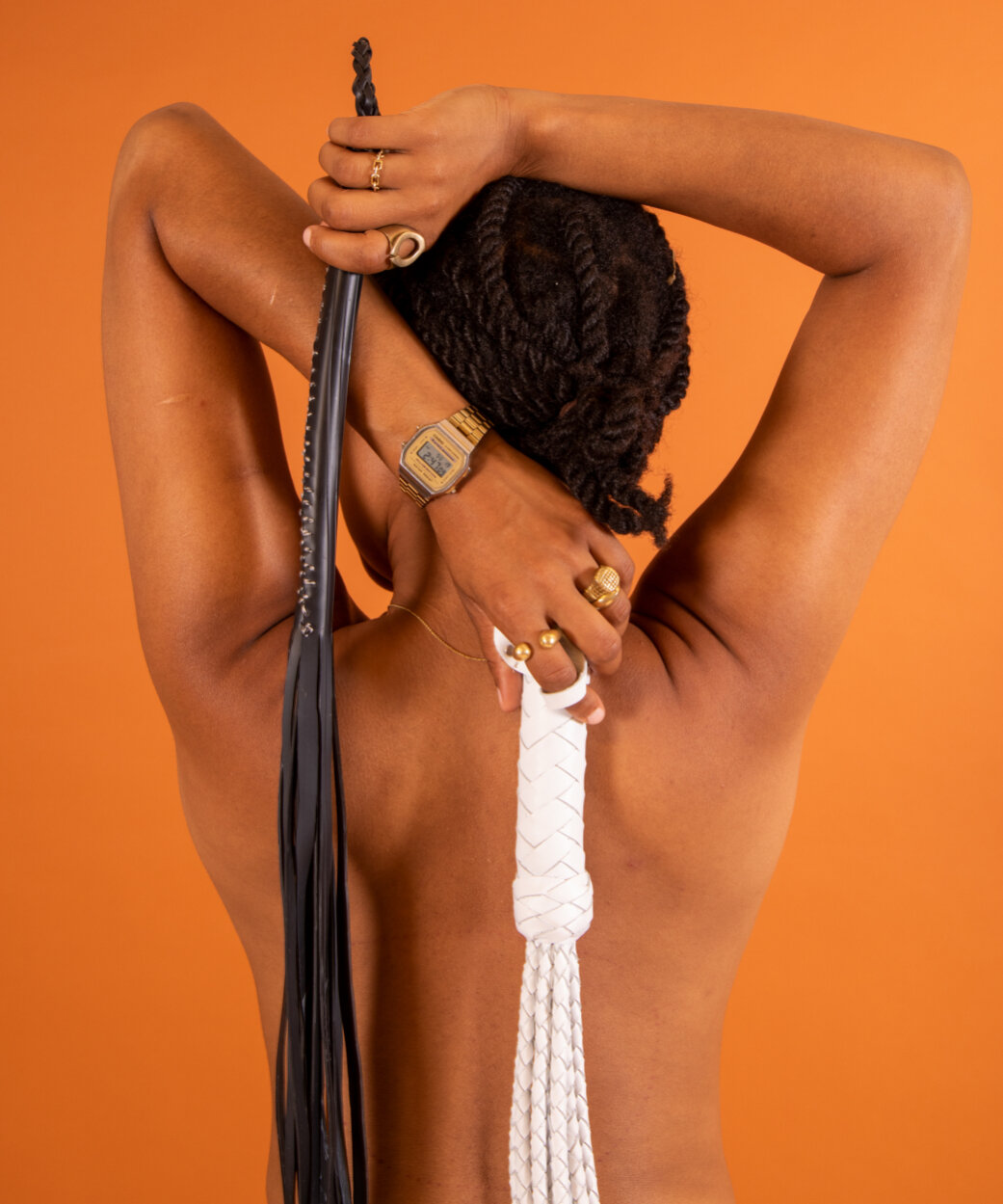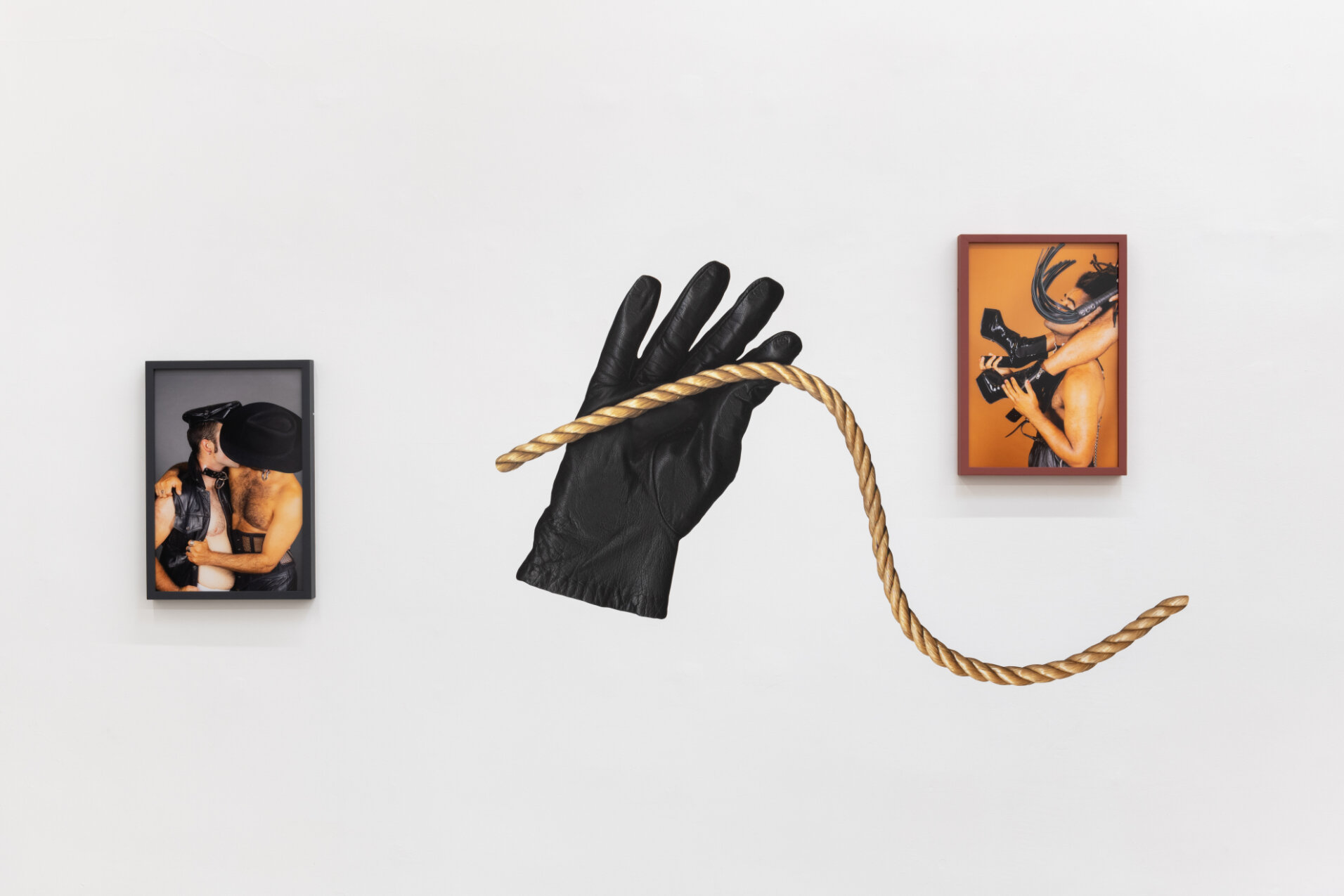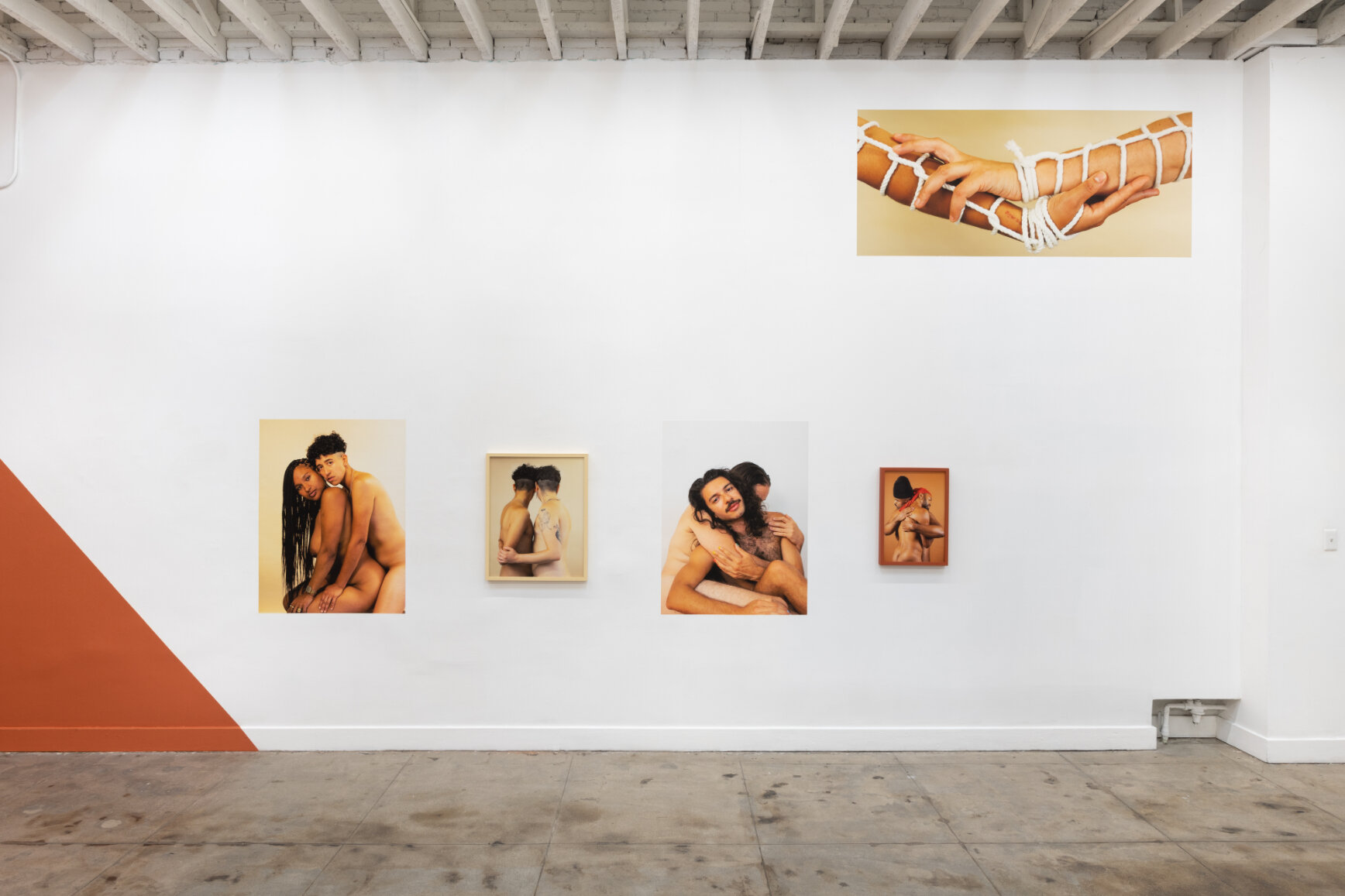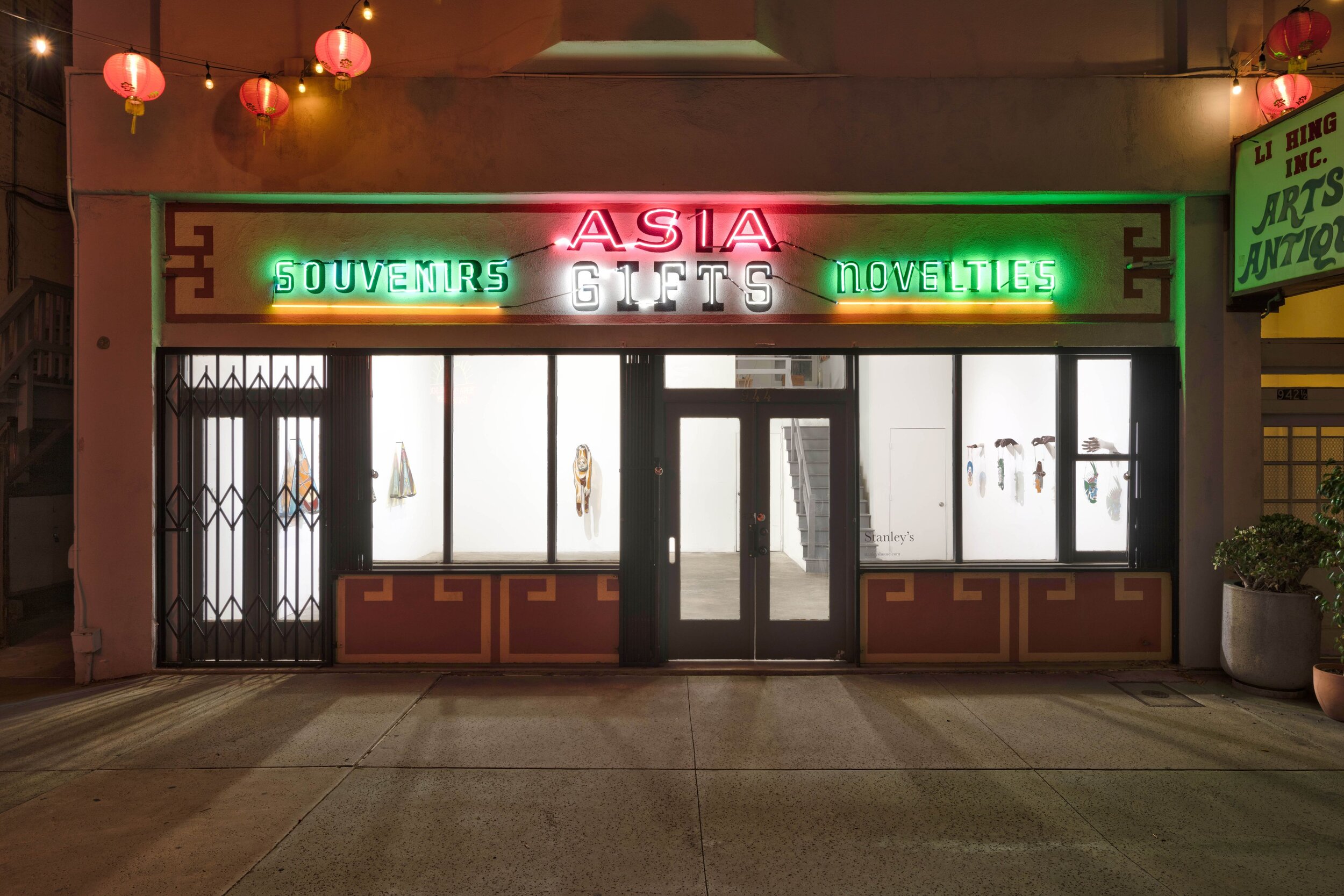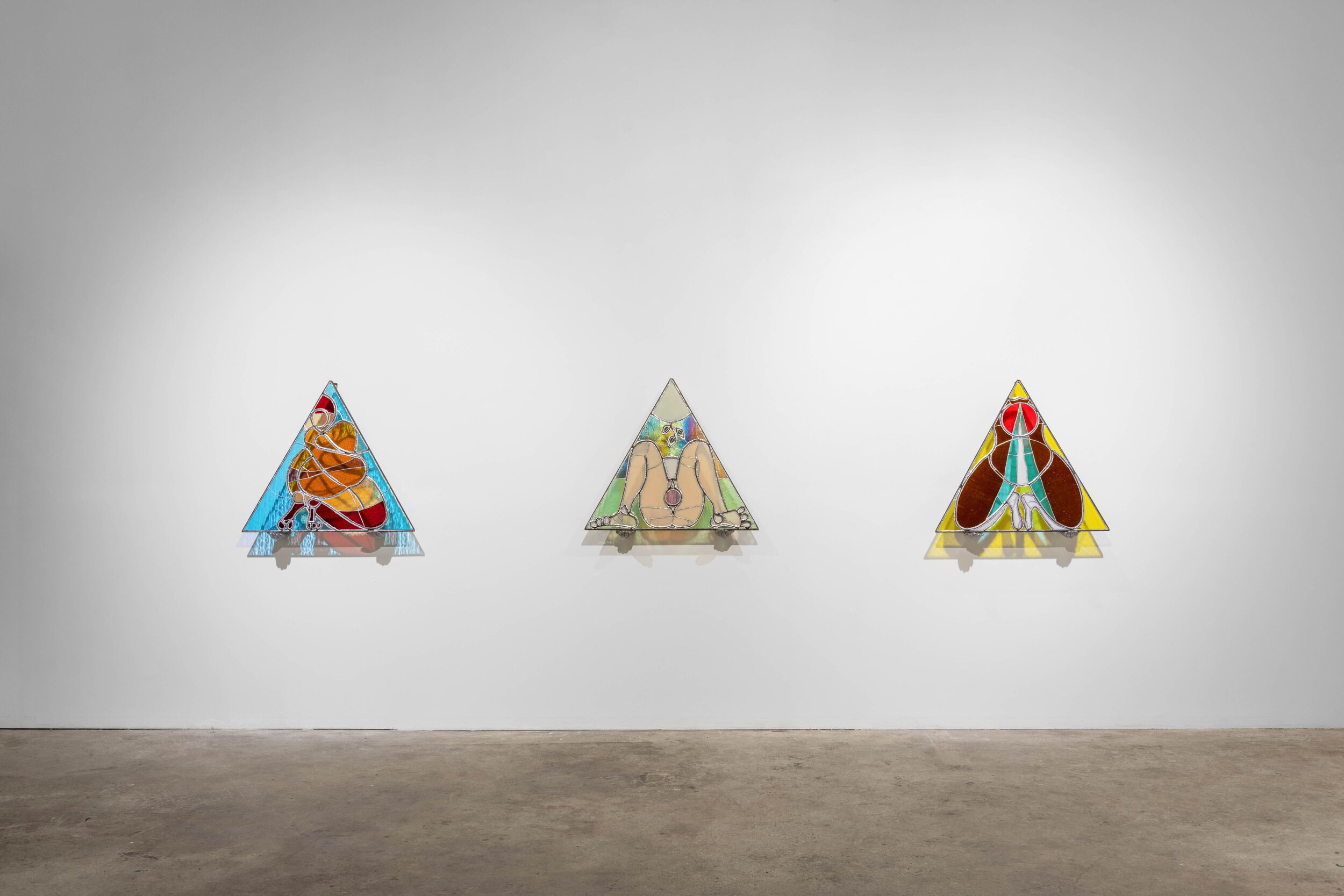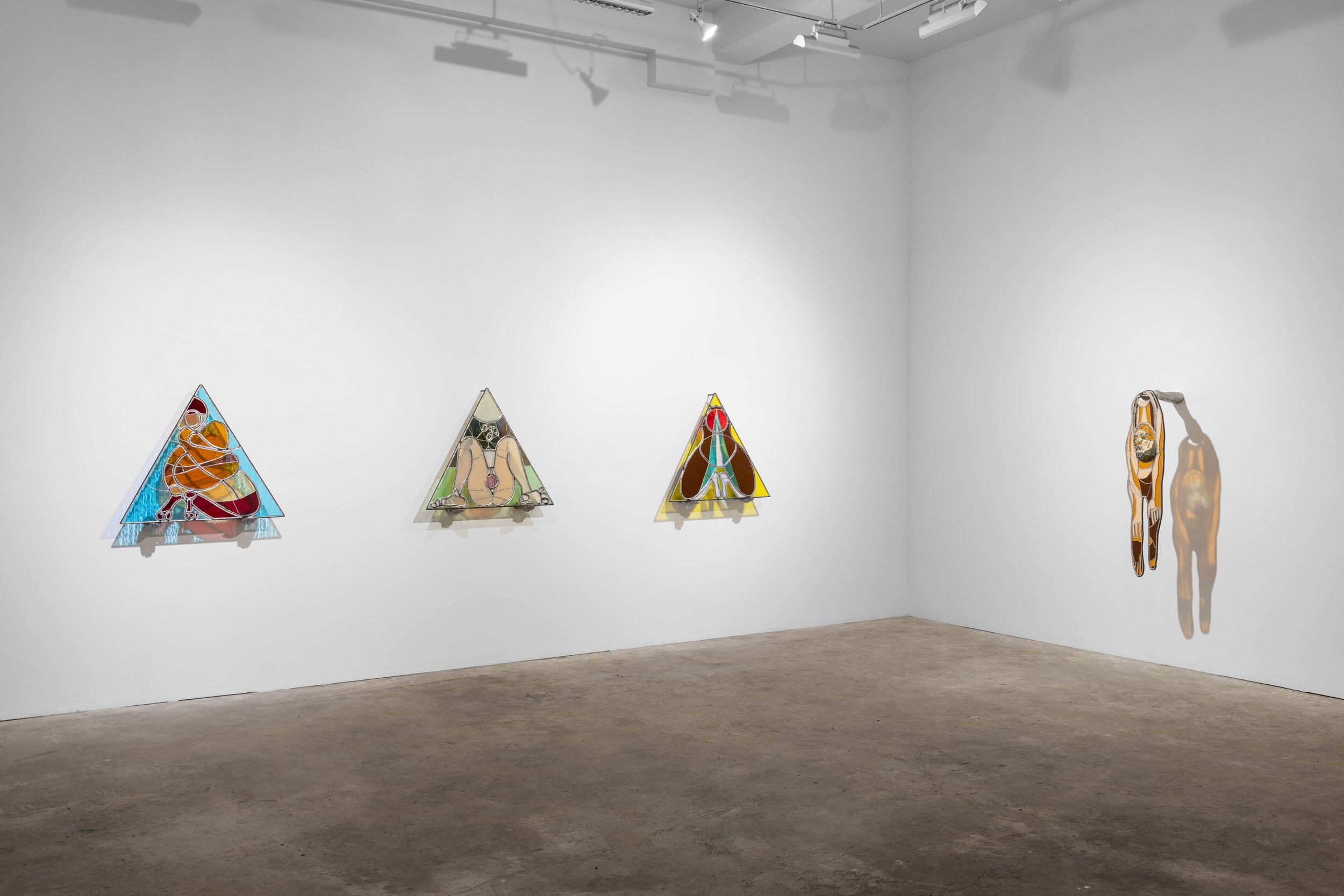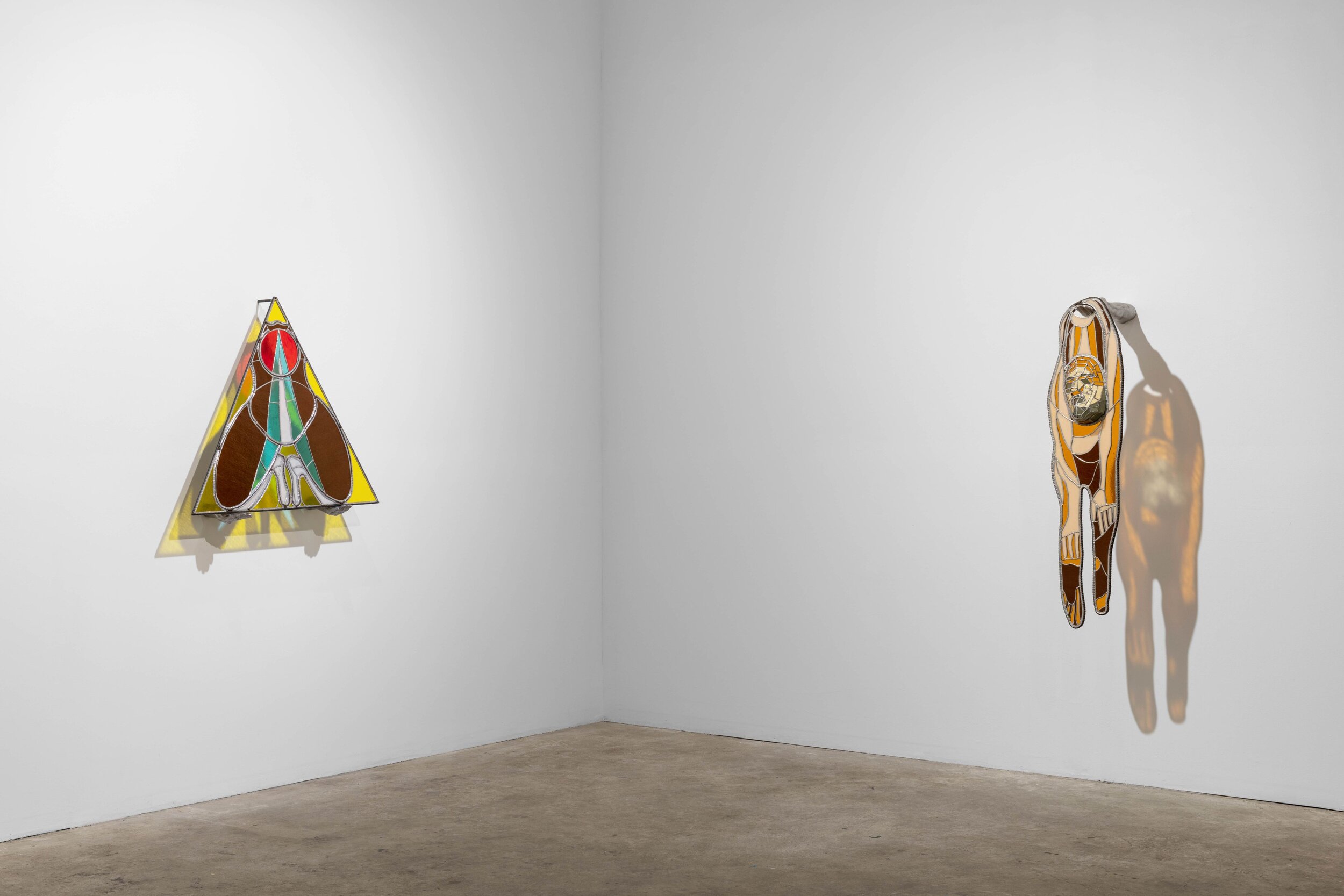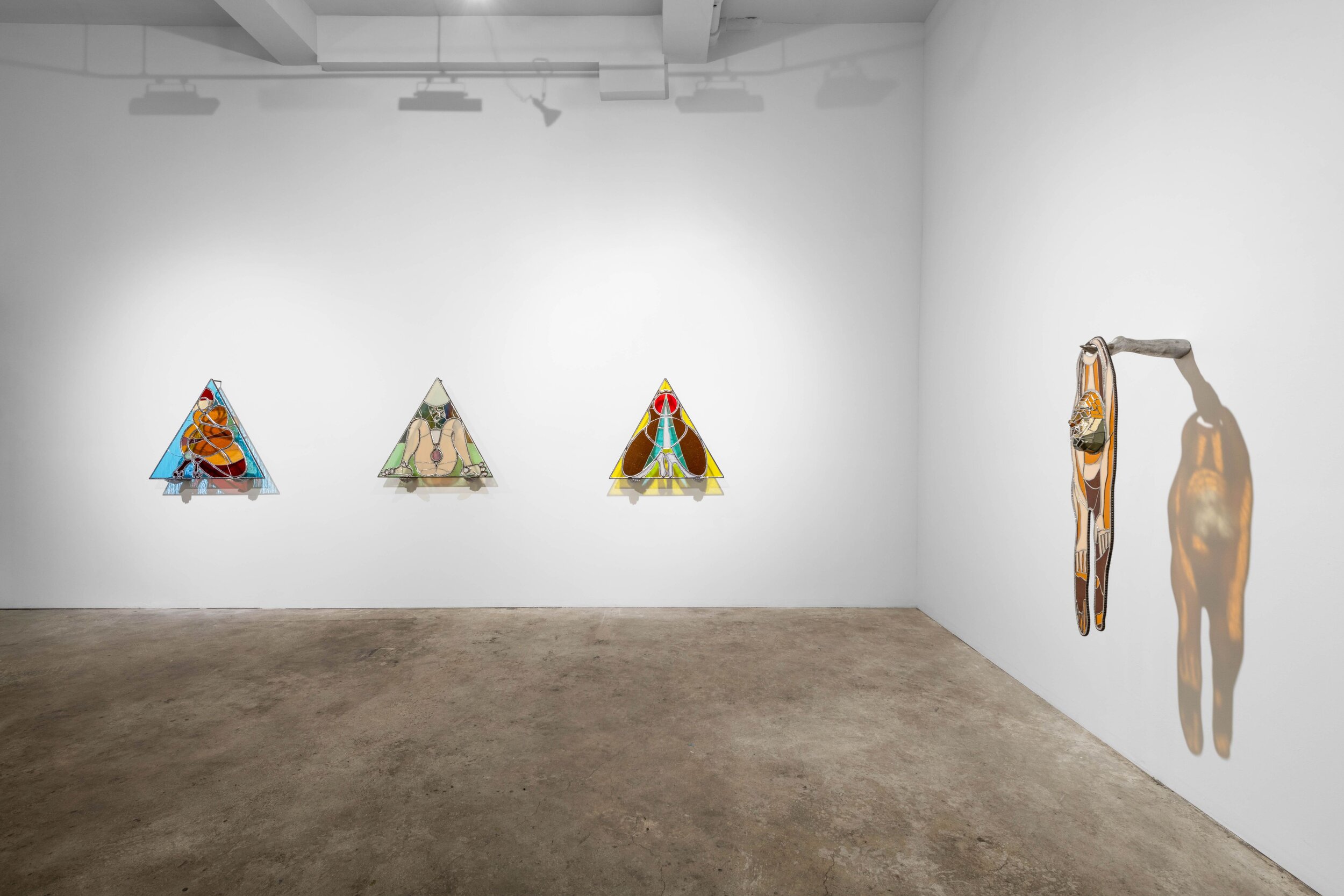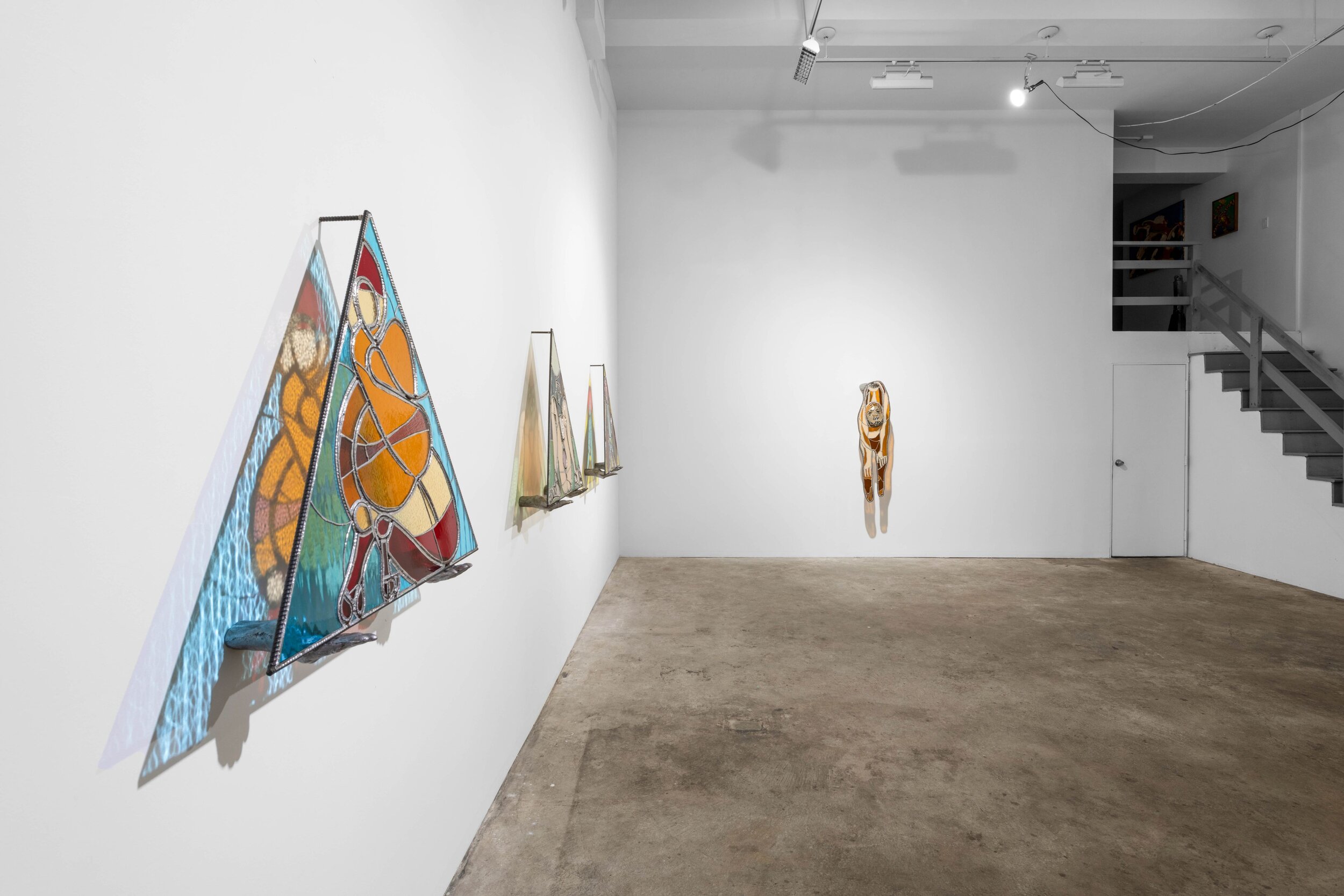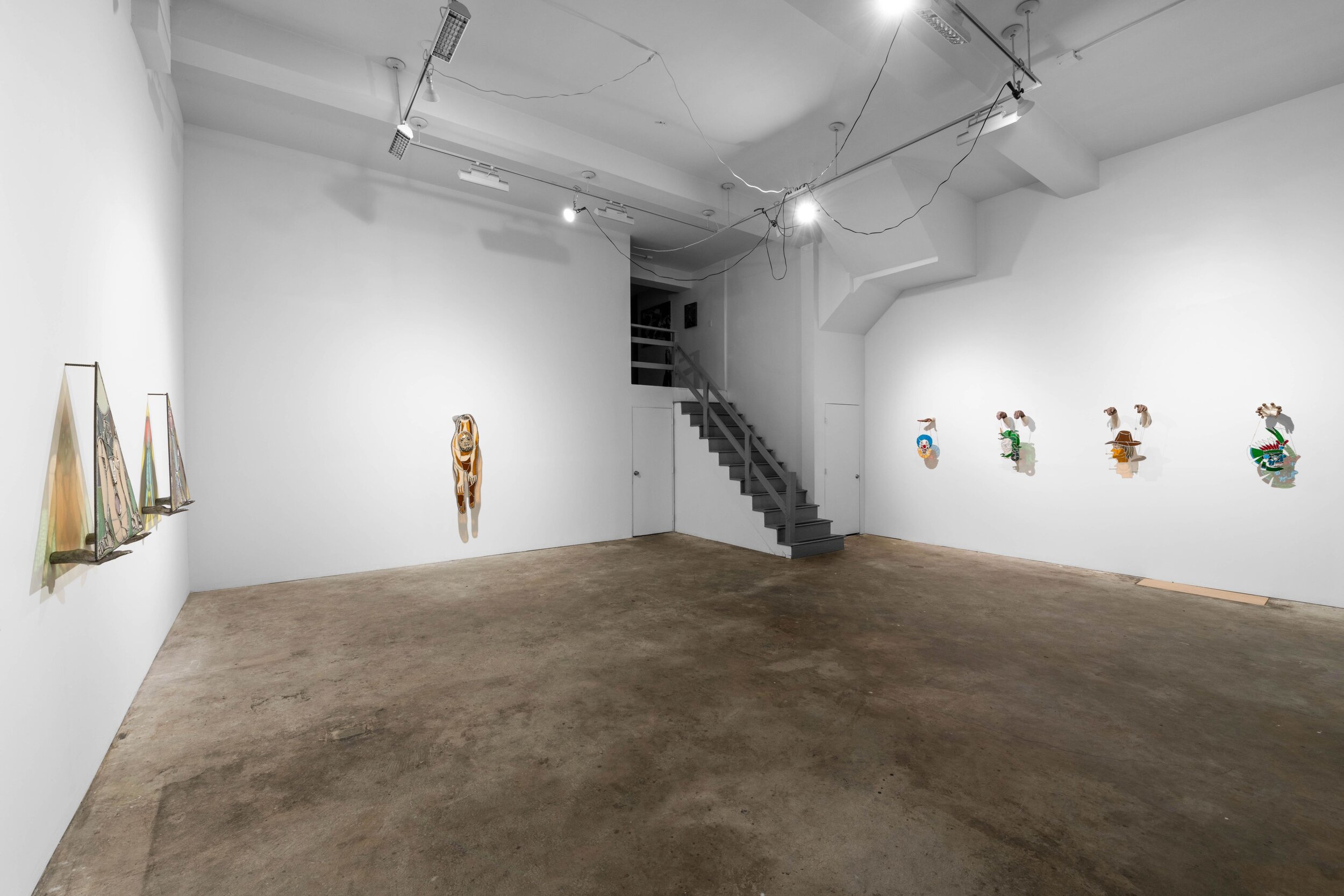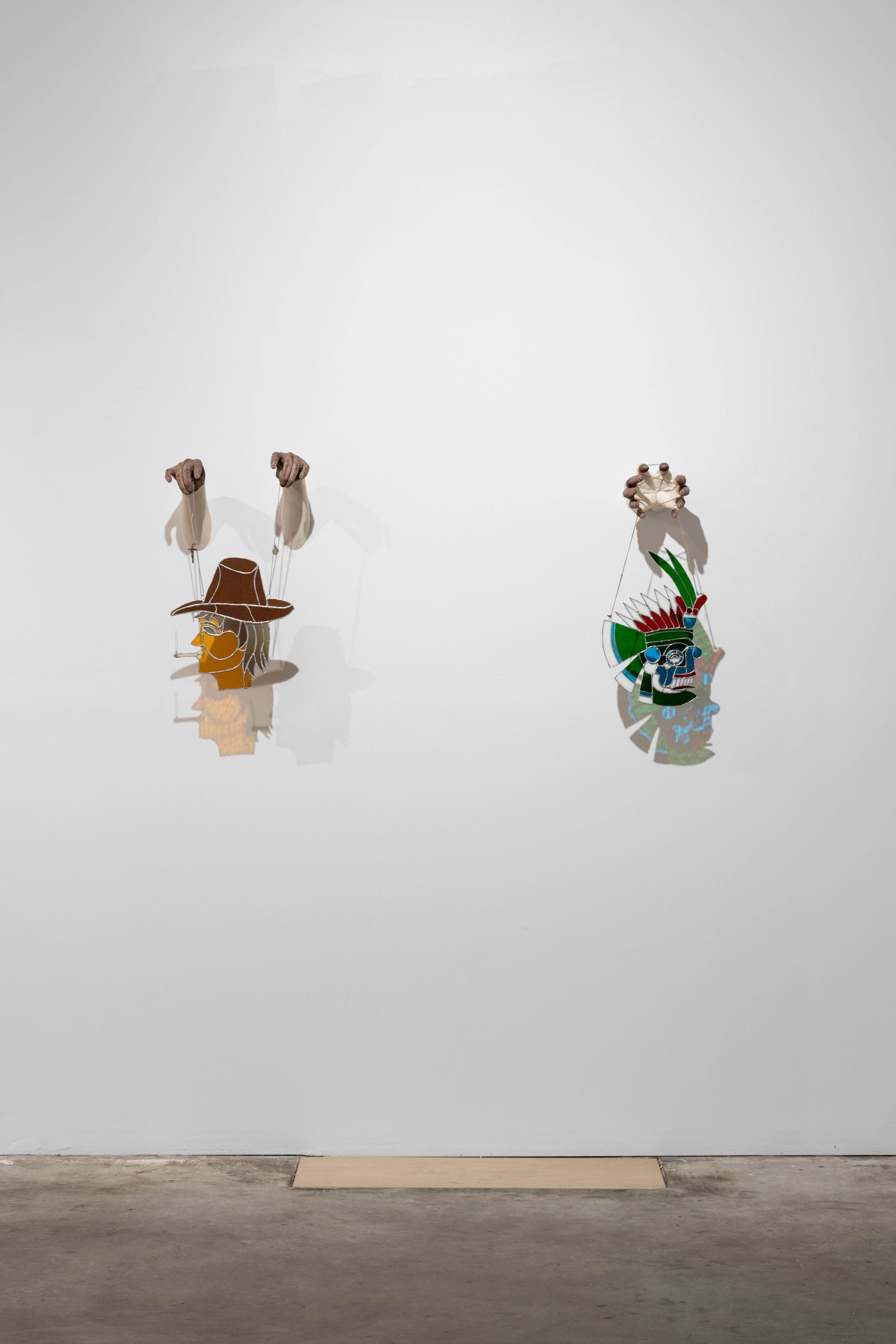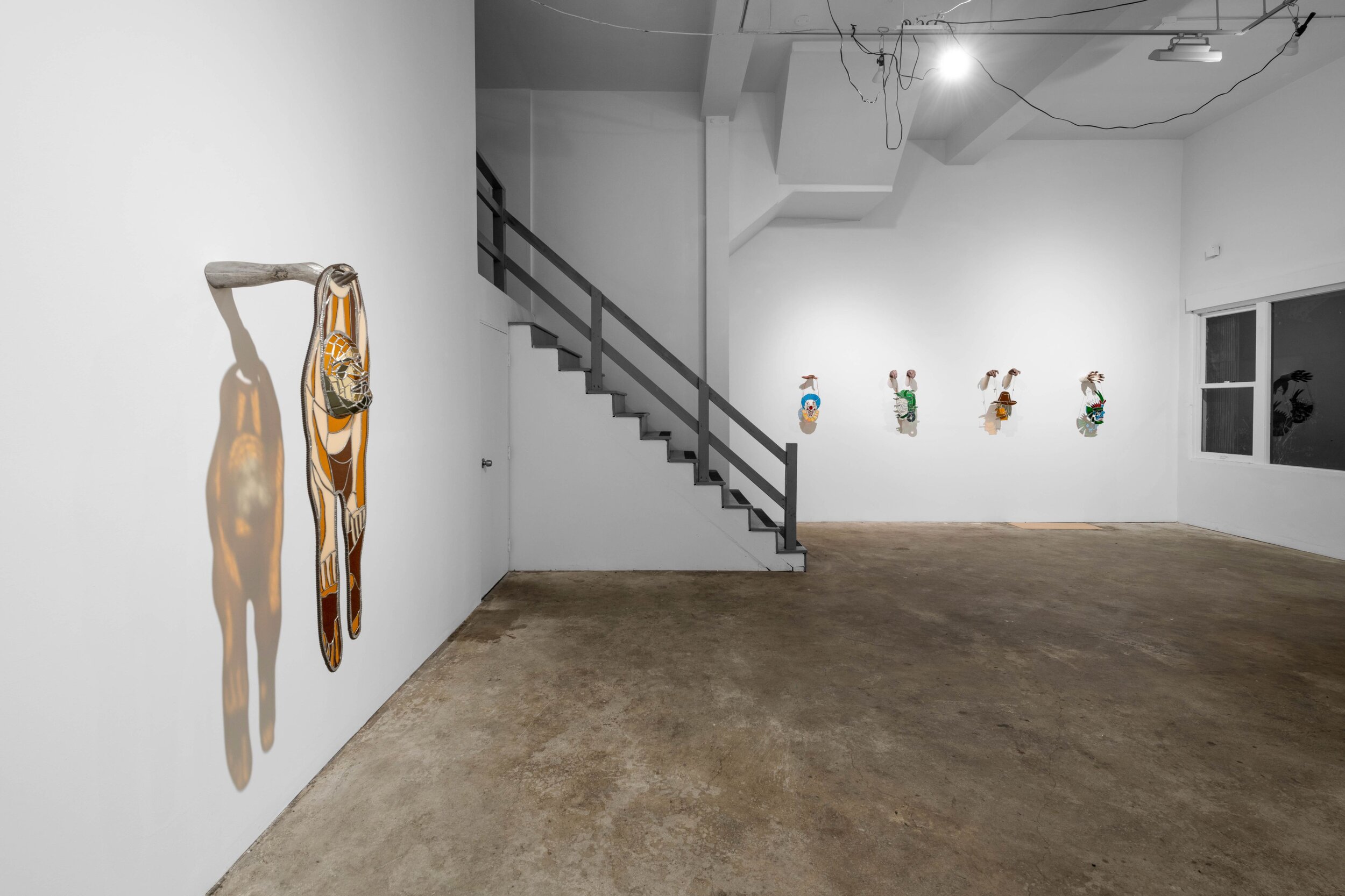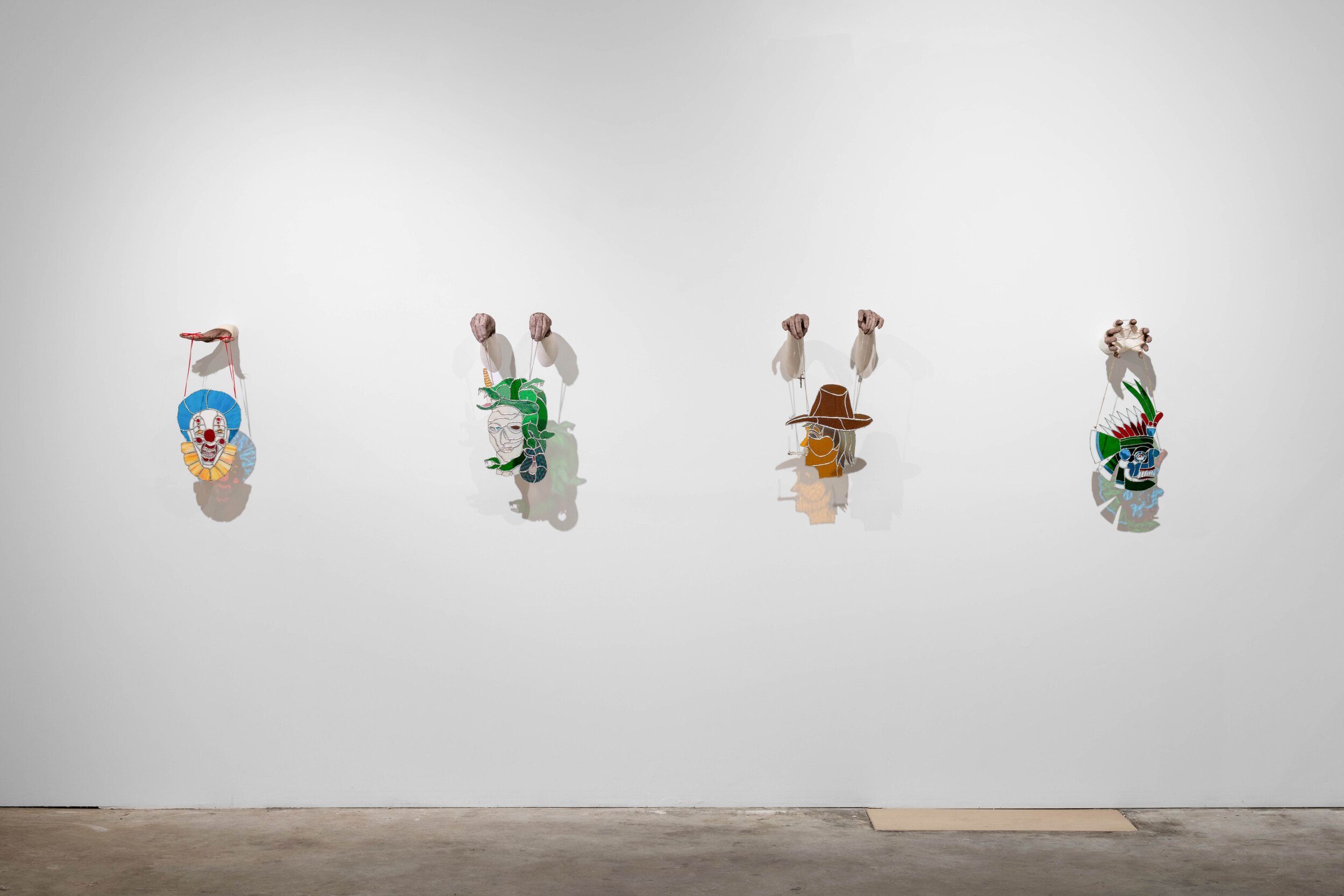Click here to read.
Read Our Interview Of Ayako Rokkaku On The Occasion Of Her Solo Booth At Frieze Los Angeles →
Click here to read the interview.
Tori Wrånes Presents Mussel Tears @ Shulamit Nazarian, Los Angeles
As a synesthete, a person with a condition of combining senses such as seeing color and form in sound and language, Tori Wrånes visualizes sound into a sculptural and physical dimension. This experience allows the artist to use sound to dictate the form of painting and sculpture and, in turn, she also visualizes objects through vocal projection. Mussel Tears premiers sculptures, paintings, sound, and performance together to evoke dream-like narratives, where the familiar becomes fantastical. The exhibition has developed from the artist’s ongoing observation of what she describes as “the quiet outcasts of society,” referring both to elements of nature and personal relationships. The works in the show visualize a sensory experience of the world.
Wrånes’ unique method of communication, using sound and form to convey primal emotions and truths, bypasses the structural hierarchies of language and rational thought. The result is a wide-ranging, experimental, and ritualistic practice that guides us outside of our known world. The works in Mussel Tears situates the self in relation to other beings, both human and non-human, and illustrates how our understanding of the world is constantly mediated by our own bodies. Throughout her practice, Wrånes sews together our senses, asking us to consider how we might privilege the overlooked in any form.
Tori Wrånes is on view now through March 12 @ Shulamit Nazarian 616 N La Brea Ave, Los Angeles.
Yuri Yuan Presents "The Great Swimmer" @ Make Room in Los Angeles
In the past year, Yuri Yuan has often dreamed about water. Sometimes she sees a sinking ship, sometimes in a quiet ocean. Often, she finds herself on a diving board, perched over a blue swimming pool. Yuan’s latest body of work is titled "The Great Swimmer" after Kafka’s fragment of the same title. These limpid canvases explore different aquatic landscapes, but they most often return to the landscape of the swimming pool, with its diving boards, tiles, and changing rooms. Yuan tapped into her memories of swimming lessons she took at age 13, having just moved to Singapore from China. These classes were a minefield of linguistic, bodily, and emotional alienation– not unlike the alienation expressed by Kafka’s swimmer.
"The Great Swimmer" marks a watershed moment in Yuan’s practice. Working in a consistently larger format, the works showcase the influence of cinematic narrative on the artist’s practice. Fascinated by the intricate visual constructions of filmmakers such as Wes Anderson and Wong Kar Wai, Yuan’s new works seek to understand the innate connections between narrative and aesthetics. "The Great Swimmer" also takes influence from the deep ultramarine palettes of the Italian Renaissance, as well as the figural masterwork of French Romantics such as Géricault. "The Great Swimmer" presents a narrative in two sets of fragments, hopping between visions of the internal and external, the literary and the cinematic, the real and the dream.
Yuri Yuan is on view now through February 12 at Make Room 5119 Melrose Ave, Los Angeles.
Brian Wills Presents New Wall Works @ OCHI Projects In Los Angeles
In his first solo exhibition with OCHI Projects, Brian Wills presents twelve new wall works intentionally placed throughout both galleries. Building upon the artist’s unique visual vocabulary of thread, paint, and wood, Wills’ new work evokes experiential understandings of line, color, space, and object as he aligns his practice with minimalist abstraction, the subversive history of the monochrome, California Light & Space, and other art historical paradigmatic shifts. Singular strands of thread are delicately wrapped around wooden substrates, eventually creating surfaces that appear to vibrate and shift depending on available light, thread density, the architecture of the panel, and the motion of the viewer.
Wills is acutely aware of how a viewers’ brain will react to his work. The visual cortex interprets received visual data—color, motion, texture, and depth—precisely the fundamental properties that Wills engages. When exposed to pattern, the brain extrapolates as it habituates, for example when assuming that a vertical line of brown thread will repeat as it did thousands of times in a row—the works in OCHI Aux exemplify these principles. Deliberately skipped threads or a shift from warm to cool red thread are intended to reveal moments of intuition and intention, while indicating methods of construction. Expectations are constantly at play. Engaging with one’s own perception is always a gift, offering moments of joy, wonder, and self-reflection—in other words, investments in observation are rewarded handsomely.
Brian Wills is on view through March 12 @ OCHI 3301 W Washington Blvd Los Angeles.
First Look: Amor Corp Presents "Salon" A Curation Of Art and Design by Noemi Polo
AMOR CORP presents SALON, a site-specific collection of art and design curated by Noemi Polo in a domestic environment featuring works from both local and internationally established artists and collaborators. Set in a newly completed residential project by SCI-ARC grad collective, PENTAGON, this exhibition occupies Milwood Avenue, arguably one of the most architecturally relevant residential neighborhoods in both Venice and Los Angeles. On public view from Tuesday February 1st through February 14th, SALON features over 100 objects from more than 50 artists and collaborators- a collection resembling that of an imaginary persona that would potentially inhabit the home. Understanding PENTAGON’s focus on new, speculative approaches to building design, pragmatic inquiry into context and location, SALON plays as both a showroom and conceptual art exhibition, including works that are in direct conversation with the home’s unique design through their textures and forms. Notable artists include Jordan Wolfson, Gaetano Pesce, Cody Critcheloe and more. Race Service, as a partner in the exhibition, will showcase a rare NASCAR vehicle alongside a custom painted race car in the garage. Click here to make an appointment. Photos by Ed Mumford
Theodoulos Polyviou & Dakis Panayiotou Present Transmundane Economies @ Künstlerhaus Bethanien In Berlin
Bellapais Abbey, a ruin of a monastery in northern Cyprus built in the 13th century, is the subject of investigation for the site-specific virtual installation Transmundane Economies. A relic of many lives, following the different colonial periods over the centuries, the monastery went through changes, architectural but also cultural, organizational and operational.
Theo & Daki address the long-lasting shape-shifting history of Bellapais Abbey to discuss the codes and hierarchies that over the years have been established and inscribed on it. Starting from the architectural structure as well as the ceremonial use of the place while examining its narratives, liturgy and history, the artists speculate on the relation-ship between queerness, restoration and reinvention.
Visitors to the exhibition are immersed in the partial reconstruction — based on drawings by George Jeffrey from 1912 — of the Gothic refectory of the monastery by means of VR technology. Alternative paths and possible uses that deviate from colonial interventions of the past, become free and accessible in this way. The virtual architecture, which in its digital translation appears to be sacred, yet free of Christian intentions, in turn, exposes the socio-political fabrication of the monastery. Next to this conceptual grounding, by virtually transposing the site into the gallery space, the artists turn the ruin into an event rather than an object, proposing in this way an alternative to acquisition.
The Cypriot Orthodox Church exerts a strong influence on the political affairs of the island and participates in the instrumentalization of the national collectivity, often through the superintendence of gender and sexuality by claiming to protect the Greek Cypriots from ‘the ethnic other’ as described by Nayia Kamenou in her text Sexuality, Gender and Nationhood in Cyprus and hence exploiting the country’s postcolonial milieux. The queer community on the whole island is therefore not only subjected to marginalization based on their sexuality but all the processes of identity formation that constitute their bodies; race, class and gender. Transmundane Economies is an offer to discuss mechanisms of inclusion and exclusion, and think of the potentiality of any place to transcend its own physicality and hence escape its embodied ideological charge and power. Writer Jazmina Figueroa has been commissioned to arrange a sound piece for the installation.
Transmundane Economies is on view through February 6 @ Künstlerhaus Bethanien Kottbusser Straße 10
10999 Berlin.
Bedtime Stories In A Mental Asylum: Get In Bed With Tobias Spichtig →
interview by Janna Shaw
photographs courtesy the artist
When was the last time you stood up on a mattress, off-kiltered, aware of your balance, or lack thereof? When was the last time you jumped on a bed with friends? When was the last time you jumped on a bed with strangers? When was the last time you played childhood games? Cuddled in a group clad in coats and cloaks? Watched a couple kissing horizontally? Were read a bedtime story late into the evening, with snow falling gently outside?
The KW Institute of Contemporary Art in Berlin is hosting Die Matratzen, a week-long exhibit by Tobias Spichtig, with a nightly changing cast of poets and text-based artists reading their works aloud to an audience perched upon mattresses and sheets, sourced from friends and various collaborators of the artist.
Over the course of Spichtig’s installation, the mattresses are lived in and take on new forms, shifting from their original placement, absorbing the shapes and sounds of their dwellers and run-uponers. In one corner of a mattress, a tiny faded blood stain. Next to it, a rip from a Balenciaga heel, courtesy of that evening’s impromptu game of Tag. The sheets themselves have a collective abstract quality to them, marred with scuffs, prints, and static marks of movement. On view from above, the blocks of foam and springs morph into a perfectly assembled jigsaw puzzle, spanning the full space in its entirety, corner to corner. From here, one can clearly see that the work does not consist of objects in a room, it is the presence and experience of the guests that are on top of them that complete the work. It is an interactive performance.
Janna Shaw spoke with Tobias Spichtig on his opening night of Die Matratzen after a kickoff reading with Karl Holmqvist. Read more.
Temporal Vertigo: Read Isabelle Albuquerque's Interview Of Nicolas G. Miller →
Everett Sloane in Yohji Yamamoto S/S 2000
photograph courtesy ofstudio photography
interview by Isabelle Albuquerque
photographs by ofstudio photography
If you look up close and if you have an exceptional memory for Old Hollywood character actors, you will clearly make out the distinctive face of Everett Sloane with his signature wide-set eyes and crooked nose. Known primarily for his roles in The Twilight Zone, The Andy Griffith Show, and Citizen Kane, the actor, songwriter, and theatre director took his life by way of barbiturate overdose in 1965 at the age of 55. Here, he is immortalized and miniaturized by artist Nicolas G. Miller in the form of a bronze statuette. He appears to move with a brisk, yet cool stride walking down an imaginary runway wearing Yohji Yamamoto S/S 2000. In the following interview, Isabelle Albuquerque sits down with Miller to discuss the temporality of fashion, the process of sculpting in bronze, and the act of breathing life into the deceased. Read more.
Goin Yachty: Read Harper Simon's Report On Art Basel Miami Beach →
Click here to read more.
Wolfgang Tillmans "Concrete Column" @ Regen Projects In Los Angeles
Installation view of Wolfgang Tillmans Concrete Column at Regen Projects, Los Angeles November 6 – December 23, 2021. Photo: Evan Bedford, Courtesy Regen Projects, Los Angeles
German artist Wolfgang Tillmans is arguably one of the most important photographers of the past thirty years. But what many people don’t know is that his musical ambitions are what led to his career as a fine art photographer who captured the ecstatic decadence of youth culture with a serious and discerning eye. On view now at Regen Projects in Los Angeles, an exhibition entitled Concrete Column focuses on some of Tillmans’ most recognized body of work, along with new photographs, and a dedicated listening room for his first full-length album Moon In Earth Light. The album, a collection of spoken word, field recordings, and pulsating electronic beats, is a culmination of a life long obsession with music and music making. Below is an excerpt from a conversation between writer and musician, Sasha Frere-Jones, and Wolfgang Tillmans on the occasion of his current exhibition in Los Angeles that will be published in full in an upcoming print issue of Autre. Concrete Column will be on view until December 23 at Regen Projects.
SASHA FRERE-JONES How long did it take to make the new record?
WOLFGANG TILLMANS Some of the first bits are four-years-old. The lockdown was kind of productive because the musician I work with, Tim Knapp, his studio is on the same street as mine. And we were able to use time very fruitfully. Otherwise it's been sort of a process over two, three years. But then in the last few months it came together within a couple of weeks—this composition of the eighteen elements that make up the album. It was a bit of a full circle moment from when I started to make music again around 2015. I had collected an archive of field recordings that I've been doing over the previous five years, which I had sort of just stocked up because I saw them as audio photographs, photographing sound. But I never really had time, or peace and quiet, to do something about it. And then I finally committed time to it, and put together these different sources, from spoken word to field recordings and jams and proper studio productions.
FRERE-JONES Do you just open up a particular machine and start singing or how—what’s your way of composing? What's your way of putting this stuff down?
TILLMANS It usually starts with a word or words, a line, and a melody that comes with it. For example, “Device Control,” the song that made it onto Frank ocean's Endless album, I recorded it in one take on an iPhone in one morning, slightly hungover. I had mused and thought about the new technology and sort of weird transfer—this shift from living life to broadcasting life for some time. But then one morning these words just came out and that happens sometimes with sentences that stayed with me over decades. For example, the line, “We can't escape into space, we're in it." And the other line is, “He wants to change, but not be seen changing." That's something that sort of stayed with me all my life. It's about myself, but it's about seeing others as well. But I work with a sort of notes that in sessions become a particular melody. So it always usually starts with a melody, a vocal melody, and a line. I don’t always get the verse so often— more the hook only [laughs].
FRERE-JONES You know, people don't have a lot of time now, the hook is all they want. I'm really curious about your whole journey. I’m somebody who does two things. I make music and I write. I’m not saying you only do two things, but I know you have a specific history of making music. You started pretty young if I'm not mistaken, is that correct?
TILLMANS Yeah, there was a short year and a half, two years, when I was seventeen to nineteen, which is when I was very productive with some songs, which I actually then later put them out in 2016. But we never performed, we never did anything. And I stopped for 25 years.
FRERE-JONES What kind of stuff was it?
TILLMANS It was 1985, so various electronic, post punk, new wave, pre-house. This was right before house music hit.
FRERE-JONES Was there somebody you wanted to emulate or you wanted to be, or you wanted to play like? Who were your heroes?
TILLMANS I mean, clearly, Soft Cell and New Order, and Pet Shop Boys and Psychedelic Furs. I always had a strong affinity to two poles: the more serious electronic, industrial, stuff. And on the other hand, Italo Disco, which was a genre that is nowadays held in great esteem, and consider one of the coolest things, but not then.
FRERE-JONES I'm also curious about—where were you hearing this stuff? What was the mood where you grew up? Was that the popular music? Was it the unpopular music and all the kids were all listening to something else?
TILLMANS In the mid-80s, there was still a very large divide between serious guitar music made by hand and electronic music that was considered not so serious because it's easy to make. Currently, it's only pressing a few buttons. It seems ridiculous nowadays that there was such value value system applied. But I was from a medium, small industrial city in the larger area of the Ruhr in Germany, near Cologne and Düsseldorf, which is an area of rich culture and musical history. Kraftwerk are from Düsseldorf and Karlheinz Stockhausen is from Cologne. And a lot of English bands would come through the area to play. So I feel really blessed by having grown up in, at that time in that neighborhood where Sigmar Polke, Joseph Beuys, and lots of great artists were just living and working. I was a little bit too young for that, but when I left the Rhineland and moved to Hamburg after school I found myself, for the first time, old enough and actually located near enough to a burgeoning scene, which was a house scene, acid house music. That was a tectonic shift, definitely in Europe music. To a lesser extent, all across America, but it also had a huge impact in the big cities.
FRERE-JONES Is that when you made those first recordings?
TILLMANS I did at them in my hometown, which was before Hamburg.
FRERE-JONES I think we all have our, we all have our ideal cities when we’re young. Wherever it is, it’s not where we are.
TILLMANS I once had an assistant in Berlin who was born on Tottenham Court in London, the street where I first saw Boy George and Culture Club play when I was 15. And I thought like, wow, it must have been so incredible to be born in the West End. Or I had an assistant who was born 200 meters from Alexanderplatz in Berlin. I mean, I find it glamorous in itself, but on the other hand, I don't, I don't envy them because they never had this sort of imaginary space, this place to project into, because they come from a place where other people project their dreams and ambitions to.
FRERE-JONES But you stopped for 20 years—why did you stop?
TILLMANS Because my musical partner, surprisingly, left literally overnight. There was some personal drama with his girlfriend and he literally just left. I didn't muster up the courage to find somebody else to work with. But then I was in Hamburg and wanted to capture the energy of this newfound solidarity and democracy on the dance floor. It had a very egalitarian spirit and that totally inspired me. I wanted to communicate that and communicating that meant preserving it in pictures. And that’s when I took my first editorial photographs.
Francesco Clemente "Twenty Years of Painting: 2001-2021" Presented By Vito Schnabel At The Old Santa Monica Post Office
Twenty years of painting. Twenty years of ecstatic, radical sensuality. A romantic paroxysm of western and eastern imagination with a tinge of Italian anarchism. Francesco Clemente 20 Years of Paintings: 2001-2021, the artist’s first solo show in Los Angeles in nearly 20 years—presented by Vito Schnabel Gallery at the Old Santa Monica Post Office—is a love letter to the medium, to the brush stroke, to paint, to materiality, to size, scale, and beauty itself. In one large painting, easily the pièce de résistance, an ancient Grecian helmet is haloed by a bright red glow, a formidable metaphor for the psychosis of frantic empires, symbolized by a single, imposing hieroglyph of war, protection and survival. It connotes an impending sense of decline, but also hope in triumphant renewal. Painted during the pandemic, the work might also be something of a glorified self-portrait. The title, Our Backs to the Sea Far From Our Native Land 4-3-2021 is a reference to the Ilyad, but also to Homer’s Odyssey, the epic that depicts the hero Odysseus’ ten-year journey home from fighting the allegorical Trojan War, which lasted a preceding ten years. Twenty years of war and return, twenty years of painting. The painter as mythic hero, Clemente’s 20 Years of Paintings is more opus than oeuvre, that feeling of the quiet moment just after a symphonic crescendo, when the last note dies out and there is a pure kind of silence. Clemente proves that he is an artist of the body and the mind, a rare twin quality belonging to only a few painters before him. His paintings proof of the artists existential pain and exuberance and exhilaration. Francesco Clemente "Twenty Years of Painting: 2001-2021” will be on view until January 16 at Vito Schnabel Gallery at the Old Santa Monica Post Office, click here to make an appointment.
Read Our Interview Of Akeem Smith On The Occasion Of His Solo Exhibition In Berlin →
Click here to read.
Wicker Man: Chris Wolston’s “Temperature’s Rising” At Casa Perfect in Los Angeles
New York and Medellín-based artist and designer Chris Wolston’s new series of sculptural domestic objects are a high Fahrenheit, alchemical fever dream of organic forms, materiality and erotic cheekiness. Most known for his anatomically enhanced woven rattan chairs featuring their striking embonpoint and delectable gluteal rotundness, Temperature’s Rising brings a new breed of beasts to the bestiary. A standing mirror rests on its generous bondonkadonk, a cabinet is aortal and coral-like, a snaking sofa is upholstered with rich bouclé and upcycled animal hides, there are metallurgic vessels, and even a leafy fireplace screen. Wolston’s newest generation of Nalgona Chairs (nalgona is Spanish slang for someone with a great ass) has taken on a new dimension of celebratory gestures, colors and forms—a post-pandemic, post-apocalyptic tropical wedding of form and function where the punch has possibly been spiked with the hallucinogenic secretions of some shamanic monkey frog. Brightly colored red, blue and purple outdoor Nalgonas look like sex dolls for giant pool nymphs. A multi-limbed chandelier, with palms holding lightbulbs, is nucleic and yet at the time is reminiscent of hands peaking out above the fog on a dance floor at an Ibizan foam party. All in all, Temperature’s Rising is also an example of how to make furniture conscientiously: by using ethically sourced 100% Colombian mimbre (wicker) and weavers that are compensated using a profit sharing model. Make sure to bring a bucket and a mop—Wolston’s world is a wet dream during a nap under an ancient Incan temple. Temperature’s Rising will be on view at Casa Perfect through December 2021. Make an appointment here. Photos: William Jess Laird
Sterling Ruby And More Guest Artists Team Up With Prison Arts Collective
Huxley, the global talent agency announce their collaboration with the California-based organization Prison Arts Collective (PAC), a university-based, non-profit program offering a multidisciplinary arts curriculum in 12 California State prisons. PAC is headquartered at San Diego State University. Throughout 2021, Huxley has worked with PAC to design a guest artist program, made up of 15 individual lessons over 15 weeks. This fall, PAC will teach the new program in one prison, and eventually bring it to the 12 men’s and women’s California State Prisons where PAC holds programming. By providing multidisciplinary arts programming in correctional institutions, PAC supports the development of self-expression, reflection, communication, and empathy through collaboration and mutual learning. Guest artists include photographer Tyler Mitchell, creator of the Wim Hof Method Wim Hof, American artist Sterling Ruby, British fine artist Issy Wood, cartoonist David Ostow, creative and art directors Willo Perron and Brian Roettinger, and more as contributors. Guest artist lessons focus on a range of topics, including logo design and typography, scriptwriting and creative storytelling, cartooning and illustration, collage making, creative mindfulness, and more. Click here to learn more.
Read Our Interview Of Will Sheldon On The Occasion Of His New Exhibition "My Small Super Star" →
Click here to read the interview.
Her Data: Read Our Interview Of Maria Mavropoulou On Algorithmic Gender Bias →
Maria Mavropoulou installation image courtesy of the artist.
“Have you ever wondered why Siri, Alexa and Cortana are given female voices and names? How do machines see women? Can machines perceive diversity?”
Women currently occupy a minority of positions in the tech field. As a result of this, there is growing evidence that the gender imbalance affecting the tech sector extends to data science and AI. Gender and racial biases found in AI training data sets, algorithms, and devices have the tendency to reinforce harmful stereotypes that stigmatize and marginalize women on a global scale. With the increasing ubiquity of AI in our societies, such biases put women at risk of being left behind in all realms of economic, political and social life. Her Data is a group exhibition currently on view at Romantso, Athens that explores the role of data and algorithms in the current age of artificial intelligence through the female perspective, and focuses on how technologies used daily might affect our identities and ways of thinking. Curated by Katerina Gkoutziouli & Foteini Vergidou, the show includes the work of 4 female artists, Eli Cortiñas, Maria Mavropoulou, Mimi Ọnụọha, and Paola Palavidi. Each artist highlights the need for inclusive technologies due to the various ways that dominant technological narratives influence our experienced identities through social media, search engines and AI applications. Together these works raise questions about the tech industry and its collection and distribution of our data. They invite us to look deeper at the design of current technological systems, exposing how they work and the world views that they propagate. We spoke with Greek artist Maria Mavropoulou to learn more about her involvement in the show and how she investigates the algorithmic classifications of women according to race, gender, and age through the use of personalized ads. Read more.
After Touch: Portraits Of Caring Connection In The Face Of Global Fracture @ Ochi Projects In Los Angeles
How do you decolonize the art of portraiture? How do you strip away the traditional signifiers of status and hierarchy so that the essence of one’s character can properly supersede all notions of taxonomy? Marcel Pardo Ariza’s solo exhibition, After Touch, at Ochi Projects Los Angeles is one example of how this is accomplished. Born in Colombia and raised by theater artists, Ariza’s multidisciplinary practice challenges institutional pedagogies and opens the floodgates of perception regarding the constitutions of performance, portraiture, and installation. Portraiture’s customary status symbols, such as professional costume, Delsartean postures, and meticulously curated mises-en-scenes have been eschewed, leaving subjects nude in flat, empty spaces of warm, fleshy colors where they don sparing accessories and undergarments. These gloves, flogs, durags, masks and ropes play a much different role in describing their subjects. They texturize moments of intimacy, acting as signifiers of a hungry haptic drive, wholly bereft of social status. Digital watches provide chronological context for bodies that are in a constant state of transformation. Bodies emerging from a year in isolation. Bodies whose grooming and scarring are consequences of both biology and agency. Bodies that relate to one another based on personal histories, pheromones, and physical absence. They engage one another at times without acknowledging the camera, allowing for a moment of intimate connection that is unaffected by outside influence. At other times, they do engage the camera, affording the viewer a certain privilege in the process of perception. The caveat of these eye-contact-giving portraits is their adherence to the gallery walls—an act that irreversibly restricts their salability, thereby reifying the self-determination of their subjects. Bringing the role of mutual support sharply into focus, Ariza portrays the strength of their queer, Bay Area-based community of creators by describing the qualities of their connections, rather than that of their individual accomplishments. In this sense, After Touch, can be felt as a soothing balm for the isolated ego following a global catastrophe that left many of us wondering what lies behind our veils of desire.
After Touch is on view through October 23 @ Ochi Projects 3301 W Washington Boulevard, Los Angeles.
Michael St. John’s "The Passions" Essay by Robert Hobbs
text by Robert Hobbs
Michael St. John’s series of twenty-four paintings entitled The Passions was inspired by Charles Le Brun’s engravings of expressive heads, which illuminate ideas articulated in his 1668 lecture “Conférence sur l’expression générale et particulière.” The purpose of Le Brun’s physiognomic depictions of the passions—the seventeenth-century word for emotions—was didactic: as director of the Royal Academy of Painting and Sculpture, he aimed to teach aspiring artists how to represent human emotions nobly.
Key to St. John’s series is Le Brun’s linkage of “générale et particulière” to establish a continuum between the customary and the idiosyncratic—a variance reminiscent of Roland Barthes’s “The Third Meaning,” cited in Douglas Crimp’s 1979 October essay “Pictures,” [1] which brings together photo-based art by such Pictures Generation artists as Sherrie Levine, Robert Longo, and Cindy Sherman. Barthes’s “The Third Meaning” focuses on the slippage that can occur between actors and their characters: this situation involves “an actor disguised twice over . . . without one disguise destroying the other; a multi-layering of meanings which always lets the previous meaning continue . . . [by] saying the opposite without giving up the contrary.” [2] Instead of subscribing to the Pictures Generation’s preference for types, as epitomized by Sherman’s masquerades and Longo’s dancing/dying yuppies, St. John confronts the subject of mass-media figures in his painted portraits in order to reveal breaks in their cinematic facades, thereby disclosing hints of a more profound reality. Moreover, his project is predicated on Barthes’s punctum, the Latin word employed in Camera Lucida to indicate an ever-so-slight prick or break in an otherwise seamless photograph, usually taking the form of an incidental detail or glitch that makes an image unique, personal, and affective. [3] Although Barthes’s punctum is often catalyzed by disparity in a photograph, this reaction depends on the viewer’s ability to identify it, making the process of identifying punctum both extrinsic and intrinsic—and this external/internal type of response occurs when looking at works in St. John’s Passions.
In this series, punctum shakes up the identities of selected filmic characters by setting the stage for interpretative shifts such that St. John’s paintings are far removed from fandom’s slavish idolization of fictionalized personalities. Instead, his work serves as the basis for layered meanings in which extrinsic facts either work in tandem with the fictive character he is portraying or challenge it. From a formal perspective, St. John’s decision to render all works in The Passions in grisaille, while relying on a number of painting styles—ranging from soft to sharp focus and blended to pronounced brushwork, sometimes in the same work—endows his series with an overarching abstractness, enabling his collection of portraits at the outset to differ significantly from their prototypes. This cohesiveness then works in partnership with decisions unique to each image to ensure its proximity to and distance from its cinematic source, and the resultant tension between this polarity affords viewers the opportunity to experience the work’s punctum.
From the vantage point of subject matter, St. John establishes circumstances for the small, yet pointed, pricks characterizing punctum that provide oblique hints of an authentically sensed world beyond or beneath his fictive subjects, and he does so in a number of ways. Sometimes, St. John selects films in which well-known actors are cast in atypical roles. Examples include Marilyn Monroe’s disenchanted Roslyn Taber in The Misfits and Brigitte Bardot’s defiant Camille Javal in Contempt. At other times, St. John chooses characters who metonymically segue with their off-the-film actors. A compelling example is Warren Beatty’s many love affairs, which complement the infidelities of his George Roundy character in Shampoo, so that St. John’s rearview portrayal of Roundy’s head at the film’s end becomes markedly poignant. Similarly, Mia Farrow’s newsworthy bonds with her adopted and biological children retroactively inflect the overwhelming maternal needs she expressed as Rosemary Woodhouse in Rosemary’s Baby. More straightforward metonyms include the business card of Patrick Bateman, the superficial rich yuppie investment banker in American Psycho. This trope can also be extended to Mr. McGuire’s prophetic statement in The Graduate about plastics, which continues to resonate, especially with the deluge of microplastics now invading the planet’s oceans, and this recent outcome becomes the occasion for yet another type of punctum.
St. John’s predilection for metonymic connections is playfully implemented in works that obliquely reference familiar art world tactics. Gloria Wandrous’s lipstick-written message “No Sale” in BUtterfield 8 can be construed ironically to refer to both this character, who ultimately sells herself, and St. John’s marketable painting. This work is sardonically countered by Paul Muni’s wrongfully accused character in I Am a Fugitive from a Chain Gang, James Allen, whose stealing is paralleled by many appropriation artists who take from others, albeit with different objectives in mind. St. John finds Gwyneth Paltrow’s Margot Tenenbaum (from The Royal Tenenbaums) particularly evocative because of her ability to switch roles from performer to observer. Thus, his portrait depicts a fictional character, who also serves as a surrogate viewer.
In The Passions, St. John has generated conditions for punctum by amplifying the number of roles some of his sitters have undertaken. These include the revealing masquerade assumed by the eight-year-old Jehovah’s Witnesses–raised character Phillip “Buzz” Perry, played by T. J. Lowther in A Perfect World, who transgressively wears a shoplifted Casper-the-Friendly-Ghost mask, and the haunting clown paint covering the visage of mentally ill Arthur Fleck, played by Joaquin Phoenix in Joker. St. John magnifies the mix-up between fiction and reality in his depiction of Gary Oldman, who plays the Sex Pistols’s bassist, Sid Vicious, as the portrait is a painting of an actor assuming the role of a character, who is intended to represent an actual person. And his portrait of Pris from Blade Runner centers on the involved simulation of depicting an actor (Daryl Hannah) who is in turn playing a science-fictional replicant, who hopes to pass as a human being, thereby embodying a layering of three constructed views.
In conclusion, rather than revealing his sitters’ emotions—a process that would reify and render them opaque—St. John’s works from the Passions series offer viewers different routes for participating in the deconstruction of their mass-media cinematic figures, thereby encouraging them to participate in the modest yet revelatory breaks Barthes associates with punctum. In his individualized portraits, St. John relies on representation while putting it on notice. With his admirable mixture of painterly styles, he characterizes mimeticism as a limited, yet useful, form of empiricism capable of catalyzing for viewers different small tears in the mass-media images he appropriates from twentieth- and twentieth-first-century films. Most notable among his mimetic strategies is metonymy, which is evident in the contingent, tangential, and contextual relations I’ve suggested, which depend on established conventions and readily available associations among actors, films, and real-life situations. While these metonymical contingencies extend the cinematic into daily life, they also constitute the ways reality and a range of emotions can infiltrate mass-media fictions. Although St. John’s approach might appear as an ingenious artistic ploy, its ramifications extend far beyond the art network since we all inhabit hyperreal worlds in which reality can easily be confused and even replaced with the models for producing it, thus making it incumbent on all of us to find ways to mine whatever sparks of genuine feeling we can discern in today’s vast stockpile of mass-media images.
[1] Douglas Crimp, “Pictures,” October 8 (Spring 1979): 83, n10.
[2] Roland Barthes, “The Third Meaning: Research Notes on Some Eisenstein Stills” (1970), trans. Stephen Heath in A Barthes Reader, ed. Susan Sontag (New York: Hill and Wang, 1982, rpt. 1983), 323.
[3] Roland Barthes, Camera Lucida: Reflections on Photography, trans. Richard Howard (New York: Hill and Wang, 1981), 26–27.
Michael St. Johns The Passions will be on view at De Boer Gallery until November 6.
Timo Fahler "Light, First and Foremost" @ Stanley's Gallery In Los Angeles
Stanley's Gallery In Los Angeles presents new work by Timo Fahler. In Light, First and Foremost, self portraits of the artist, alter egos, and other iconography in the form of stained glass are held up by model casts of the artist’s hands. Through this medium, Fahler explores his own psyche with ecclesiastical expressions that shape-shift like desert mirages that melt into the asphalt of psychological roads that always seem to lead back to the unconscious. Medusa, Aztec gods of fertility, a corpulent Venus, a Mexican cowboy—the three dimensional sculptural works are prismatic as they refract illuminated doubles, thus furthering deep Jungian symbological paradoxes of the anima and animus, good and evil, light and dark. In this solo exhibition, Fahler crashes into the iceberg of the self—the result: a beautiful shipwreck of new exalted idols. Light, First and Foremost is be on view through October 23 at Stanley’s Gallery in Los Angeles.

